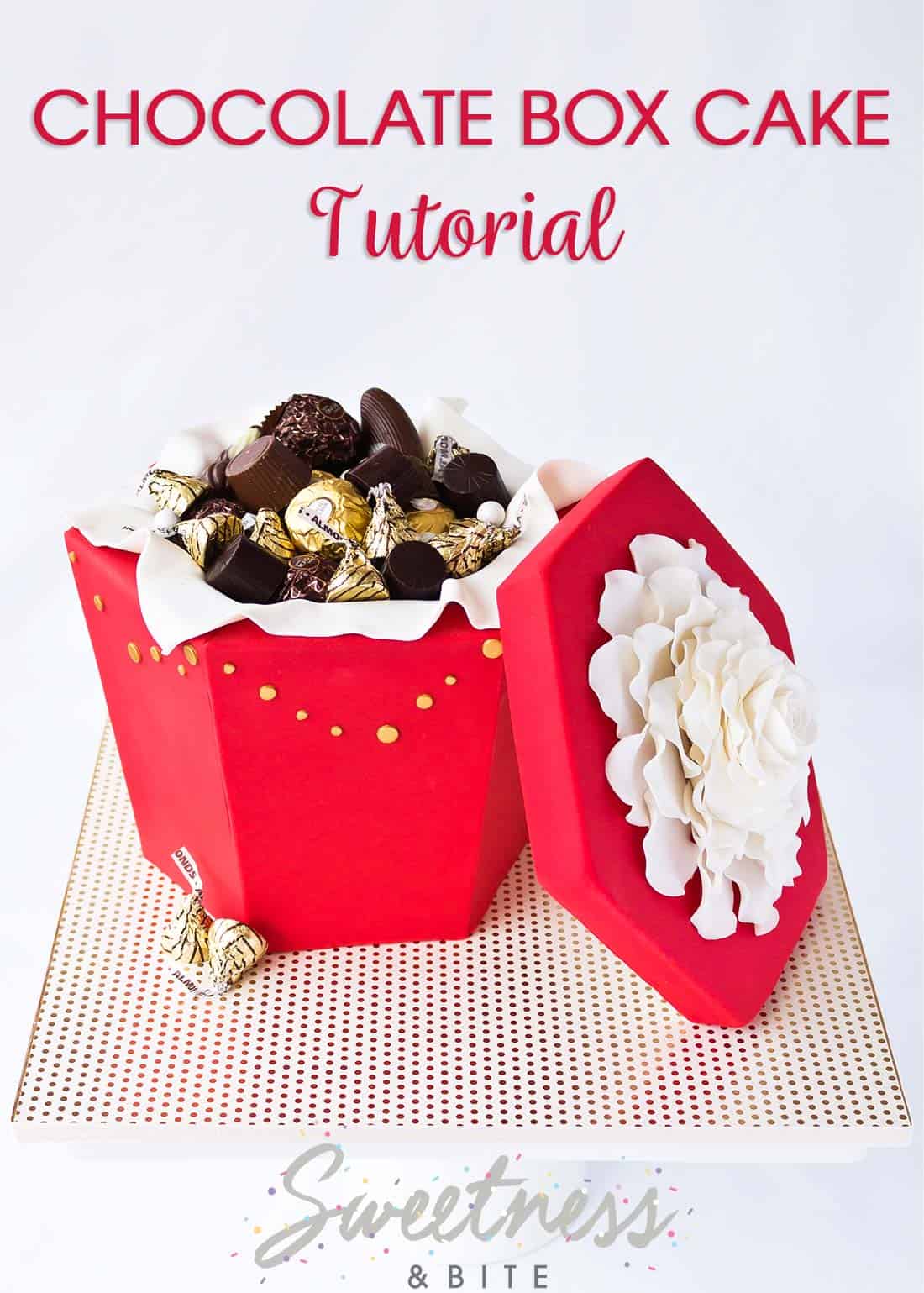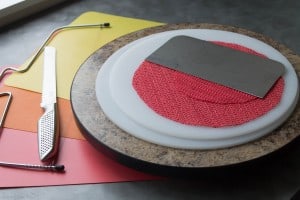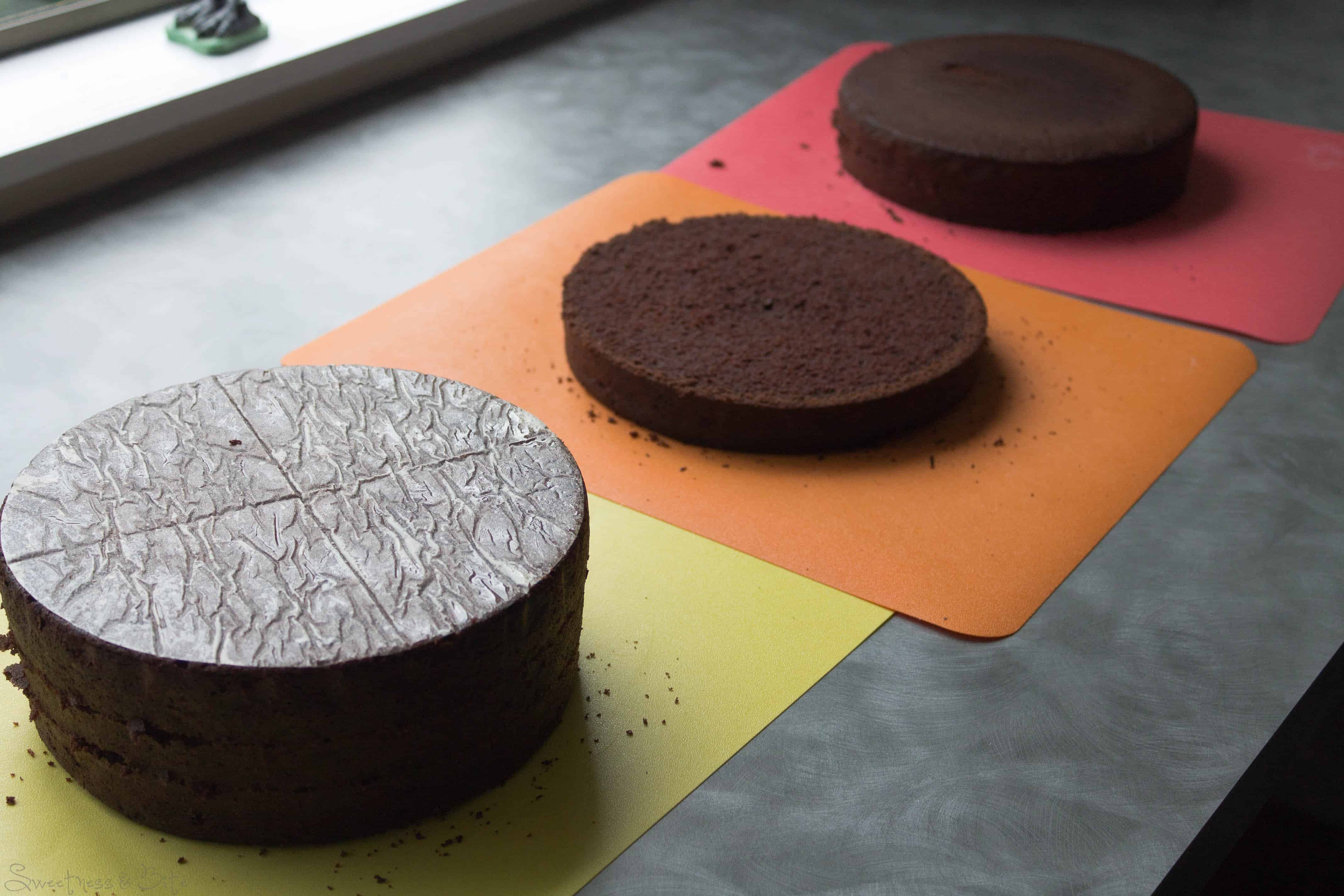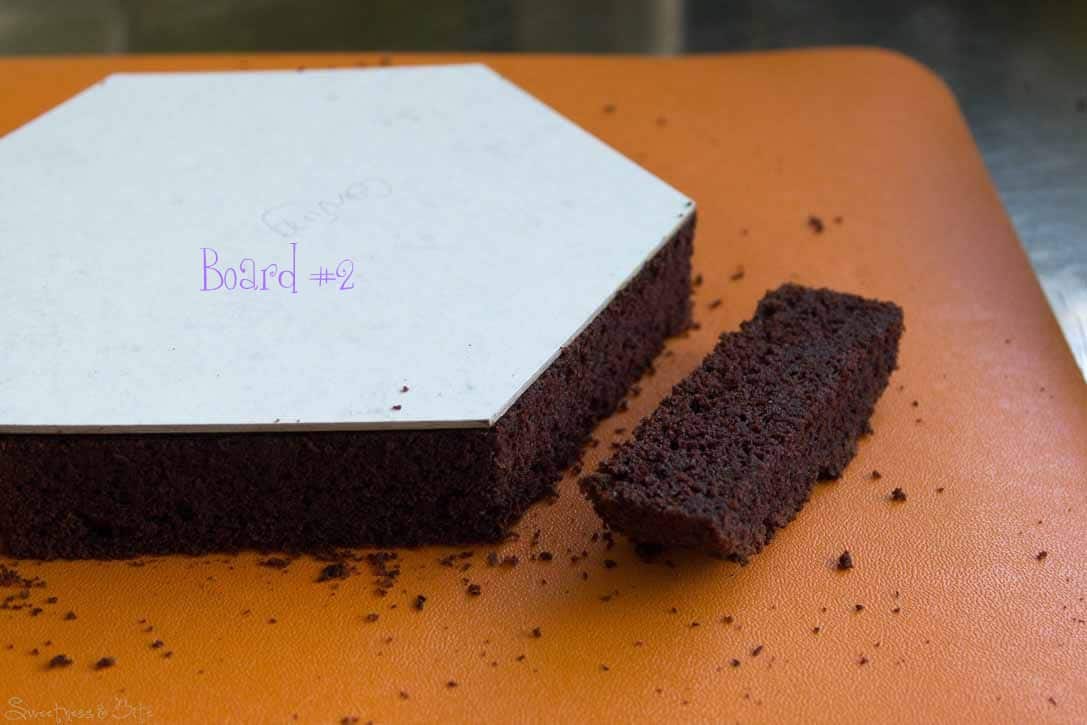Chocolate Box Cake ~ Tutorial
This post may contain affiliate links to products I recommend. I receive a small commission at no cost to you if you make a purchase using my link.
Last week it was my best friend Katie’s mum’s birthday. I don’t usually do fondant cakes for family birthdays (‘cept the major birthdays, of course), usually we all just prefer buttercream or cream filled cakes. However, since Katie’s parents also happen to have been our next door neighbours for 22 years but are moving out this week (*insert massive sad-face here*), I decided to make Margaret a special cake for her birthday. Just to remind them that their new neighbours probably won’t provide them with awesome baking like I do (does that sound up myself? Just sayin’, y’know, they probably won’t…) Or sneak along the hallway, semi-dressed and hoping for the best, since they can see right up our hallway from their front door if they happen to accidentally look. Actually, they probably won’t miss that… but the baking, maybe….
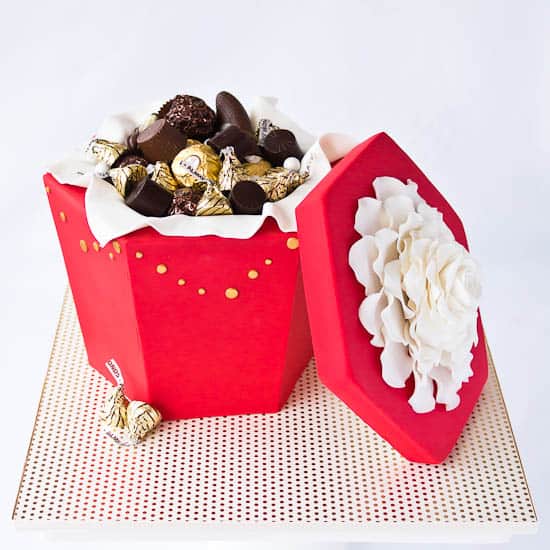
I based this cake on one filled with lollies that I made last year for a friend of mine, and I wanted to share it here because it’s such a versatile cake. Who wouldn’t love a cake filled with sweets or chocolate?! {“Someone on a diet” you say? Well don’t say it, I hate being wrong…) The colour scheme, lid decoration and choice of fillers can be changed however you like. It doesn’t have to be girly, you could totally bloke it up for a man. And you can change the shape, too; the first one I made was a square, but I wanted to change it up for this cake so I went with a hexagon shape, and tapered the bottom slightly for a more elegant look. If you want to make a square or round cake, just follow the instructions using square or round boards. If you don’t want the taper, use boards that are all the same size.
I’ve tried to break down the instructions into sections, with the bits and pieces you’ll need listed at the start of each section. Best to read right the way through before you start. If you need to brush up on your ganache skills, check out my ganache tutorial.
After writing all out all of the instructions, I’ve realised that I am quite… wordy (ahem, bossy) I apologise for that, I can’t help it, I must like telling people what to do or something. I’m making it worse now, so we’ll just get on with it, shall we?
*
Hexagon Chocolate Box Cake
{Cutting the Boards}
What you need: (For a hexagon cake)
~ 4 round cake boards – two that are the same size as your round cake, and two that are 2” smaller
~ Compass
~ Ruler
~ Pencil
~ Craft knife and cutting board
Check out this page on how to draw a hexagon. I’ve written in out in my own words below, but the pictures in the link are super helpful. (Instead of drawing a circle like in the article, you’ll be doing the steps using the round cake board)
Grab one of your larger round cake boards, and find the very centre. Place the needle of the compass on your centre mark and stretch the pencil end out to the edge of the board. Without altering the distance between the needle and the pencil, place both ends against the edge of the board. Use the pencil to make a mark on the edge of the board. Now, again without adjusting the compass, place the needle end on the mark you just made, and mark the board again. Continue doing this the whole way around, until you have 6 evenly spaced marks.
If you find they’re not evenly spaced, then either you’ve accidentally moved the compass, or your board isn’t completely round, so you’ll need to adjust things until the marks are as evenly spaced as you can get. Unless you’re making the cake for a geometry teacher, don’t worry too much if one section is slightly larger than the others.
Take your ruler and draw a line from one mark to the next, all the way around to get the hexagon shape. Use the ruler and craft knife to cut out the hexagon. We’ll call this board #1, and this the board you will use as a guide when you ganache the cake.
Now grab your other larger board, and draw around the hexagon board onto the round board (this just saves going through the compass process again). Use the ruler to measure in approximately 5mm/ ¼” the whole way around the hexagon, to make a smaller hexagon, and cut this out. This is board #2, and will be one of your carving guide boards. We want this smaller board for carving so you know you’ll get a good 5mm thick layer of ganache around the cake to help support it. Wipe the boards with a little vodka or cake decorator’s alcohol to clean the edges.
Follow these same steps with the smaller two round cake boards, making the hexagon shape (board #3), and then the smaller hexagon (board #4). Board #3 will be the final board that your cake stays on, and board #4 is your second carving guide board. Still with me?
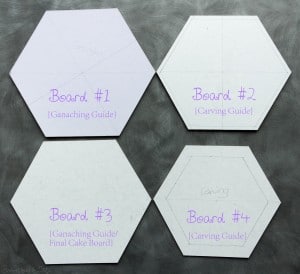
(Ignore the extra pencil marks on my boards, they were experimental lines)
Onto a piece of baking paper, trace around boards #2 and #3 and cut them both out. Trace around board #1 onto two pieces of thick paper or thin cardboard and cut them out.
*
{Carving The Cake}
While you’re carving and ganaching the cake, it may help to remember that you’re basically making the cake upside down. With the taper it is much easier to work with the larger side (what will be the top) on the bottom. If you’ve decided against tapering your cake, then you can ignore the section on carving the cake and go straight to the ganaching. And if you’re not tapering the cake, you can ganache it right side up.
What You Need:
~ Cutting boards
~ Cake leveller or knife
~ Turntable
~ 2 ganaching boards/large cake boards
~ Non-slip mat
~ Sharp, long, non-flexible serrated knife (a sturdy bread knife is good)
~ Short, pointy serrated knife
~ Spatula (straight or off-set, whichever you’re comfortable with)
~ Ganache scraper – your scraper needs to be at least the height of your finished cake, my cake was 6” high and my scraper is 8”
~ Small spirit level
~ Ruler
Cake – Use a sturdy cake that will hold up to carving. Mud cake is ideal, I used gluten free devil’s food cake which isn’t particularly ideal, but since I’m used to working with it, it worked out ok. How high your cake needs to be depends on how high you want your box. I used two cakes that were each 3” high and split them into 3 layers each. I only ended up using 5 layers. Better to have too much cake than too little.
Ganache – Dark, milk or white chocolate ganache, I used dark as it sets the firmest.
*
Split your cakes into even layers, whichever way you prefer. I used a wire cake leveller, and split my two cakes into three layers each. As they were thick layers I only ended up using 5 layers of cake, and I ended up with a finished cake about 6” tall.
Take one layer of cake and place board #2 on top. Cut around the board, trying to keep your knife as straight as possible. Repeat for all your layers of cake.
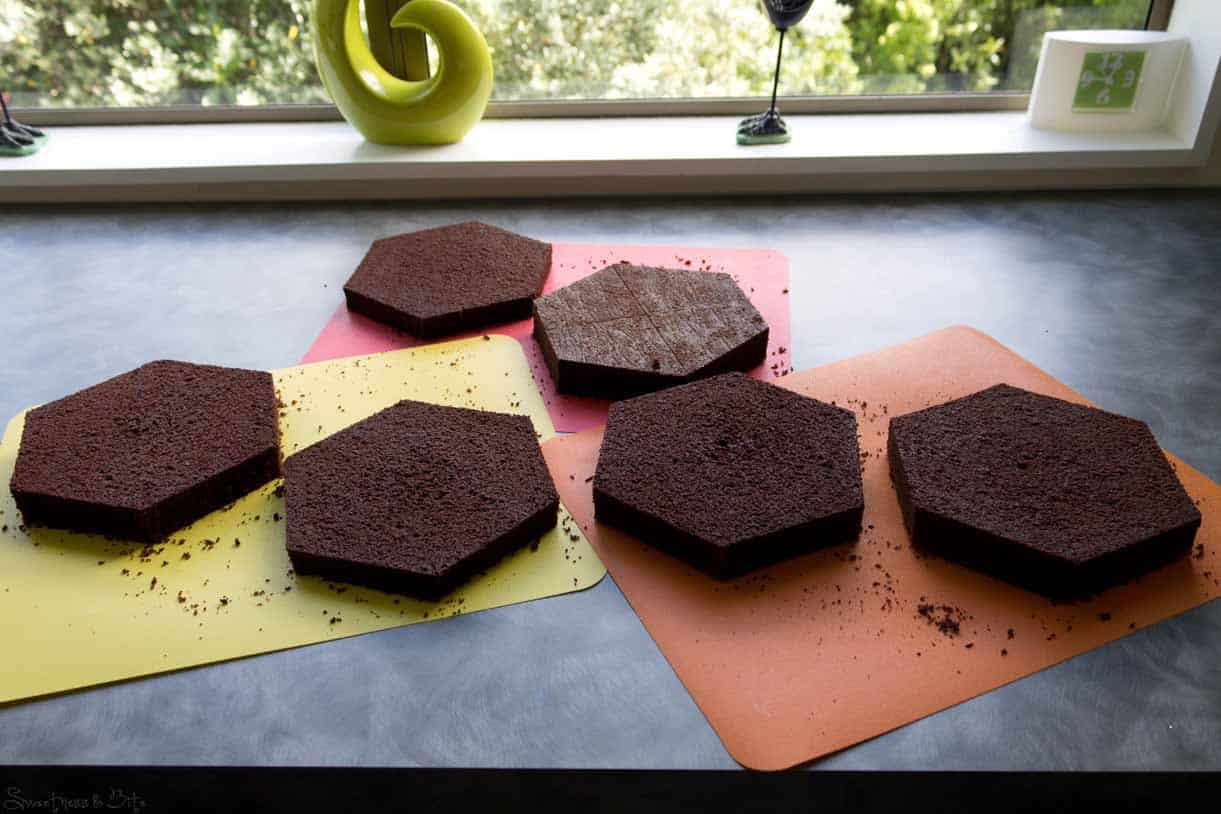
Place a piece of non-slip mat on your turntable, and put your setup board on top. Take the same board that you used above, board #2, and place this on a small piece of non-slip mat on your setup board.
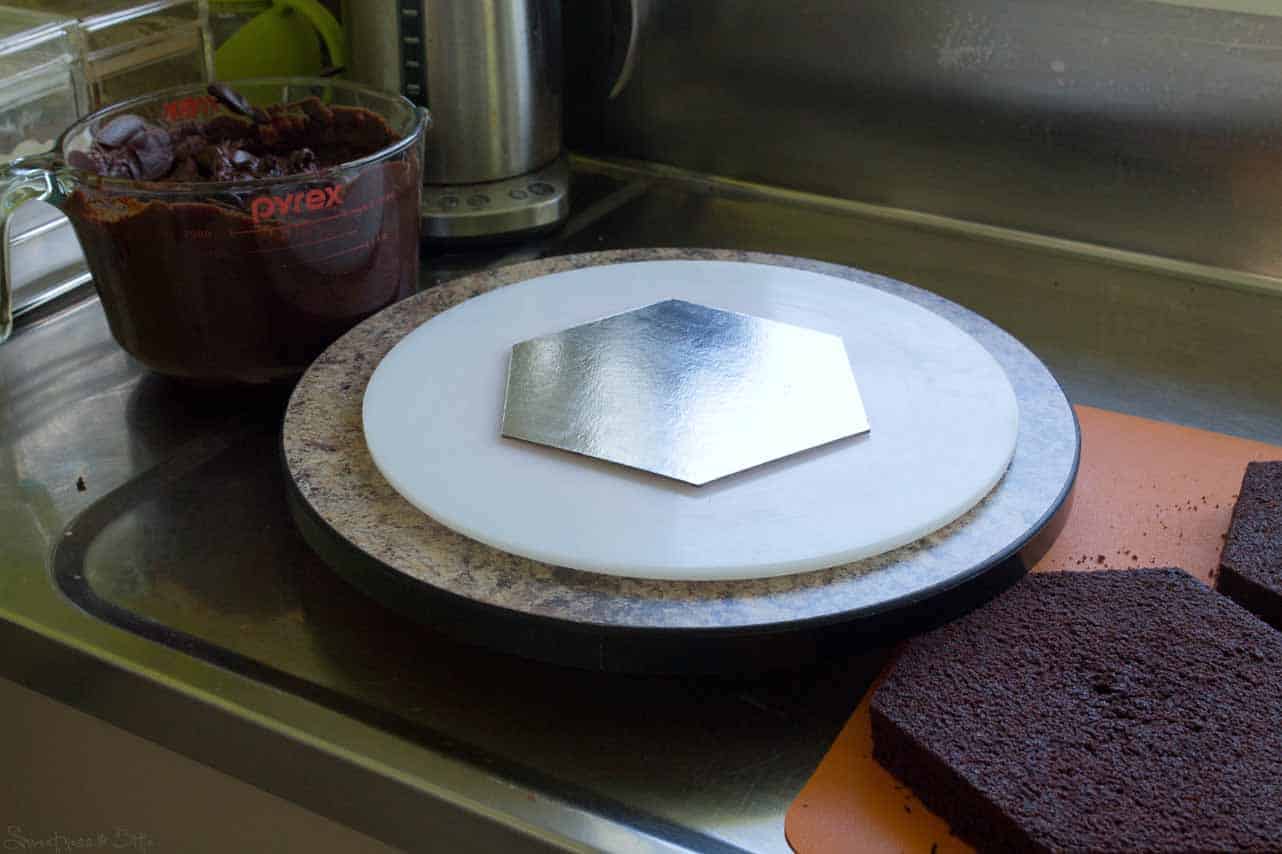
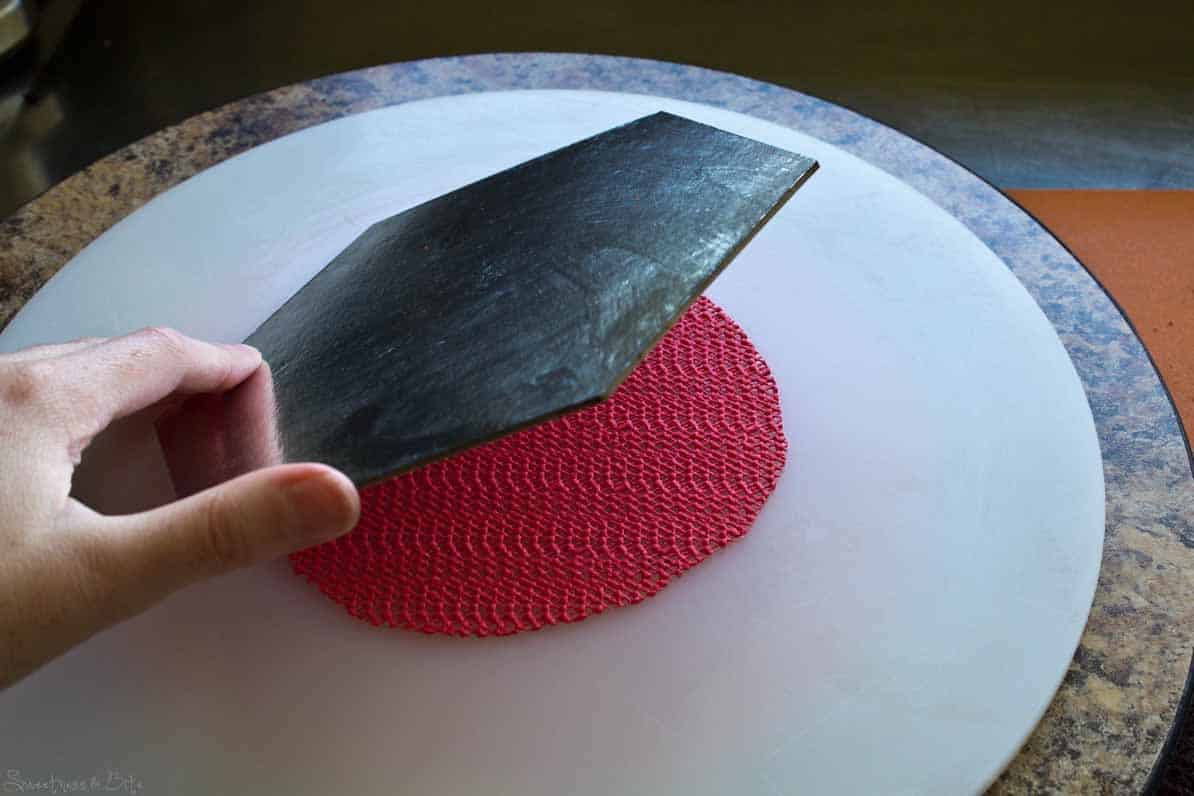
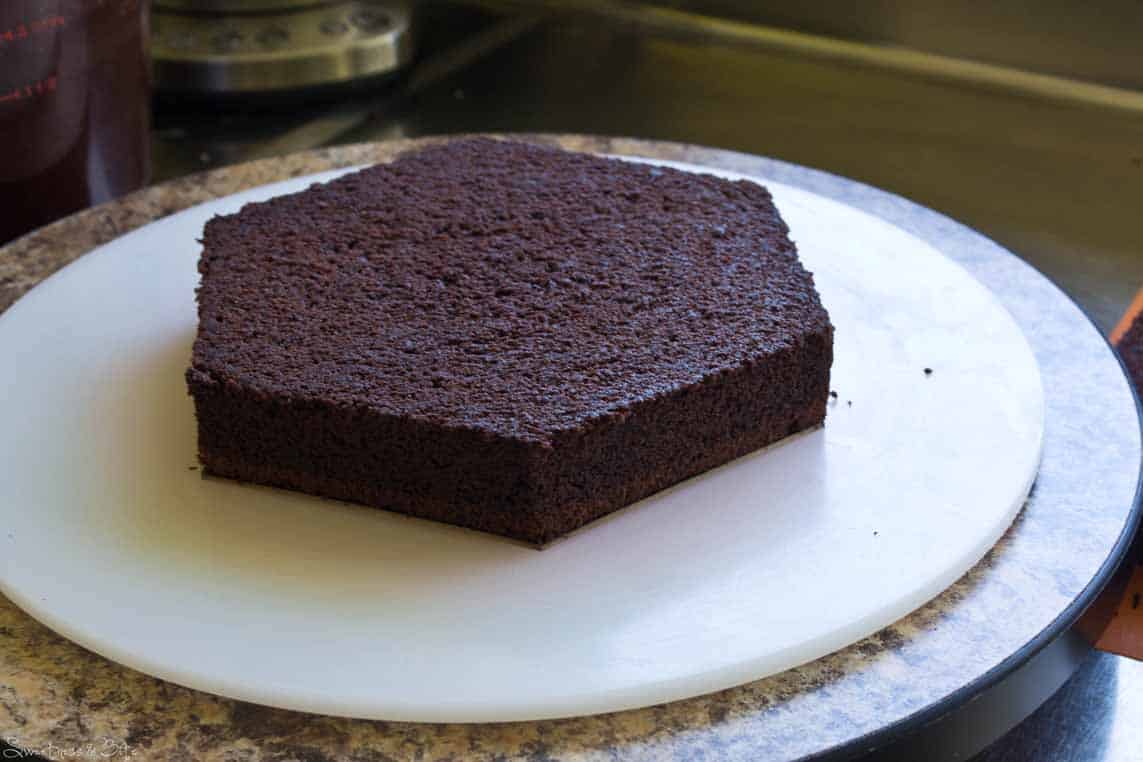
Smear a little ganache on the board and place a layer of cake on top. Set this aside for a minute. Spread an even layer of ganache onto another layer of cake and place the smaller baking paper cut-out onto the ganache. This will help when it comes to cutting out the indent in the cake that you will fill with goodies later. Take your cake layer that is attached to board #2, and flip that piece of cake over and onto the baking paper covered layer.
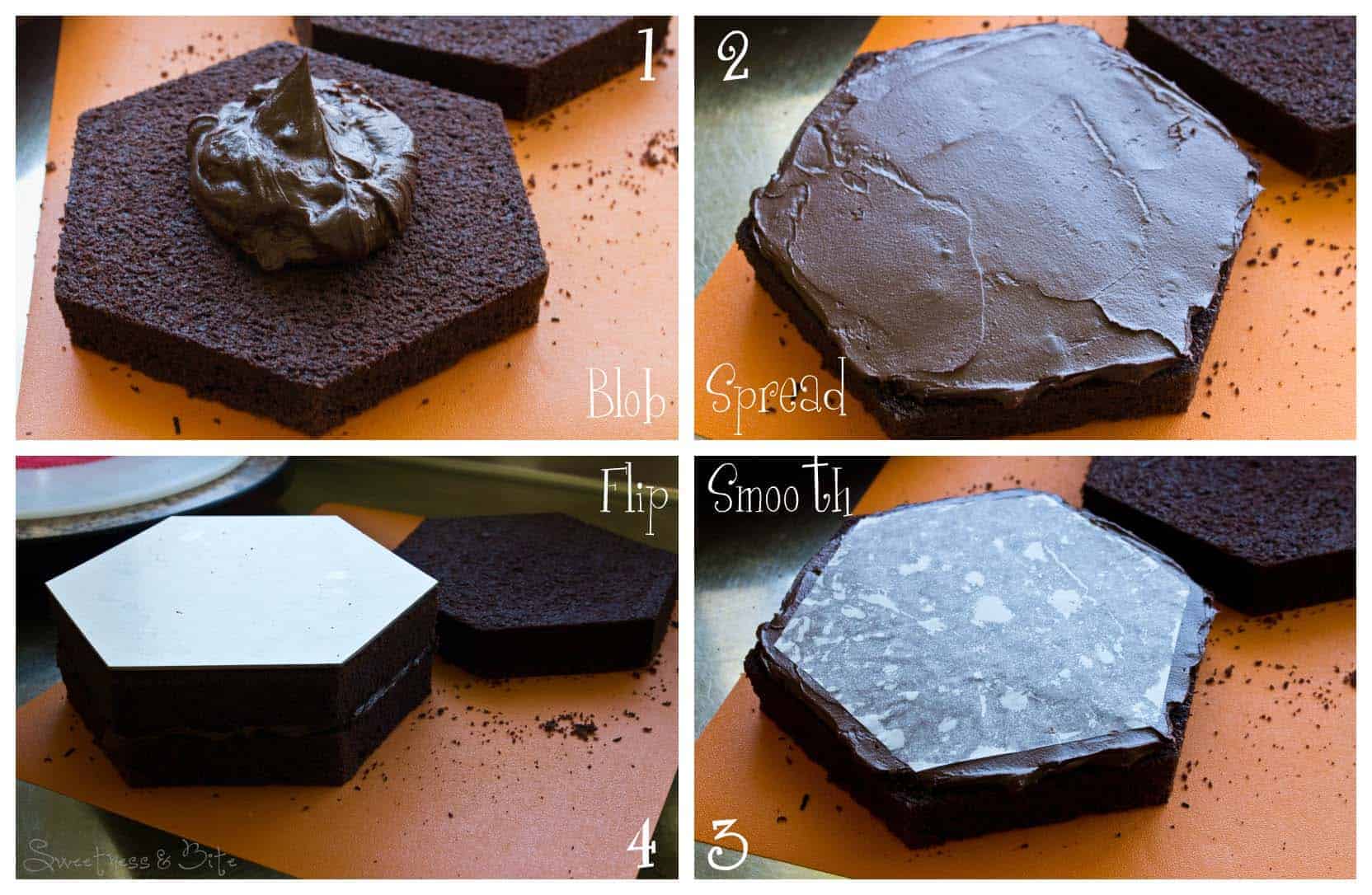
Now flip them both back over, so the board is on the bottom, and place this back on the non-slip mat. Note: I did it this way because I was using gluten free cake that was a little bit fragile. If you’re using mud cake, or another sturdy cake, you should be able to safely flip the baking paper-covered cake layer over and onto the other layer.
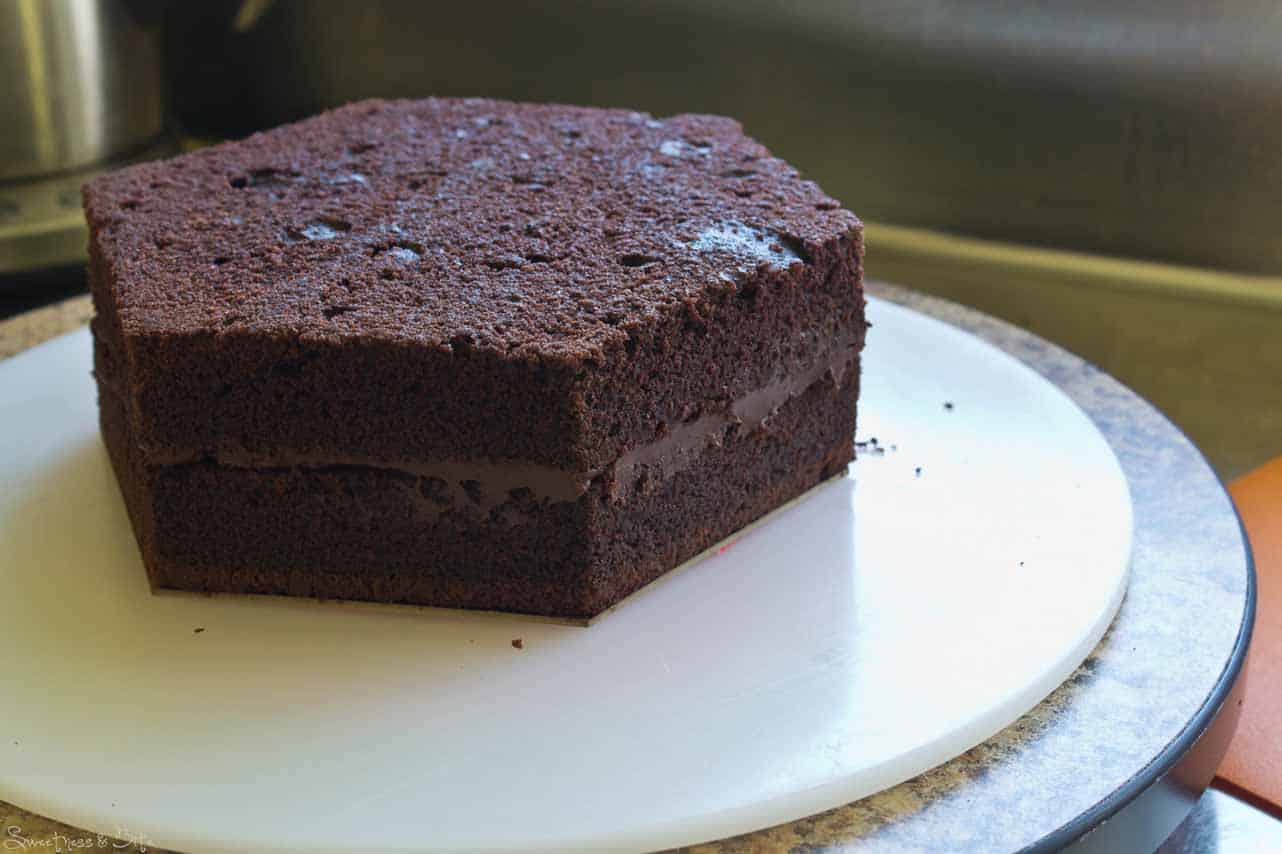
Spread ganache onto the top of the layer, and continue filling and layering up your cake. Be careful to make sure your layers line up.
Smear some ganache into the middle of the top layer of cake, and place board #4 on top. Use your ruler to check the board is centred, and to check that the points of your hexagon line up. Pop the whole cake into the fridge to let the ganache set.
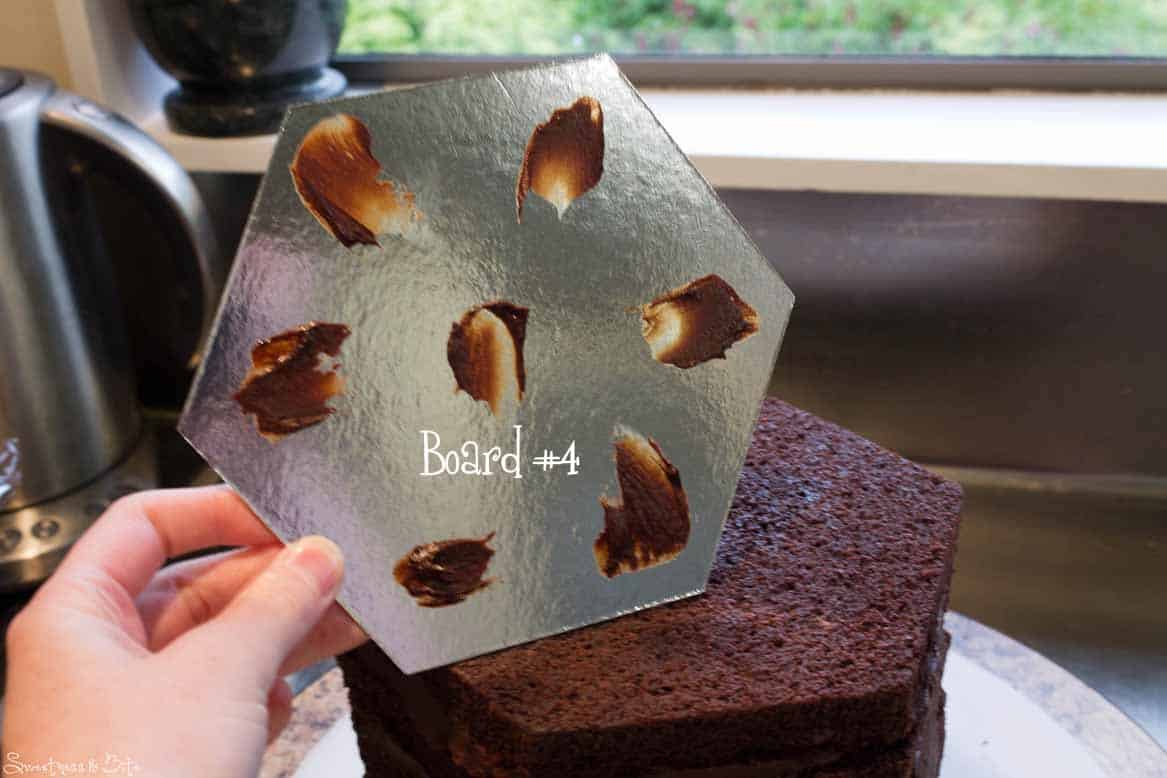
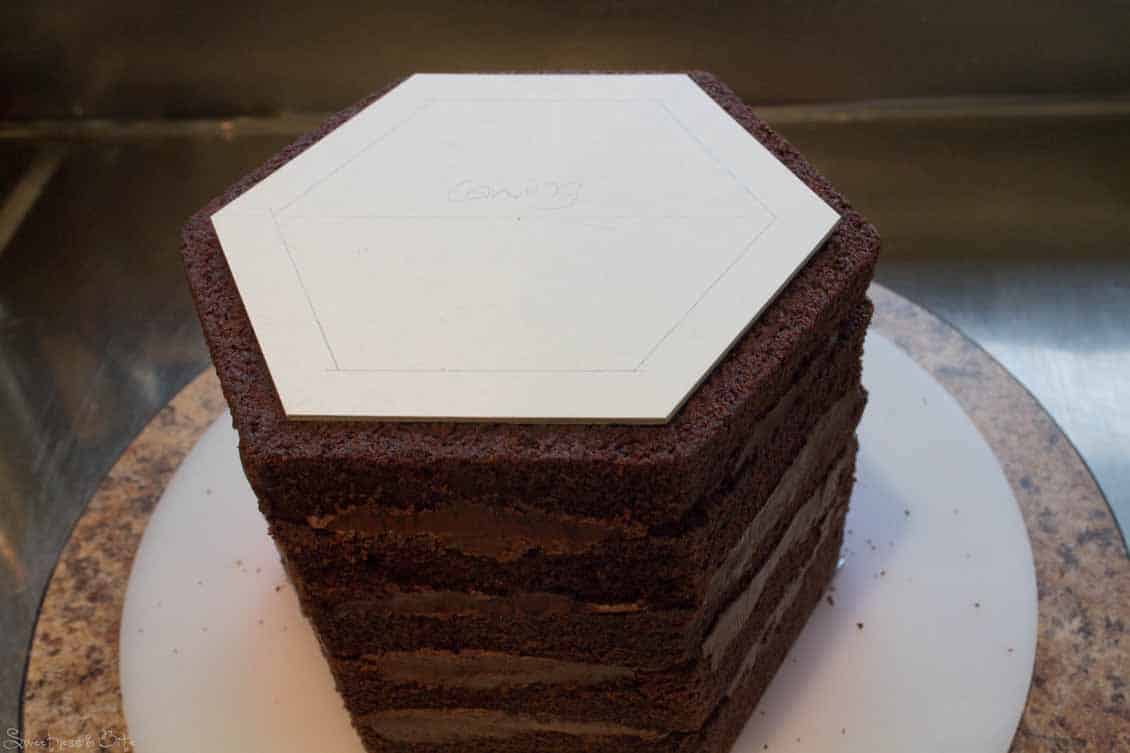
Time to hack at some cake! {You’ll have to excuse my pictures of the carving and ganaching, a big storm came in from the south as I was carving and even with the lights on it got really dark in our south-facing kitchen. I should have gotten out my tripod to avoid blurry, grainy pictures but, well, I didn’t. Anywho…}
If you’re not confident at carving cakes, then it’s fine to start with baby steps. Cut around each side of the hexagon, aiming your knife out at a slight angle. Cut down gradually, and check your progress by leaning the knife against the cake. You’re aiming to be able to touch the knife to both boards at once.
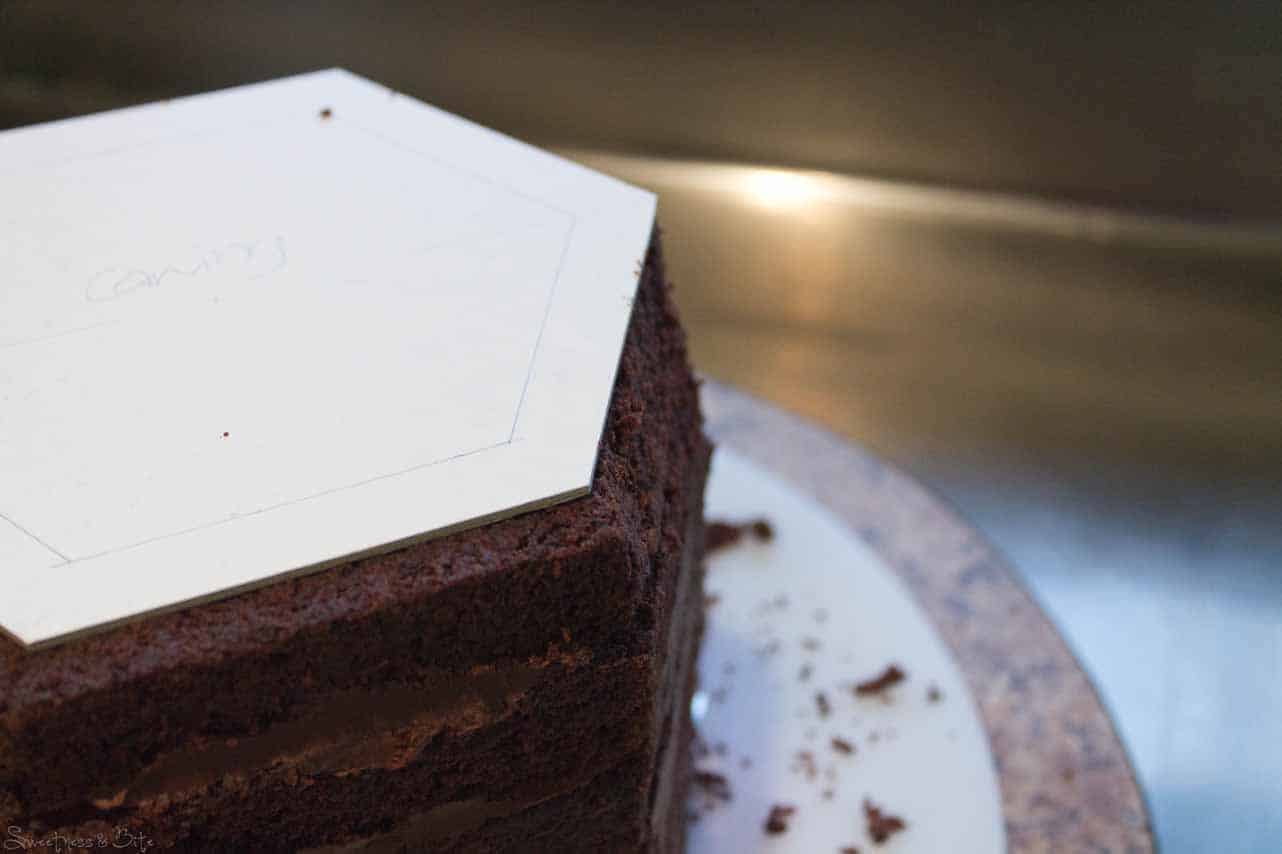
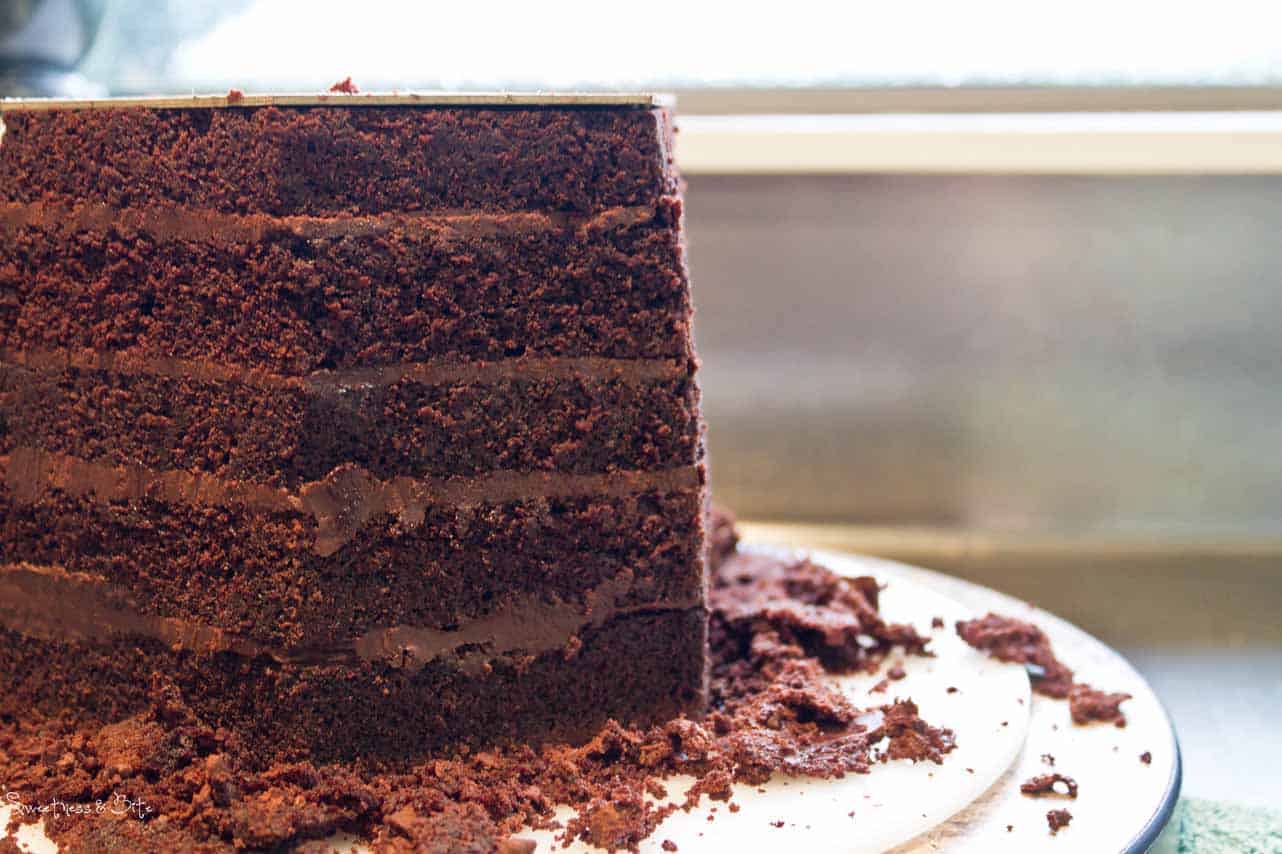
Once you’ve cut most of the cake away, start scraping away the last bits of cake, with your knife pressed up against both boards.
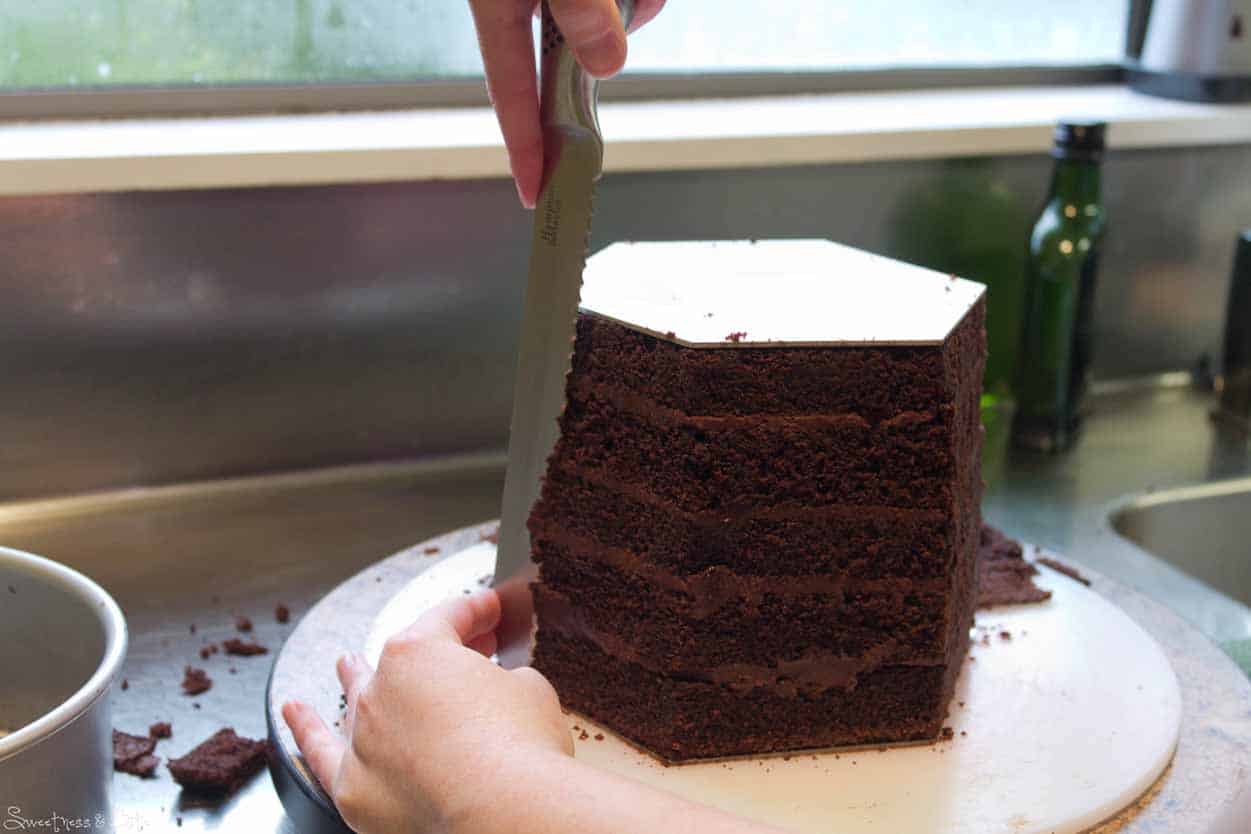
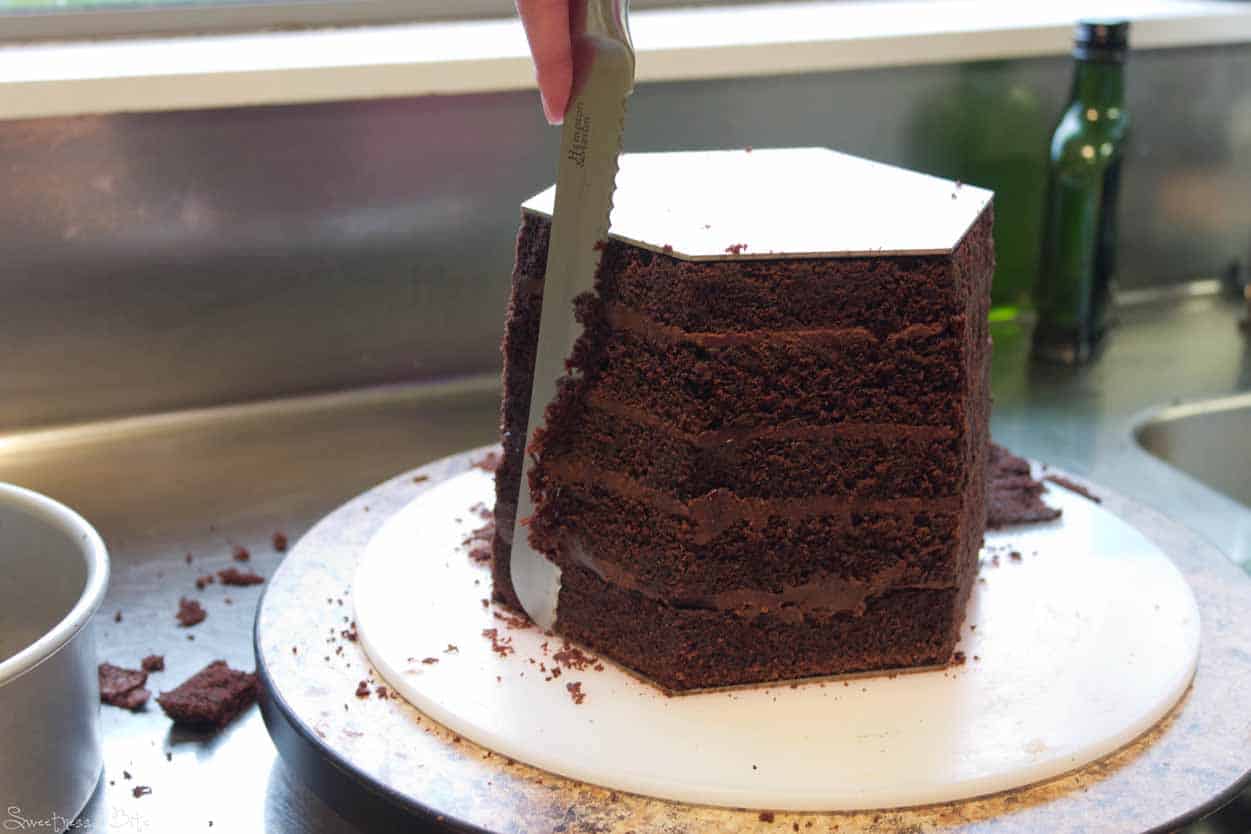
When you do the corners, you need to come at them from one side and then the other. Aim to drag the knife past the corner, sawing gently up and down, to prevent pulling any chunks of cake away. If you do accidentally take a chunk out then it’s no big deal, you can fill it with ganache, but if you take out too much it can make the edges less stable and harder to ganache sharply.
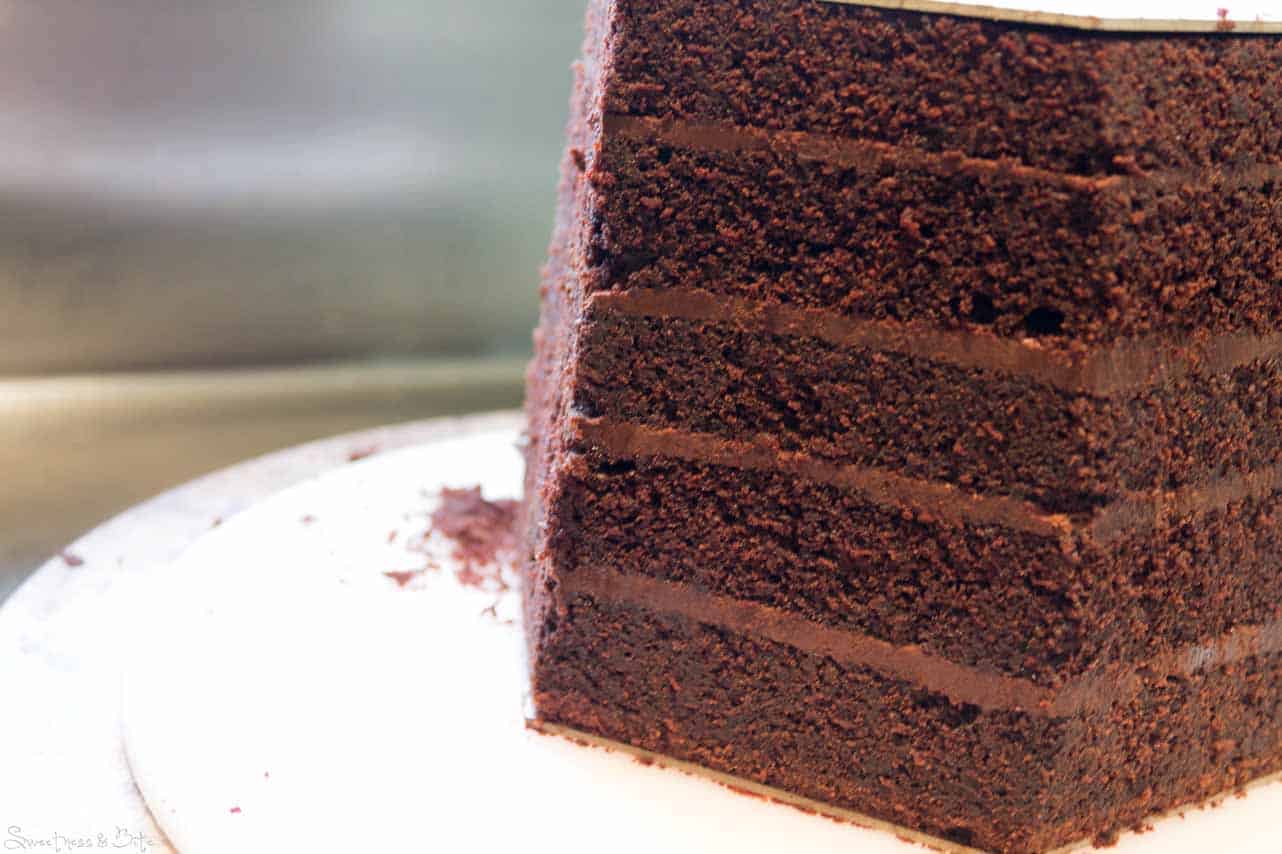
Keep scraping the cake away until the sides are straight and the corners are reasonably sharp and smooth. That totally makes sense.
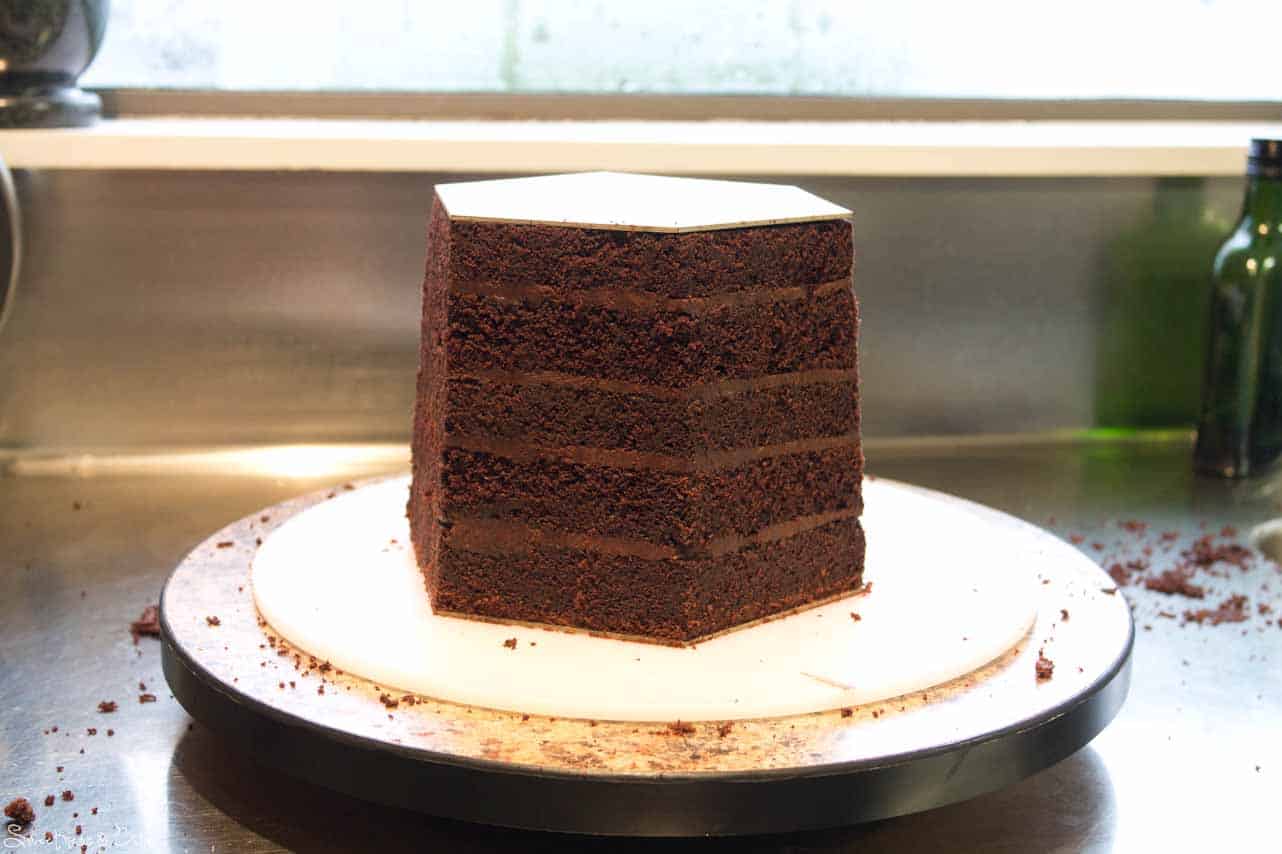
Now, you may notice in my pictures than there doesn’t seem to be much of a taper to the cake. That’s because I started with smaller boards that were only 1″ smaller, which means a taper of only ½” on each side. After flipping it over to check, I decided I wanted more taper so I cut myself some more boards that were 2” smaller, and carved the cake again.
Once your cake is smooth all the way around, and you can see the edges of the boards, it’s time to ganache. Using a spatula, carefully lift off the top cake board (board #4). Replace it with board #3, sticking with some ganache.
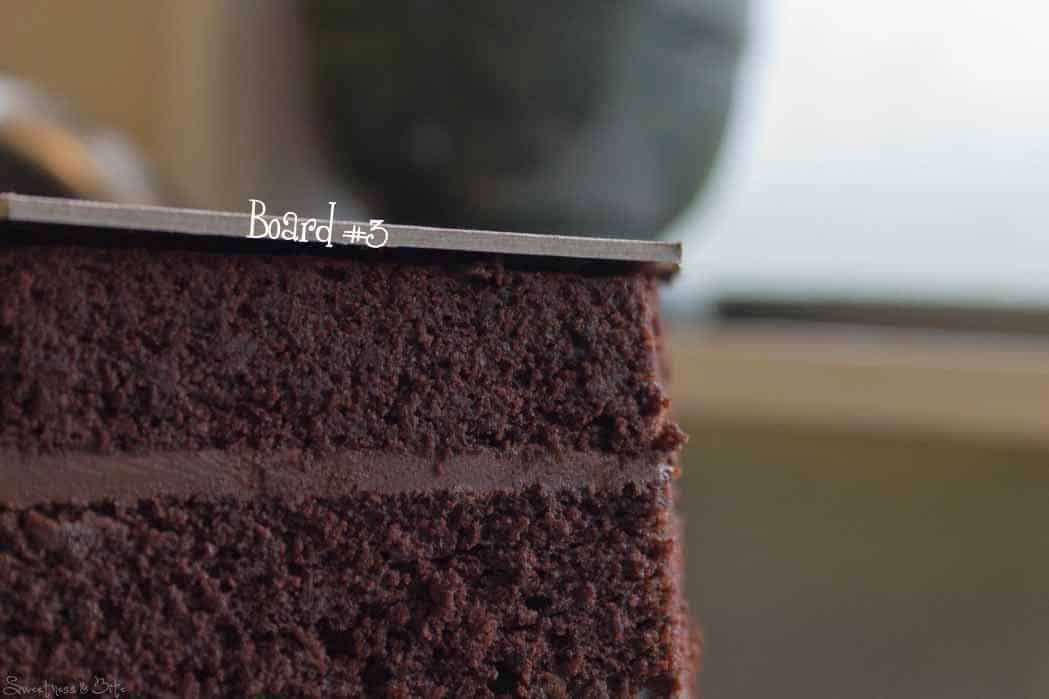
Flip the whole cake over, and remove the bigger board. Take board #1 and use dabs of ganache to attach the bigger piece of baking paper that you cut out earlier.
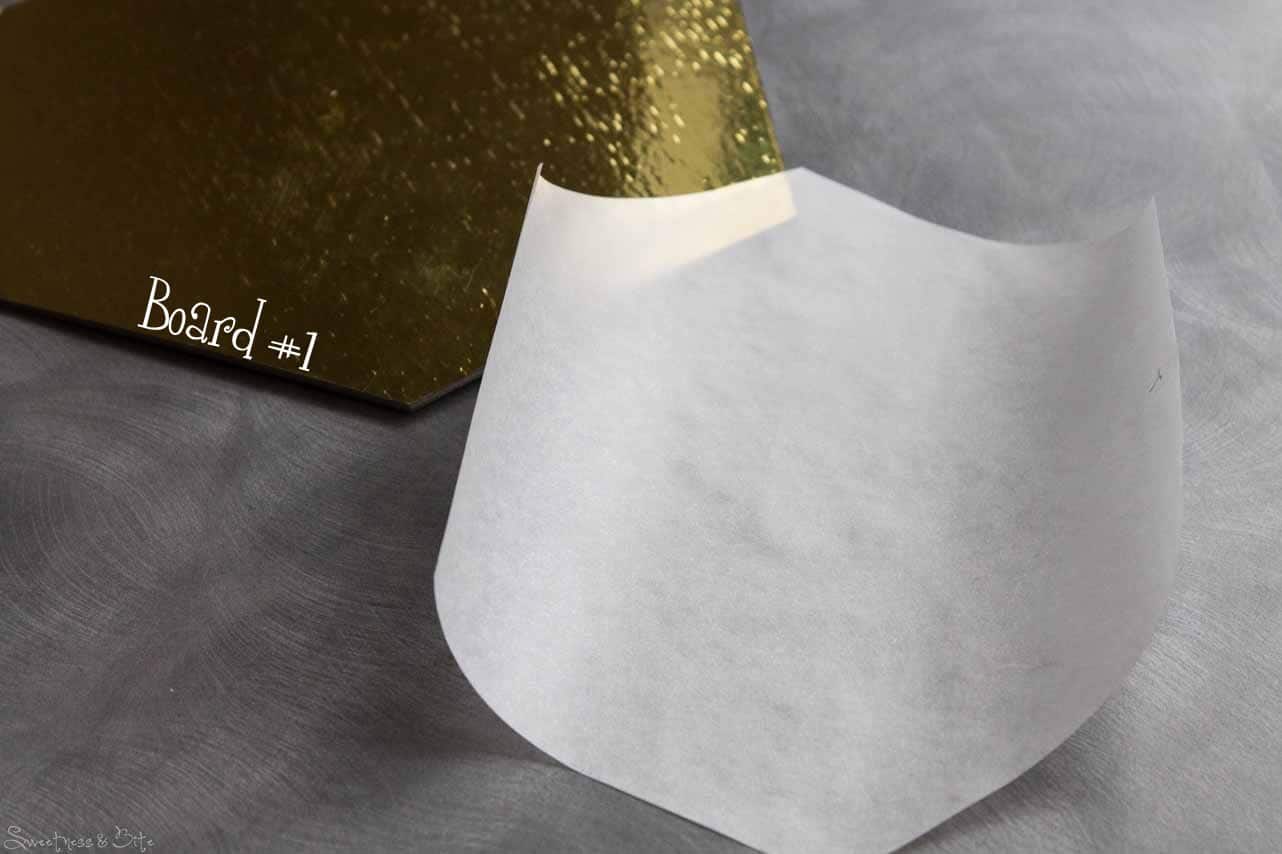
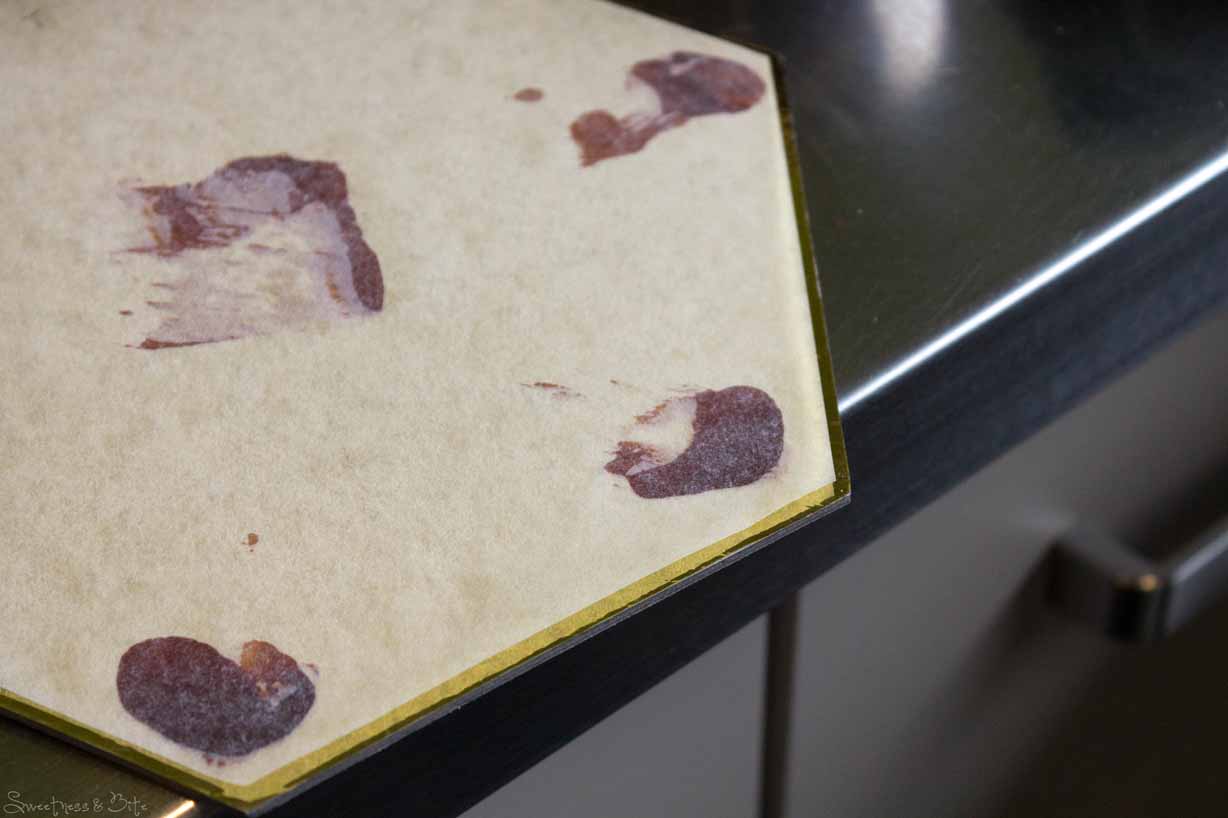
Dab some more ganache on top, flip the board over and attach it to the cake. Make sure the boards are centred, with an even amount of board showing the whole way around. Flip the cake over again, so the smaller side is back on top again.
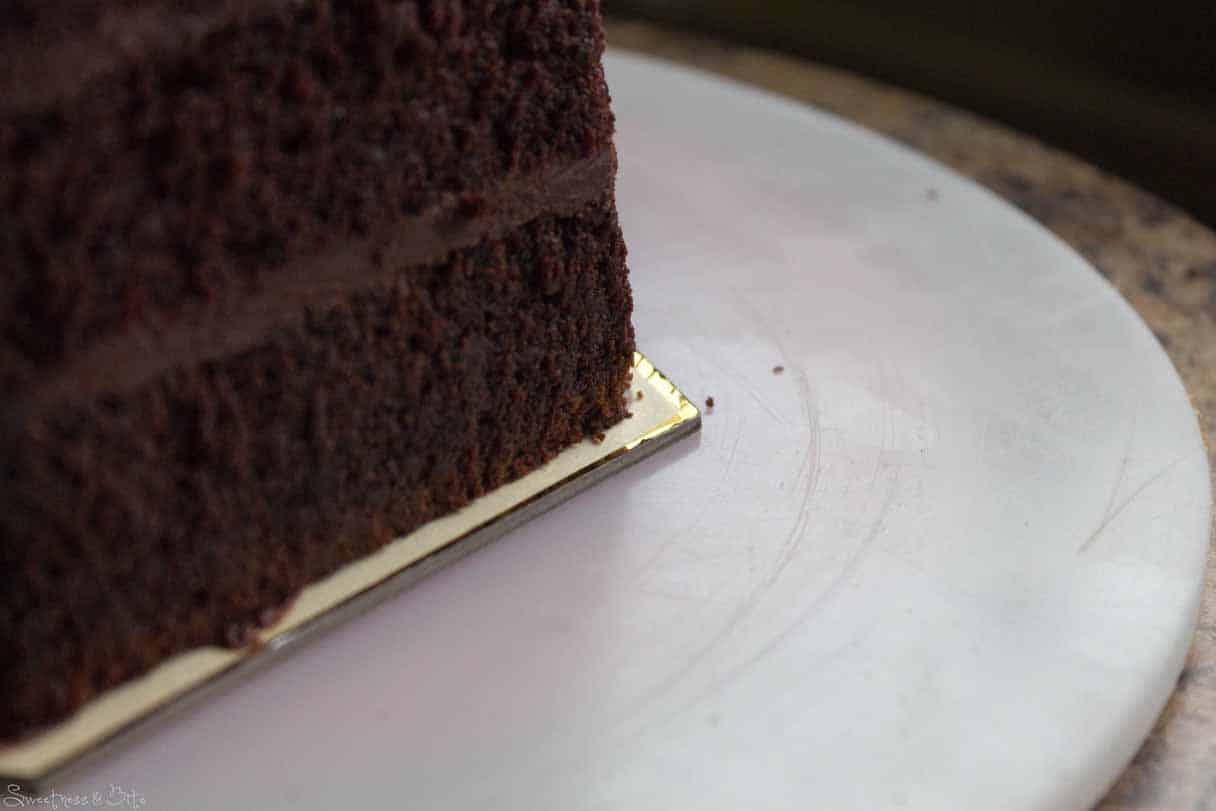
{Ganaching the Cake}
You can ganache the cake whichever way you prefer; this is just the way I do it. Ganaching a hexagon is a lot like ganaching a square cake {which I’m actually not very good at, but surprisingly this one came out ok} I start by smearing a thinner layer of ganache to seal the crumbs in, then spread a thicker layer on and scrape the excess off with the scraper pressed up against the two boards. Rinse the scraper under hot water and dry between scraping. To get sharp corners, scrape in one direction, smoothly taking your scraper past the corner. Then repeat in the other direction for the same corner. If the ganache is too soft and just smooshes (technical term) pop the cake in the fridge for a couple of minutes to firm the ganache up, then continue.
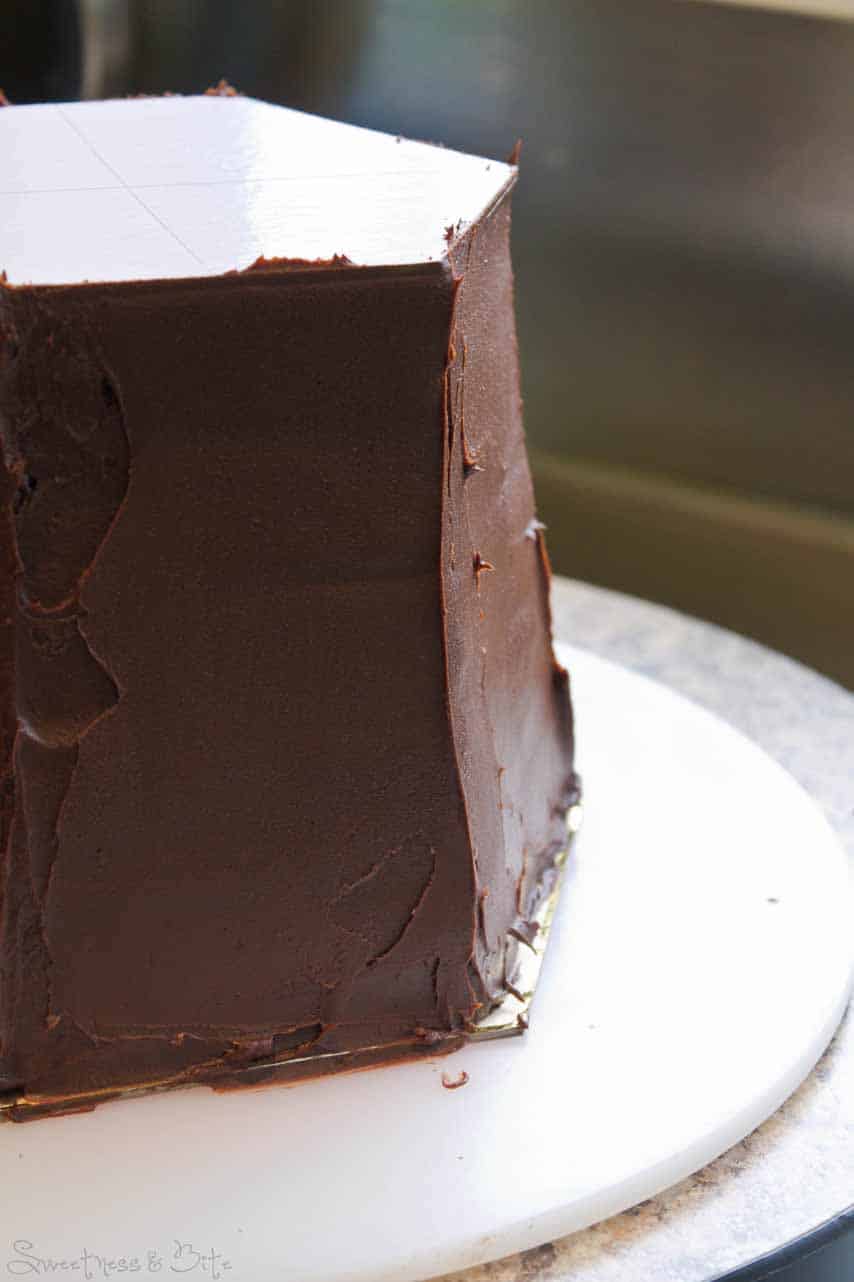
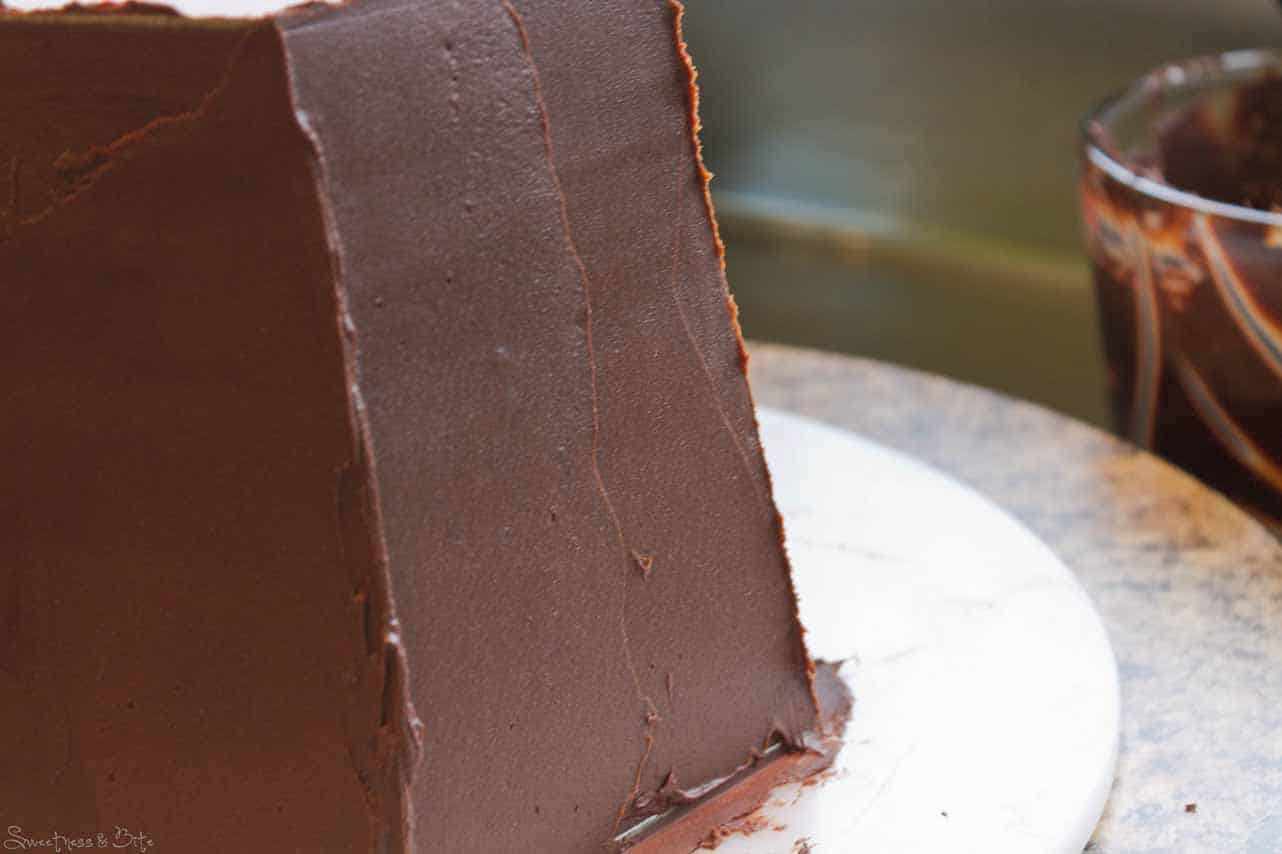
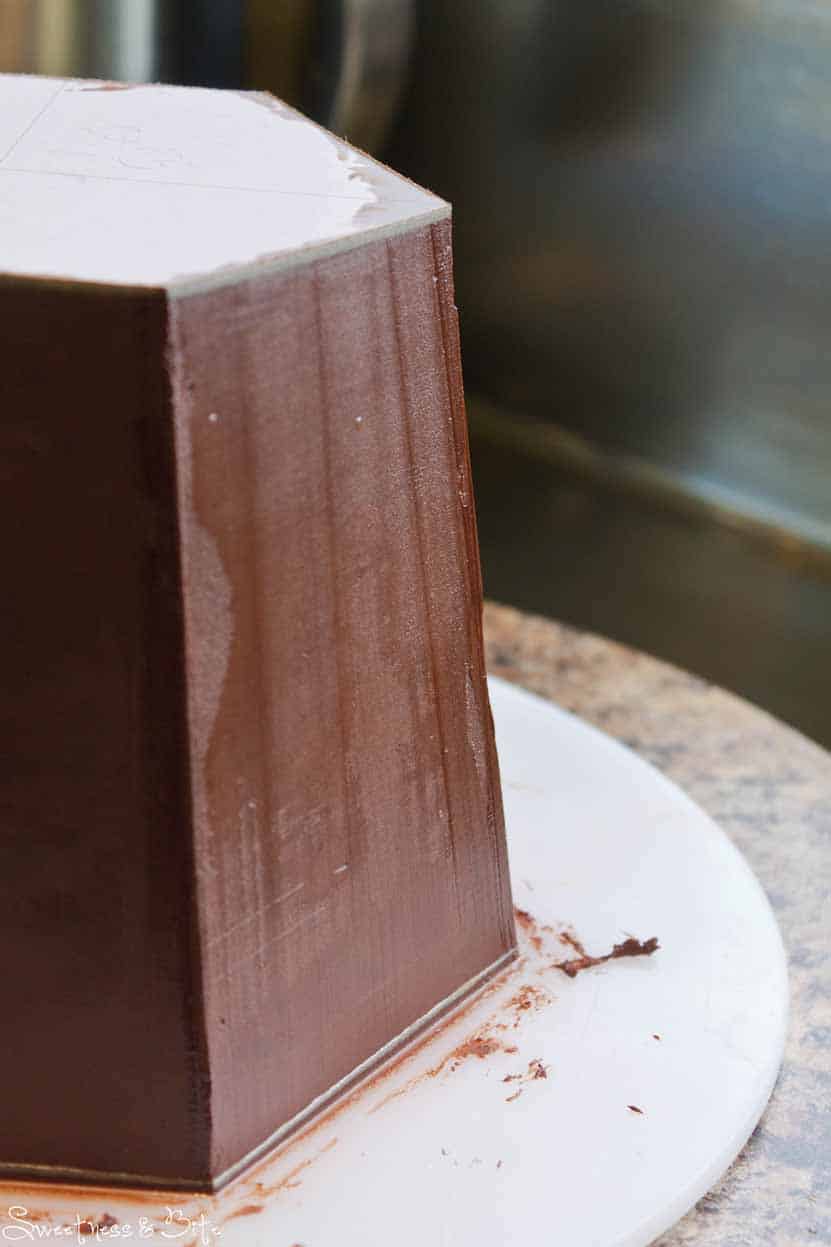
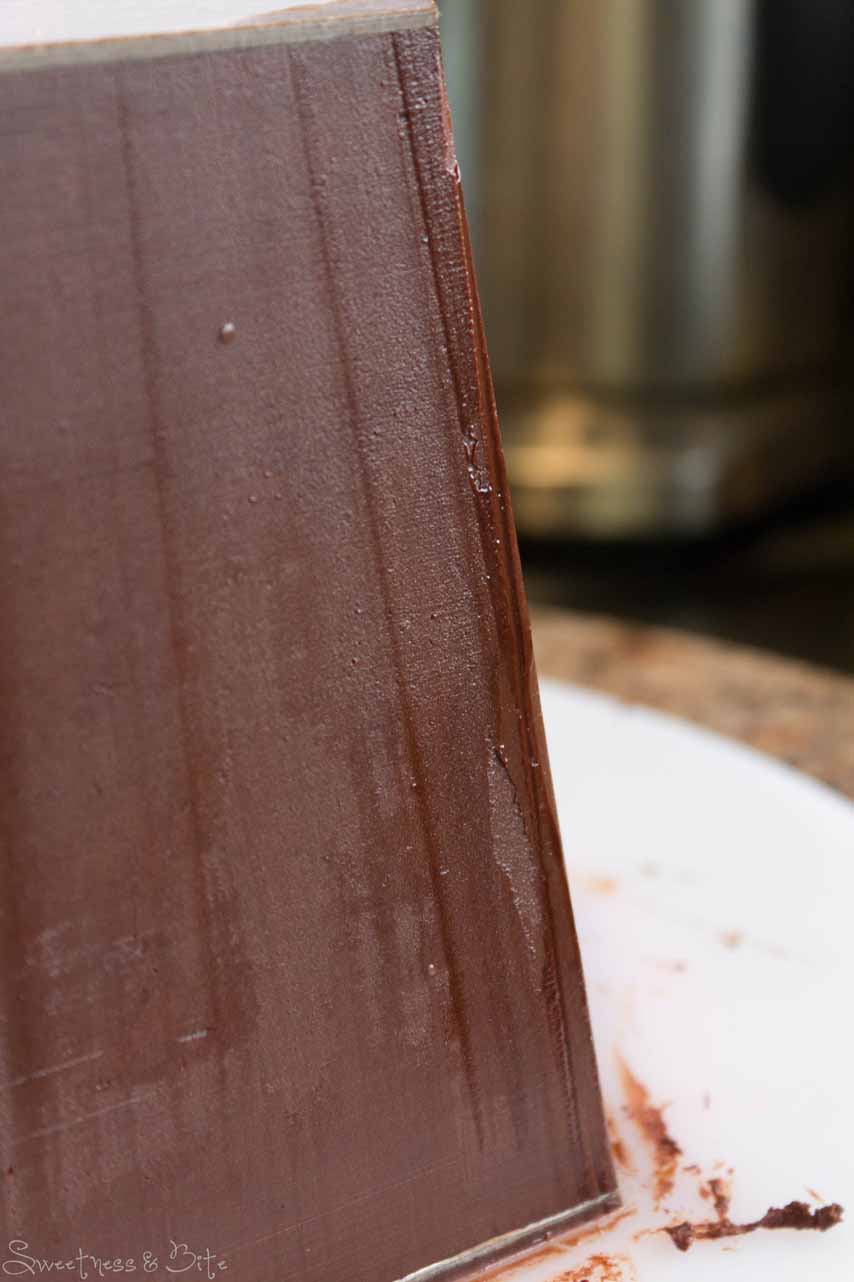
See the corner is still a little rough? I chilled it for a few minutes, then used my scraper again to smooth up to the corners.
Continue until the sides of the cake are smooth, and the corners are as sharp as you want them. Put the cake into the fridge until the sides have set firm.
Flip the cake over onto another setup board with a piece of non-slip mat on it. Gently run a warm metal spatula around under the board (#1) and flick it off. If the baking paper doesn’t come off with the board, then gently peel it off. Spread ganache over the top of the cake and smooth it as best you can, making sure the ganache goes past the edge. Place a square piece of baking paper over the ganache and smooth the paper down and remove most of the air bubbles (I sometimes use a fondant smoother to do this).
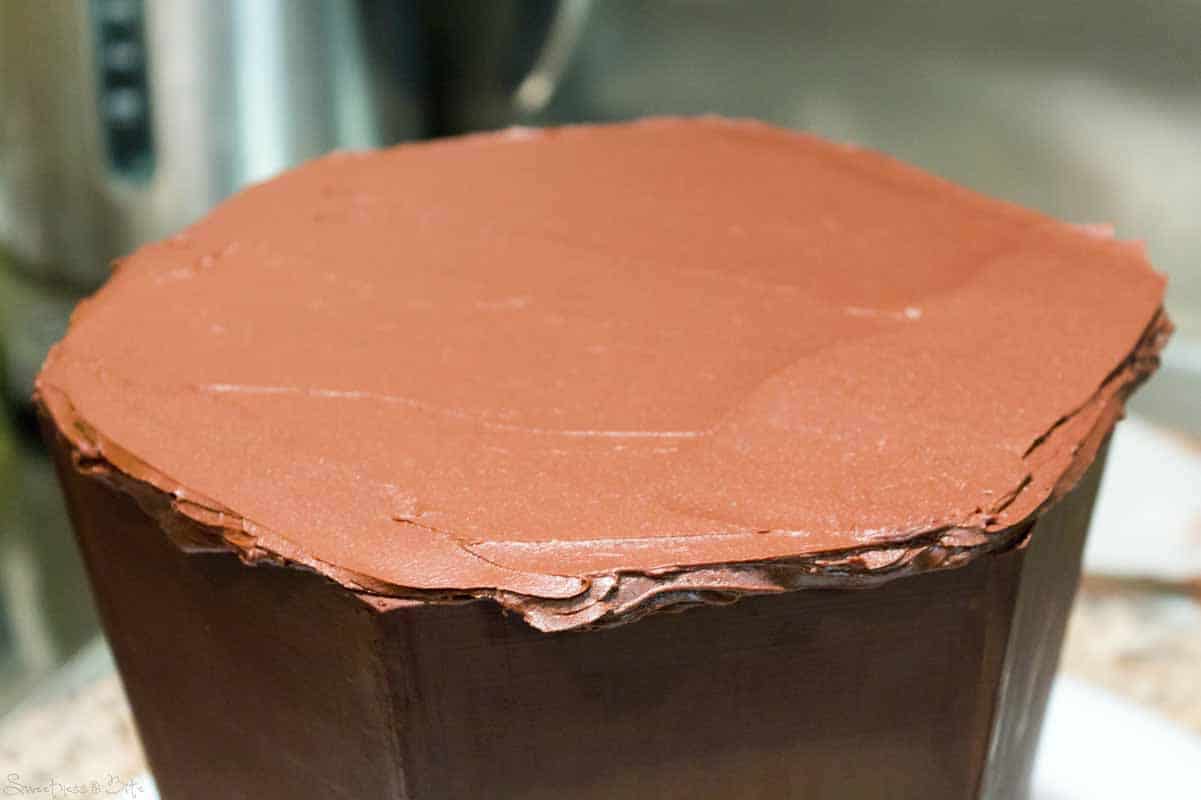
Place the first setup board on top of the paper, and flip the cake over. Place a level on the cake, and press down gently until the cake is level. Use your scraper, pressed gently against the cake, to scrape away the ganache that has been squeezed out. Add more ganache to any bits that haven’t had the ganache squeeze out enough. Make sure you don’t angle the scraper inwards when you do this, or you will lose the straight top edge of your cake.
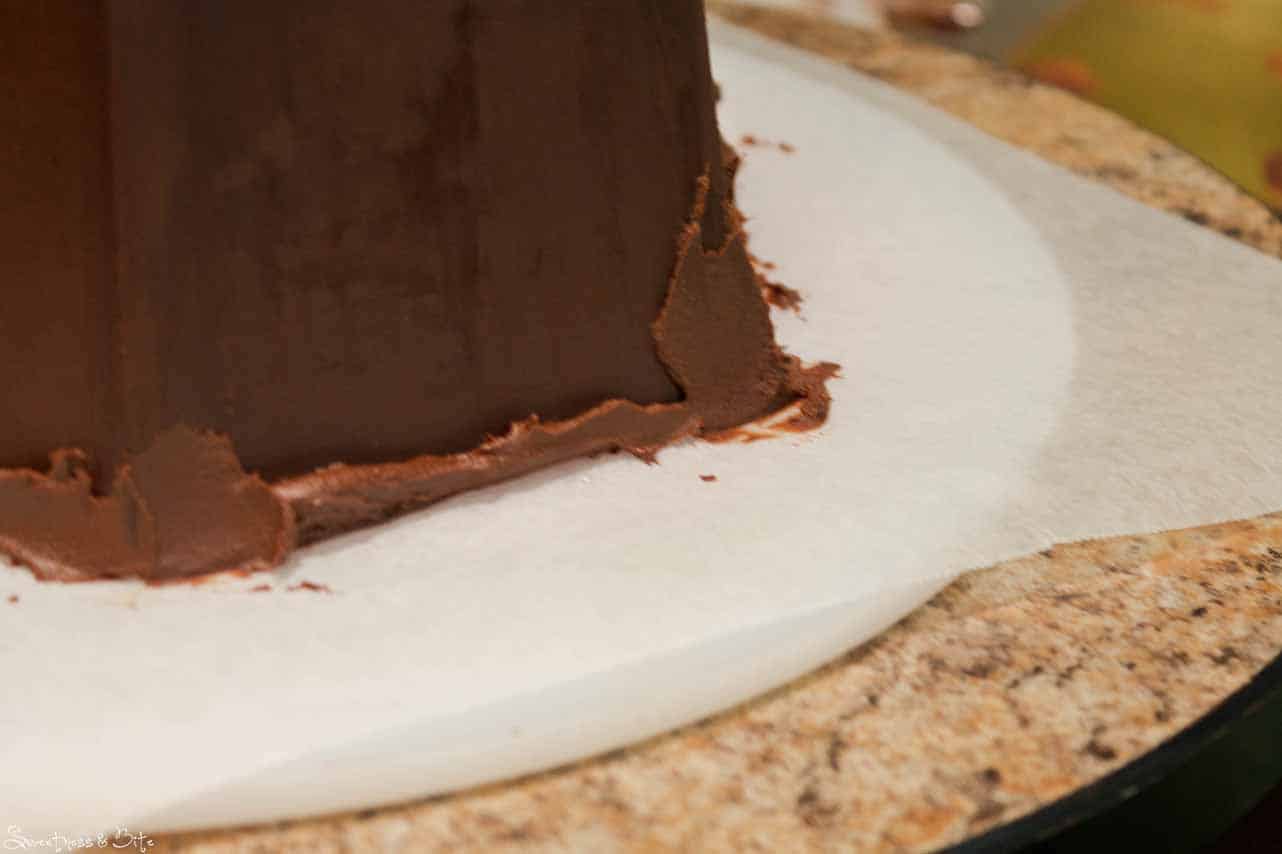
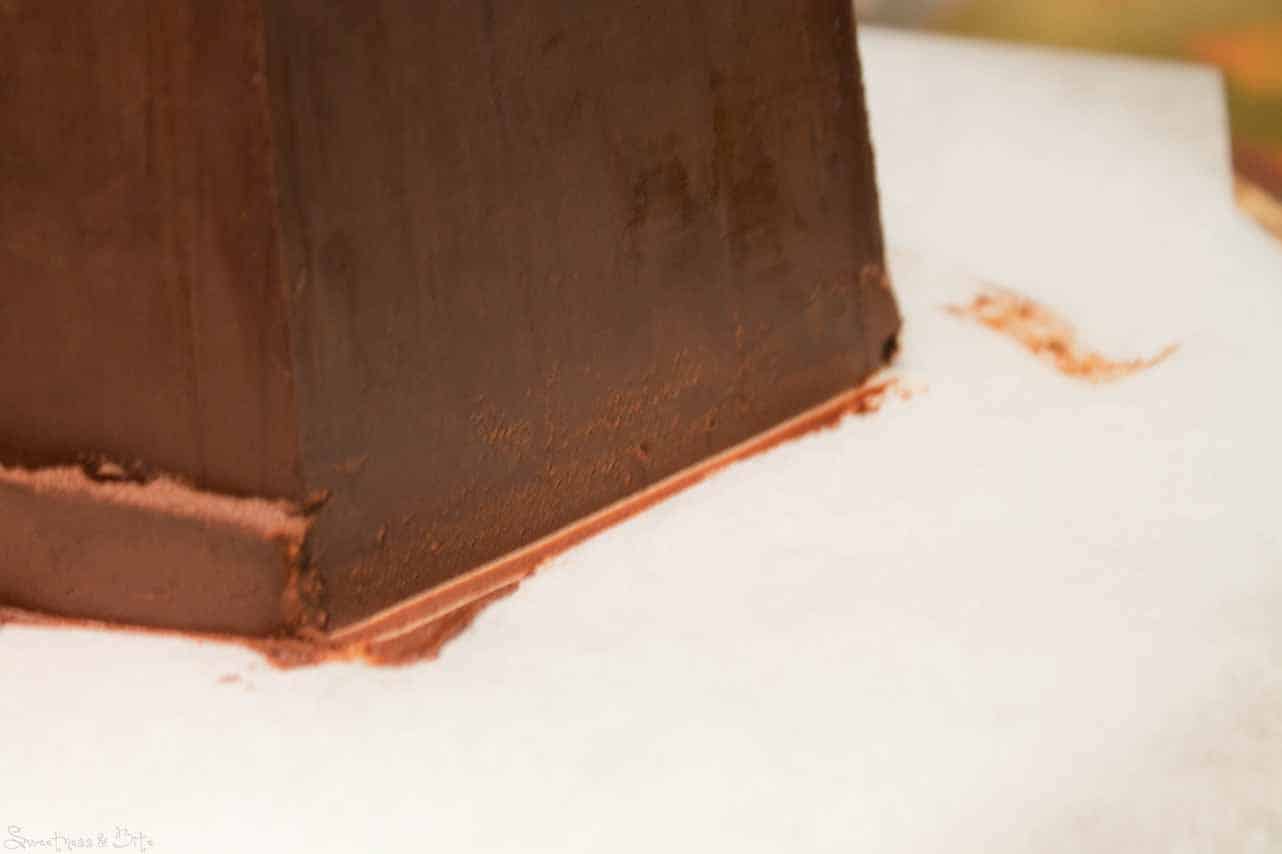
Once it’s smooth, place the cake back in the fridge for around 30 minutes, until the ganache has set. Then flip the cake back over and carefully peel back the baking paper. Fill in any little holes around the edge with ganache, but don’t worry too much about the middle of the cake, as we’re about to cut that out. Put the cake back in the fridge while you make a guide to cut the indent.
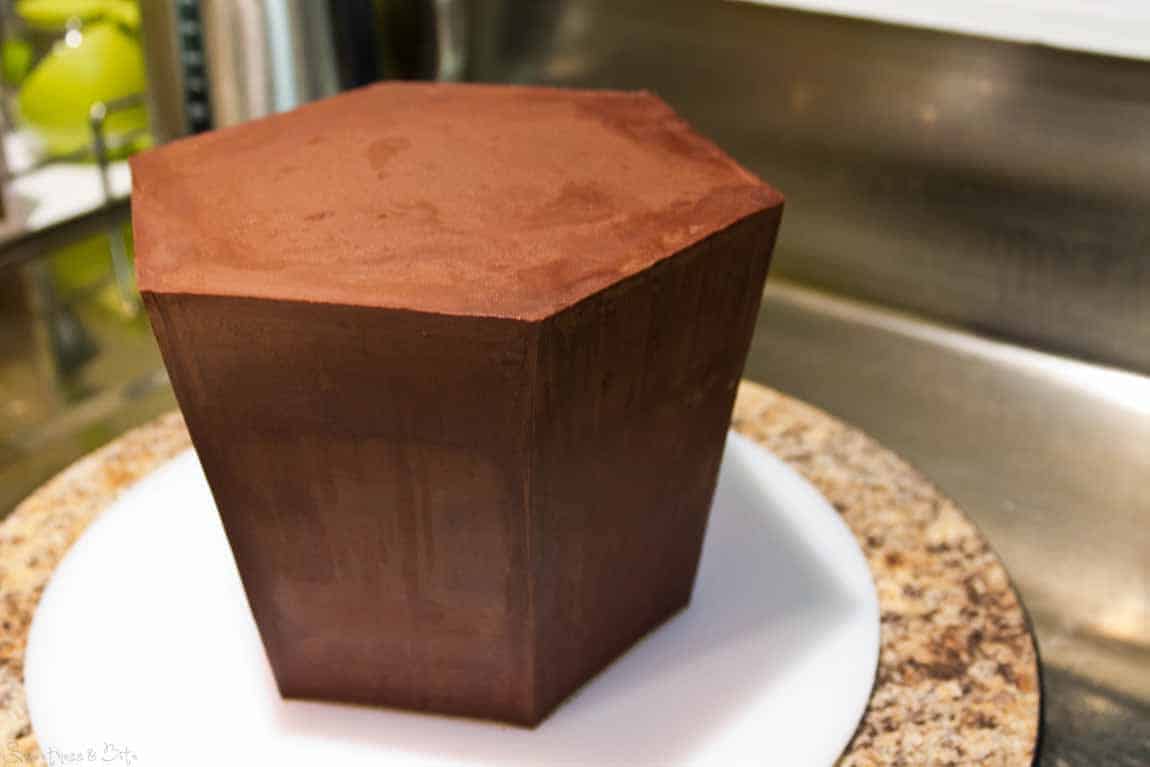
Take the piece of paper that you drew the outline of board #1 on at the start, and measure in ¾ of an inch (depending on how thick you want the ‘walls’ of your box) around the edge of the hexagon. Cut out the shape and put it onto the top of your cake. Use a knife to score around the inside of the shape.
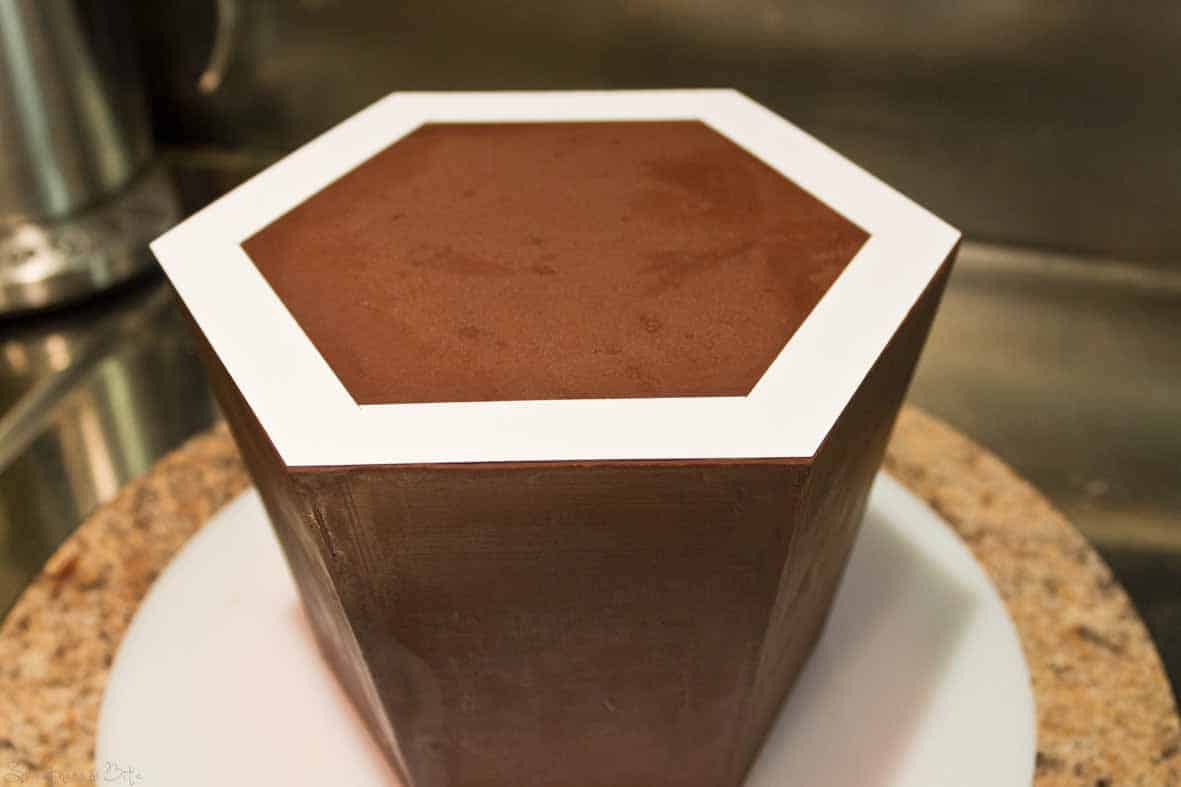
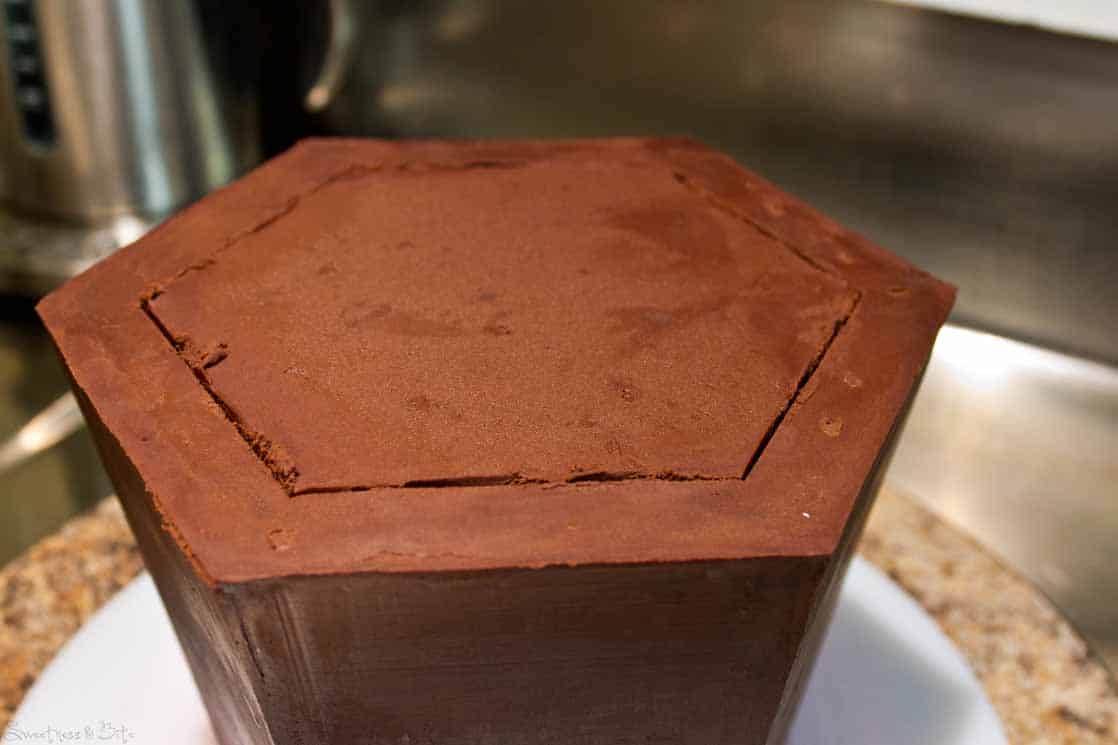
Using a small, sharp serrated knife, cut straight down through the ganache along the lines. You should feel the knife hit the baking paper, but try not to cut through it. Once you’ve cut the whole way around, begin carefully prying the cake out. When you’ve exposed the baking paper, cut through so you can get a grip on it, then gently pull it out. It may be tucked between the cake layers, so be careful not to pull too hard or you may rip it.
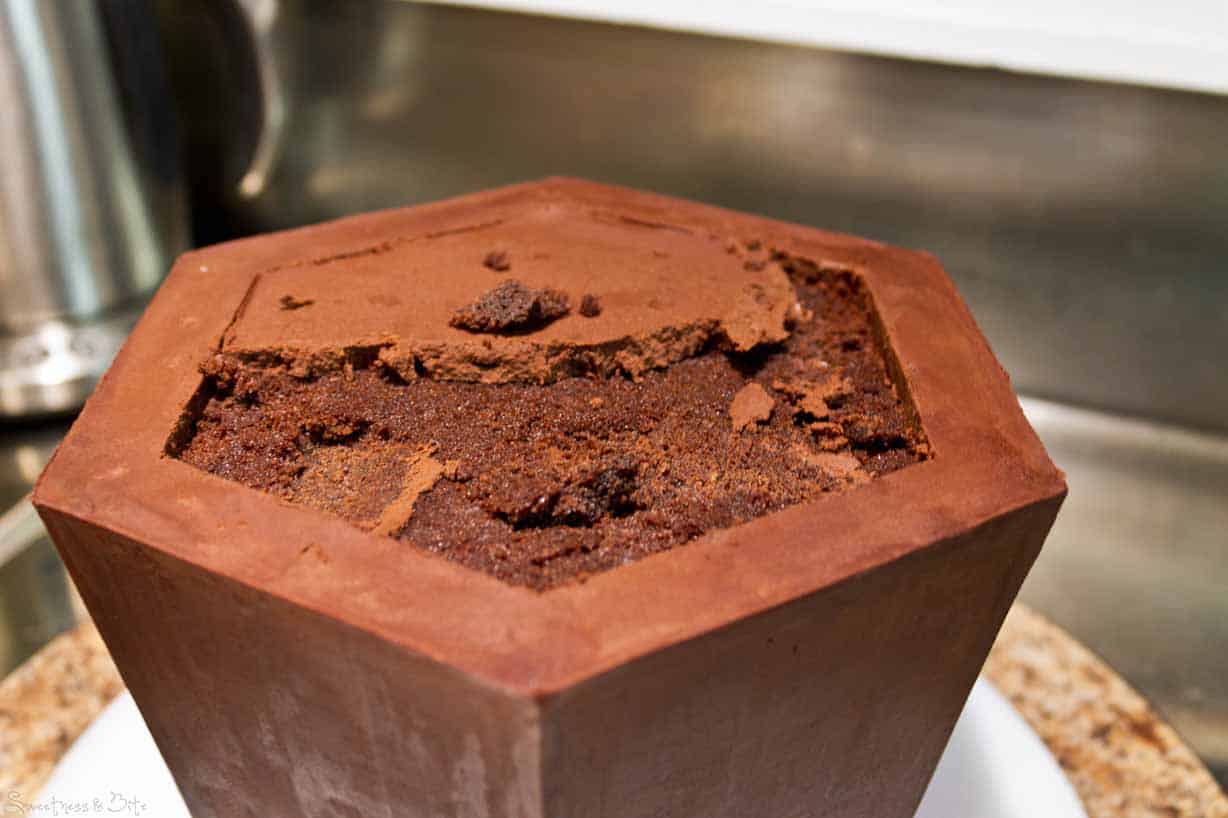
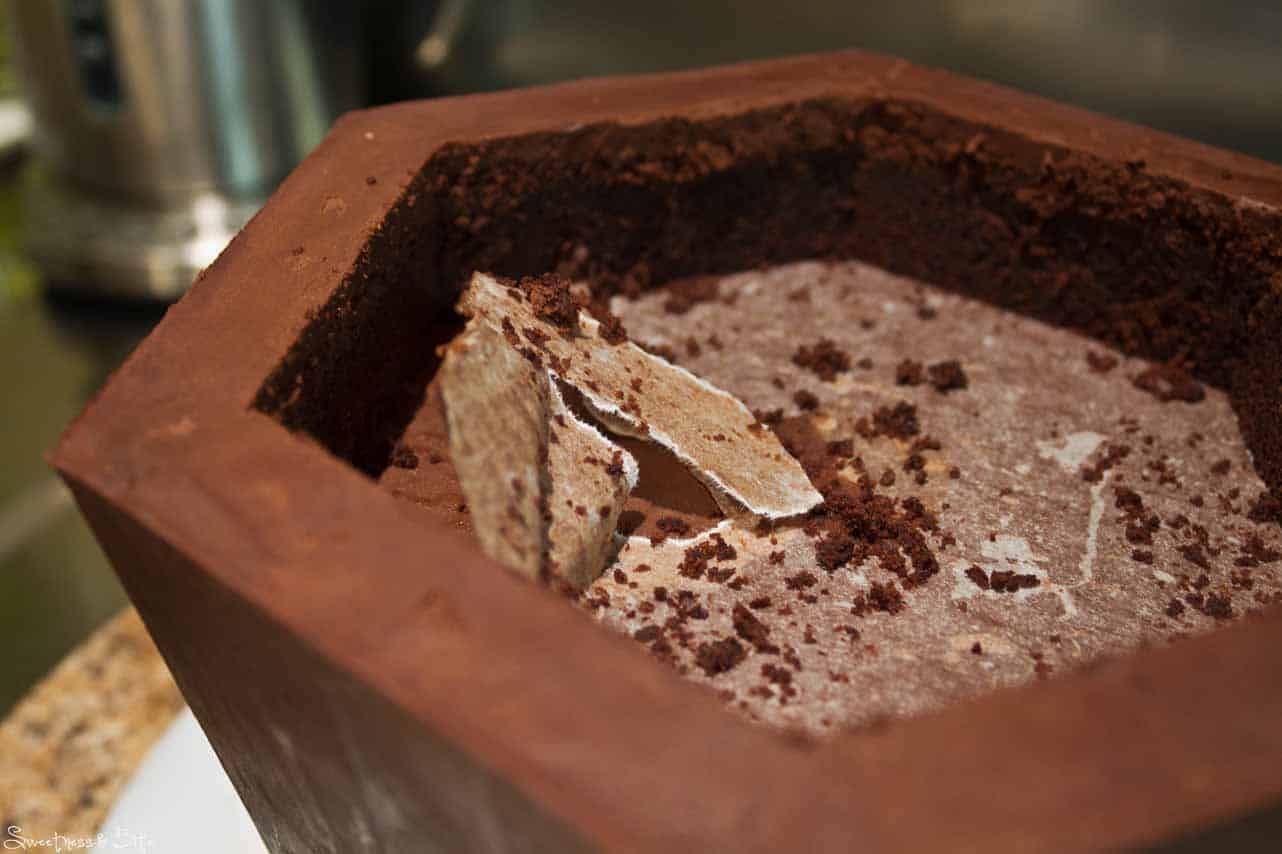
Using a small spatula (I use a small wedge-shaped spatula that artists use) ganache the inside edge of the box. You don’t have to be too fussy, as any lumpy bits will be covered by the ‘tissue paper’, but you do want to make sure the cake is sealed. Go around the whole cake with a hot metal spatula, smoothing out any rough bits.
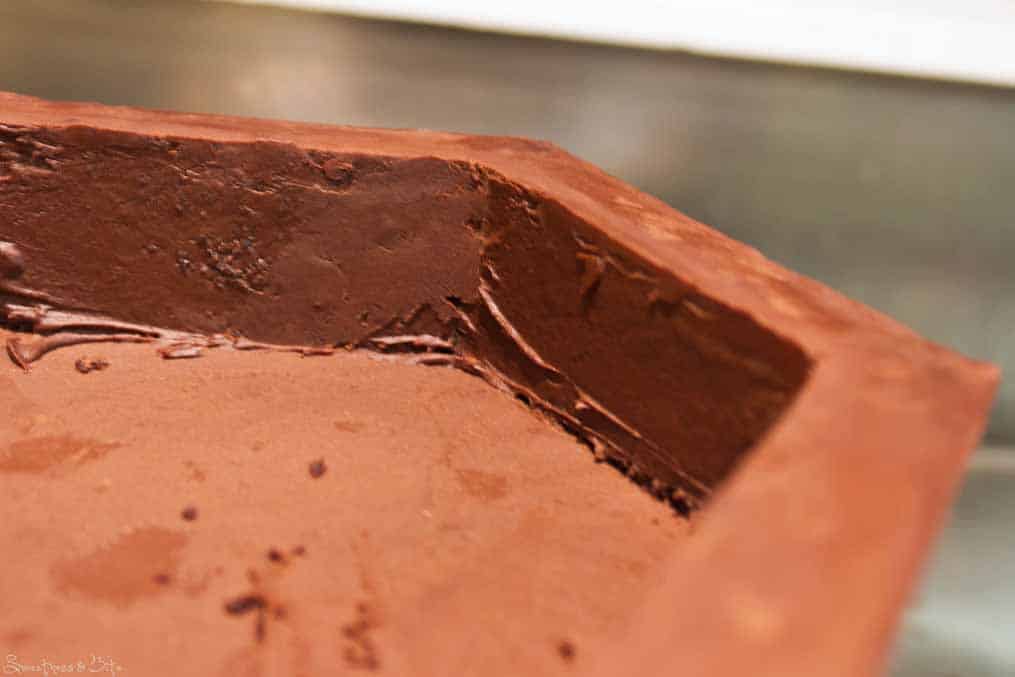
I decided the indent was a bit deep (due to my thick cake layers) so I warmed up some ganache and poured it in, letting it pretty much self-level, making the indent a little bit shallower.
Leave the ganached cake to set overnight.
*
{Covering the Cake}
You’ll need:
Fondant-ing paraphernalia
~ Rolling pin and/or pasta machine
~ Fondant smoothers
~ Cornflour/icing sugar shaker
~ Sharp knife and/or razor and/or scalpel
~ Vodka (or sugar syrup, but vodka dries faster and leaves less of a mess on the edges of the cake)
~ Paintbrush.
The easiest way to cover this cake is with panels on each side of the hexagon. I chose to make a template to make it even easier, although some trimming is still required. To make the template, measure the top and bottom width of a side of the cake, and the height. You need to add a couple of inches to the top of the template, and about half an inch at the bottom. My template didn’t give me quite enough excess at the top, but if you’re putting the piece of fondant “tissue paper” into the indent, then this isn’t a big deal as it will be covered.
If you’re not confident you can quickly place the piece in the right place, then add a little extra to the sides of your template as well. The key to getting nice, neat, sharp corners and top edges on this cake is quick placement and trimming of each piece. The good thing is that the last piece you attach is the best side to be the front (it’s the only side with no exposed fondant edge), so you will have practiced all the way around before you come to what will be the front. Make sure you’ve got all your fondant-ing bits and pieces handy, this makes it easier to work quickly.
Place the cake on a smaller cake board, or as I did, a tin of cutters. This raises the cake up so it’s easier to trim the bottom of the fondant neatly. Use a couple of bits of grippy mat to hold everything in place.
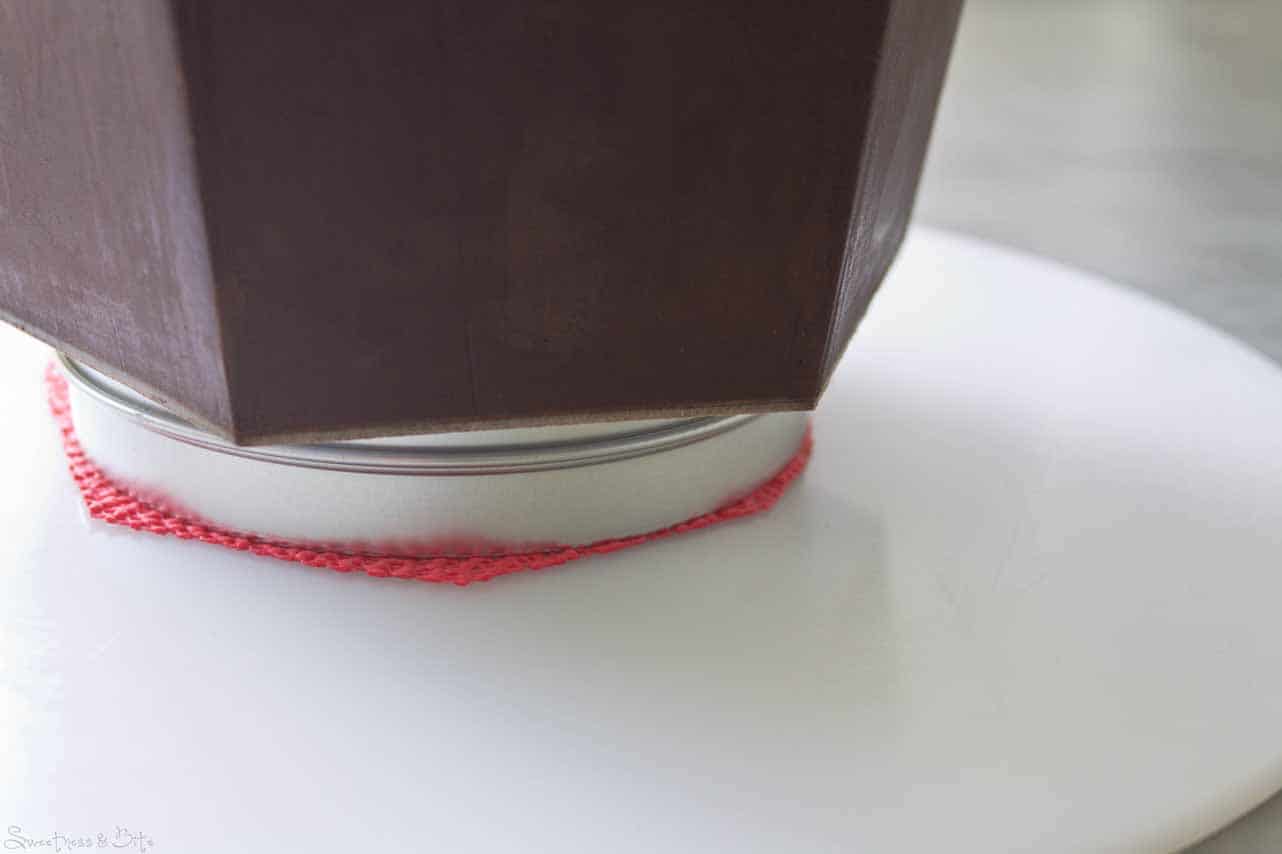
Roll out your fondant (I used my pasta machine to roll out the strips to ensure even thickness, #2 on my machine was perfect) then place your lightly cornflour or icing sugar dusted template on top. Cut around the template, (I found it easier to use a big kitchen knife so I could cut each side in one cut, saves dragging your knife through the fondant.)
Brush one side of the cake with vodka, making sure to brush right up and over the top edge of the cake and into the indent, and position your piece of fondant. I find it best to line up the left hand side of the fondant with the edge of the cake, and then I only need to trim the right side. Smooth the fondant against the cake, pushing out any air bubbles. Run your finger and thumb along the top edge to make sure it’s attached and to stop any cracking on the edge.
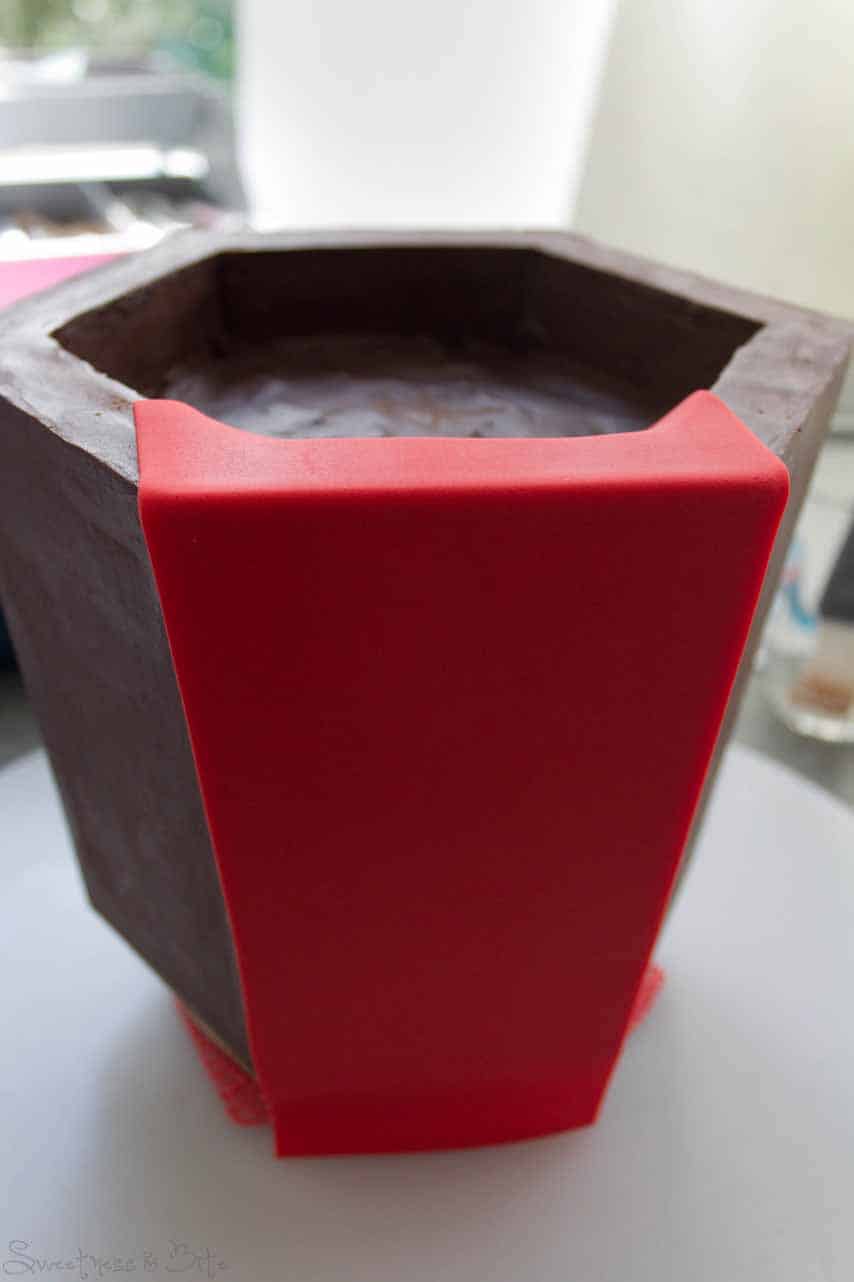
Fold the top of the fondant gently down into the indent. It won’t fit completely in the corners, so trim them carefully up to the top, and then cut on an angle from the inside corner of the top edge to the outside. Cut the same angle on the other side.
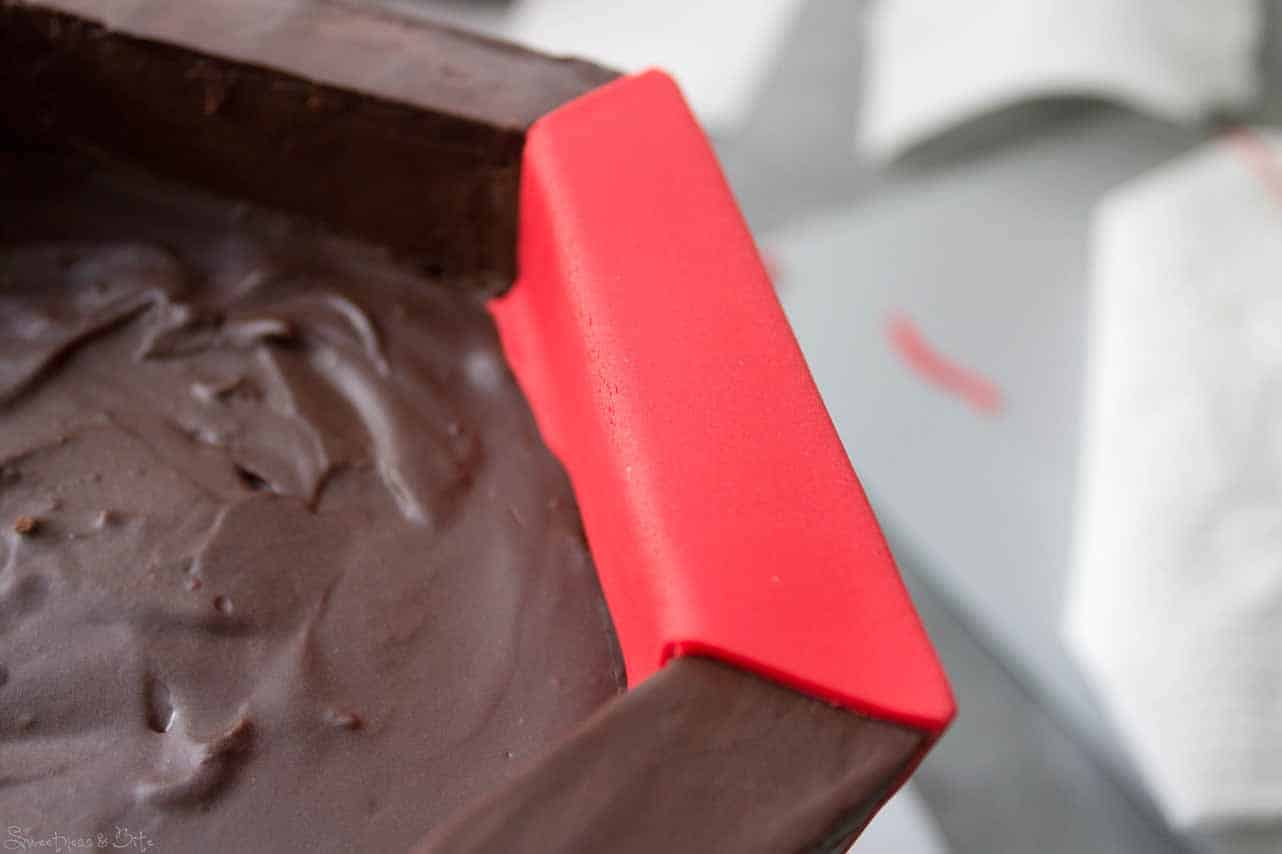
Trim down the right hand side of the fondant, trying to keep your knife flush with the side of the cake (I used a razor blade for this) and trim the bottom of the fondant, holding your knife against the cake board under the cake, to get a nice straight cut. Use two smoothers, one on top and one on the side of the cake to sharpen the top edge and smooth the edges.
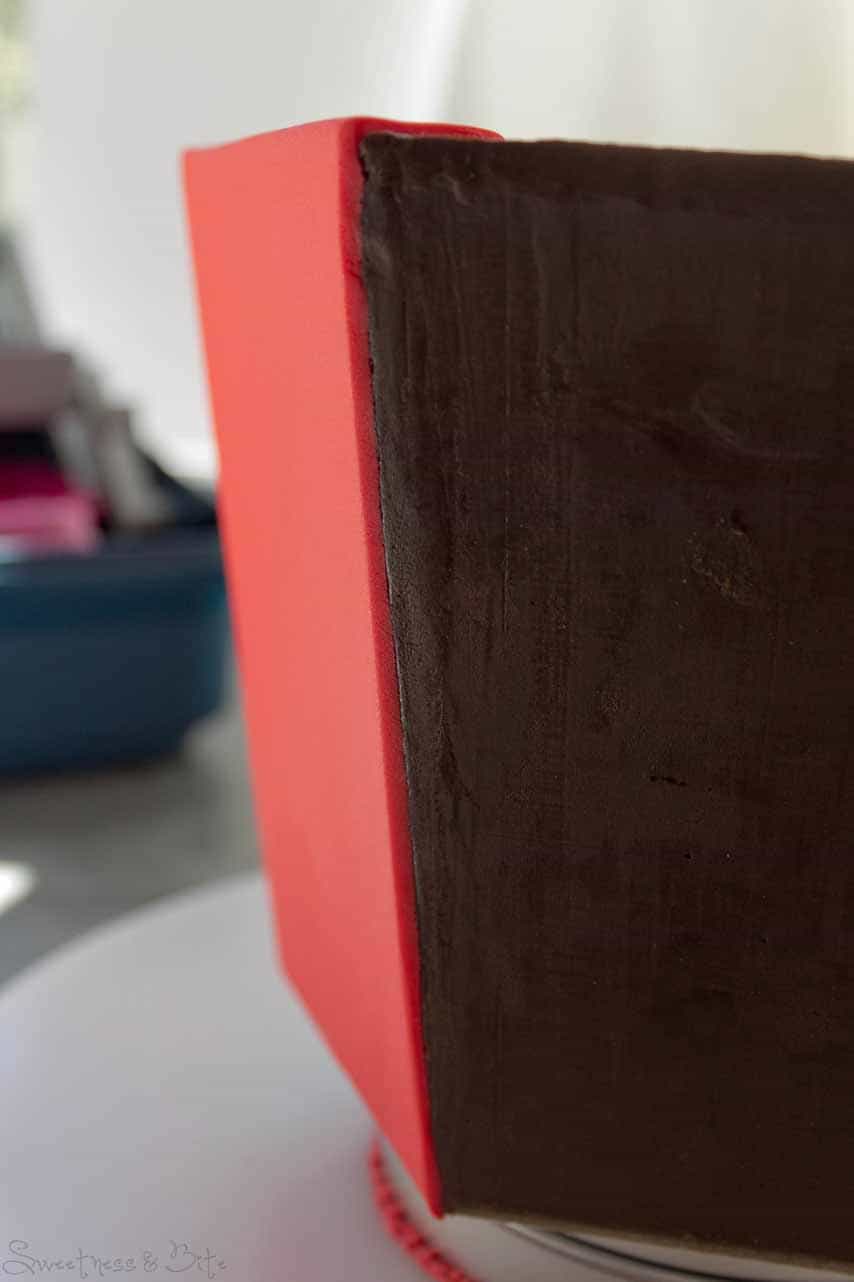
Repeat the above steps to place the second piece. When you brush the side of the cake with vodka, make sure you carefully brush the side of the first piece of fondant. Hold the brush flush (haha) with the side of the cake to make sure you don’t get vodka on the front of the fondant. When you smooth the piece of fondant over the top of the cake, press it gently up against the first piece, to help you see where you will need to cut along the top where the pieces will join. Cut this first, smoothing the pieces together.
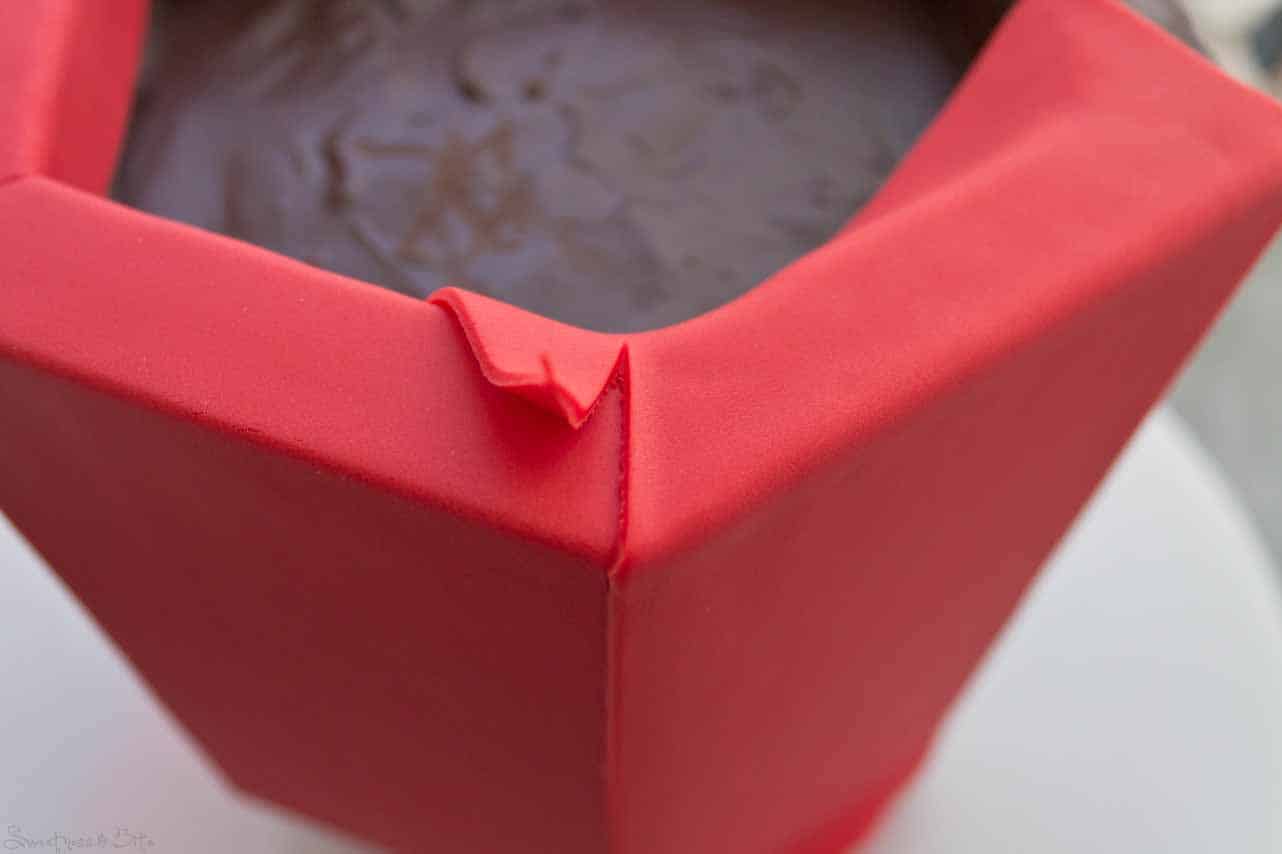
Trim along the right hand side as before. Do the next three sides the same way.
The final piece is a little trickier, to keep things neat you want to avoid needing to do much trimming on either side. If you’ve noticed how much you’ve trimmed from the right side of each other piece, then cut that much off the piece of fondant before you place it on the cake. (You could have done this the whole way around, but as there can be some variance in the sides, I found it easier to do each piece slightly bigger and trim.) If you need to trim the final side, do it carefully and with a sharp knife so the cut is neat, because you won’t have another overlapping piece of fondant to help hide any messiness.
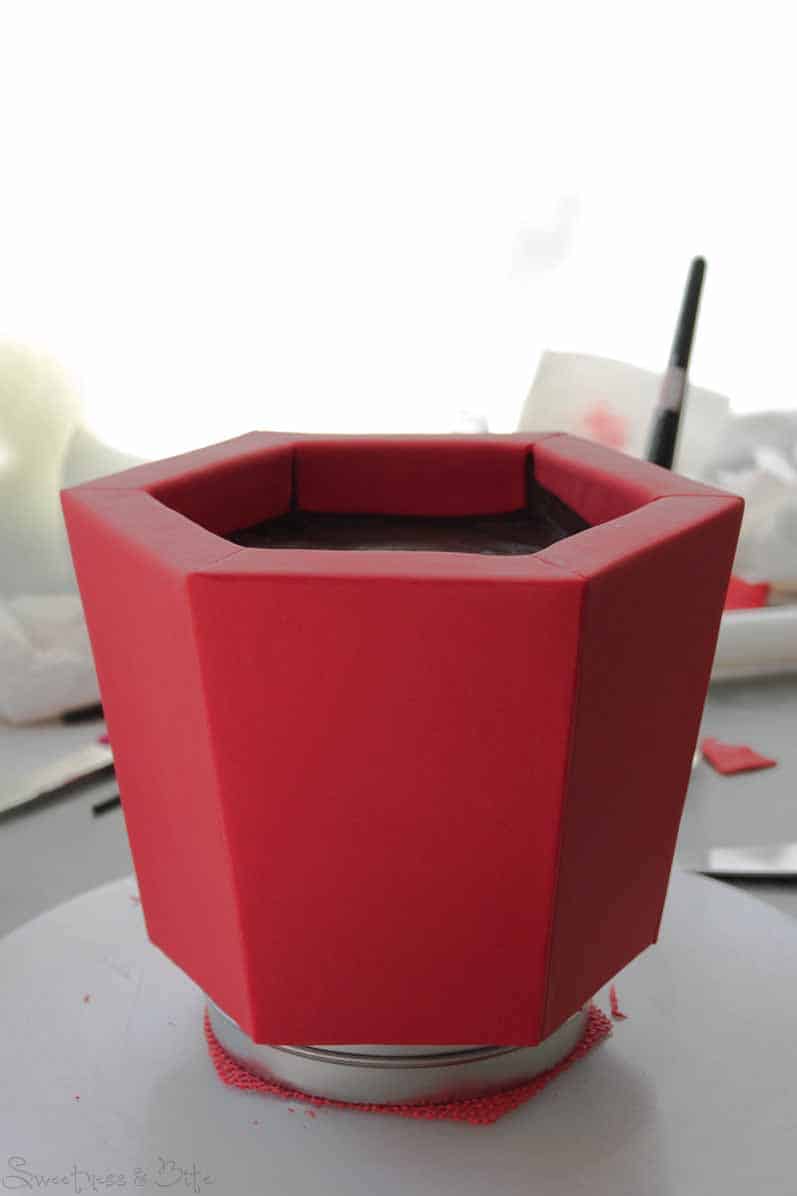
Gently lift the cake off the tin and place it on another board (I put a piece of baking paper underneath to make sure the bottom of the fondant doesn’t stick to the board.)
To make the tissue paper piece for the inside you’ll need that second piece of paper with the tracing of board #1. Thinly roll out some fondant, or gumpaste, or a mix of the two (which is what I used). Place your template on top, and cut around it, about another 1” out from the template. How much extra you cut is up to you, 1” will give you quite a bit of “tissue” sticking up above the sides of the box, if you don’t want it up so far then you can cut it a little closer to the template. Working quickly so the paste doesn’t dry out too much, either use your fingers to smooth and thin out the edge, or place the piece on a piece of foam and thin the edges with a ball tool.
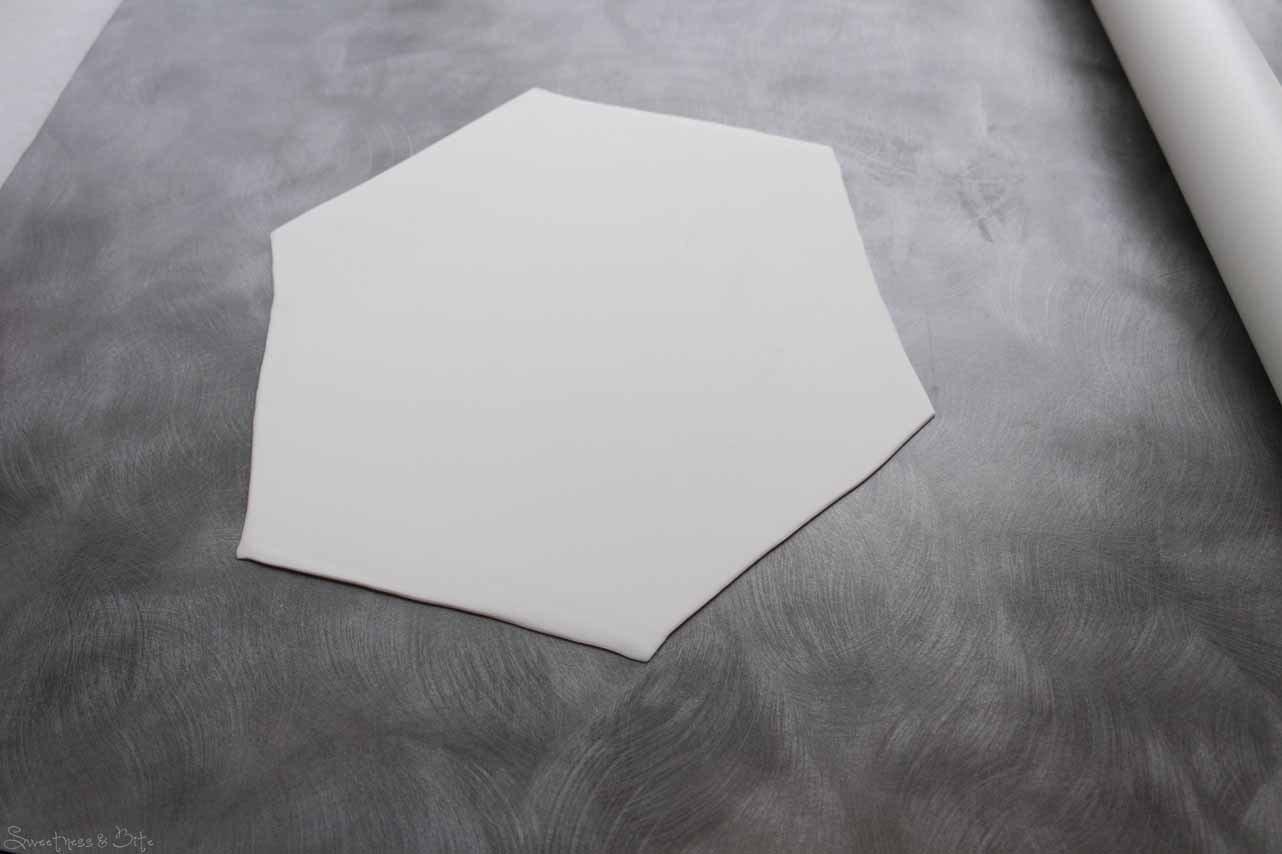
Place the piece into the indent of the cake, and press gently into the corners. It doesn’t have to fit perfectly; you’ll be filling it up with goodies so you won’t see it. Arrange the edges of the paste however you want, but as my mother tells me, “don’t tu-tu too much”, it will look more natural the less you mess with it. Make sure that the “tissue” doesn’t hang too far over on the side where you want your lid to sit. Note: If you’re planning to add decorations that go up over the edges of the box, do this before adding the tissue. I was only adding dots, so I did the tissue first.
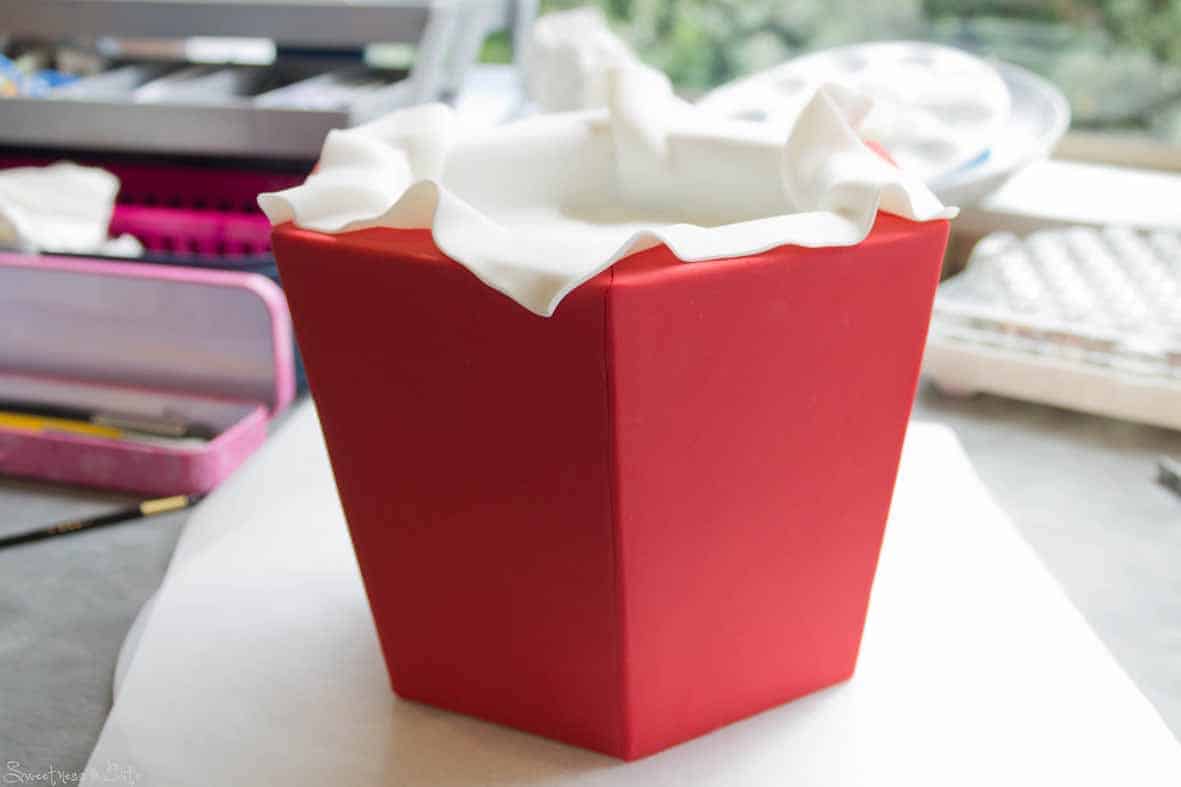
Decorate the box however you want, I just added gold circles in a kind of rough pearl-drape pattern, and leave the fondant to dry (overnight is best, but an hour or two is ok.)
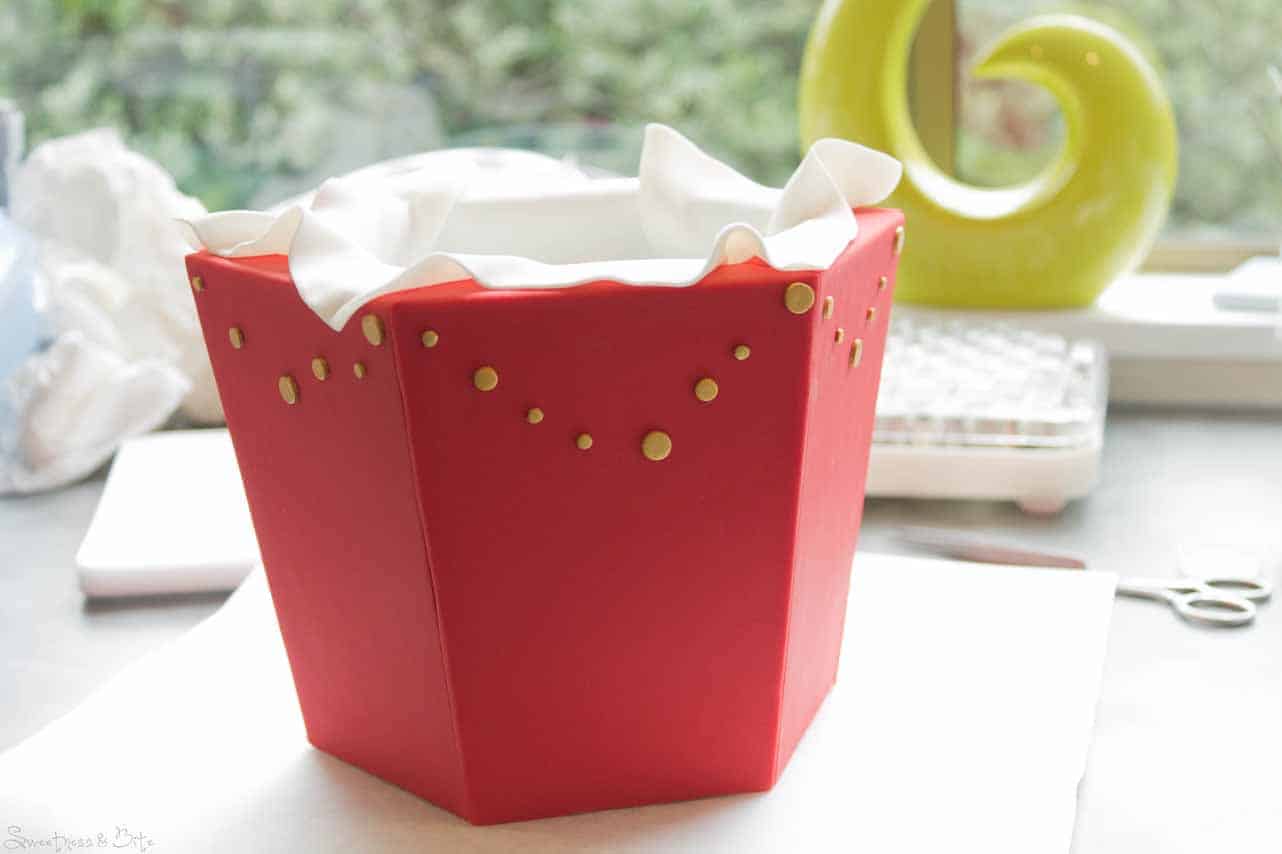
Carefully place the cake on your display board, and fill with lollies or chocolate. Prop the lid against the box. If you need to travel with the cake, I would suggest either leaving the lid separate and just placing it on when the cake gets where it’s going, or you can attach it to the board with royal icing or edible glue.
Shall I tell you how to make the lid as well? Why not, don’t think I’ve talked enough yet at all….
*
{Making the Lid}
I made the lid in and around making the rest of the cake, but you could make it ages in advance if you wanted to, it’s not edible anyway so it’s not going to go off.
You’ll need:
~ ¾” thick polystyrene
~ Craft knife & cutting board
~ Ruler
~ Sandpaper
~ Fondant tools – rolling pin, smoothers, knife, etc..
~ For the rose – flower making tools… ball tool, foam pad, wire, sugar glue, plus flower formers or soup spoons for drying the petals
It’s up to you whether you want your lid to taper or not, I decided that I did, coz I like to make things more difficult for myself. If you don’t want it to taper, just cut out a piece of polystyrene the same size as the top of your box.
To make a tapered lid, cut out a hexagon that is around ¼” bigger than the top of your box. On one side, measure in ¼” (or trace around board #2, or one of those templates if you’ve kept them). Use a craft knife to cut around the lid, from the mark on that side, to the edge of the other side, creating a slant. Use sandpaper to refine the edges. Since you’re not actually placing the lid onto the top of the cake, if it’s a bit off size-wise, it’s no big deal.
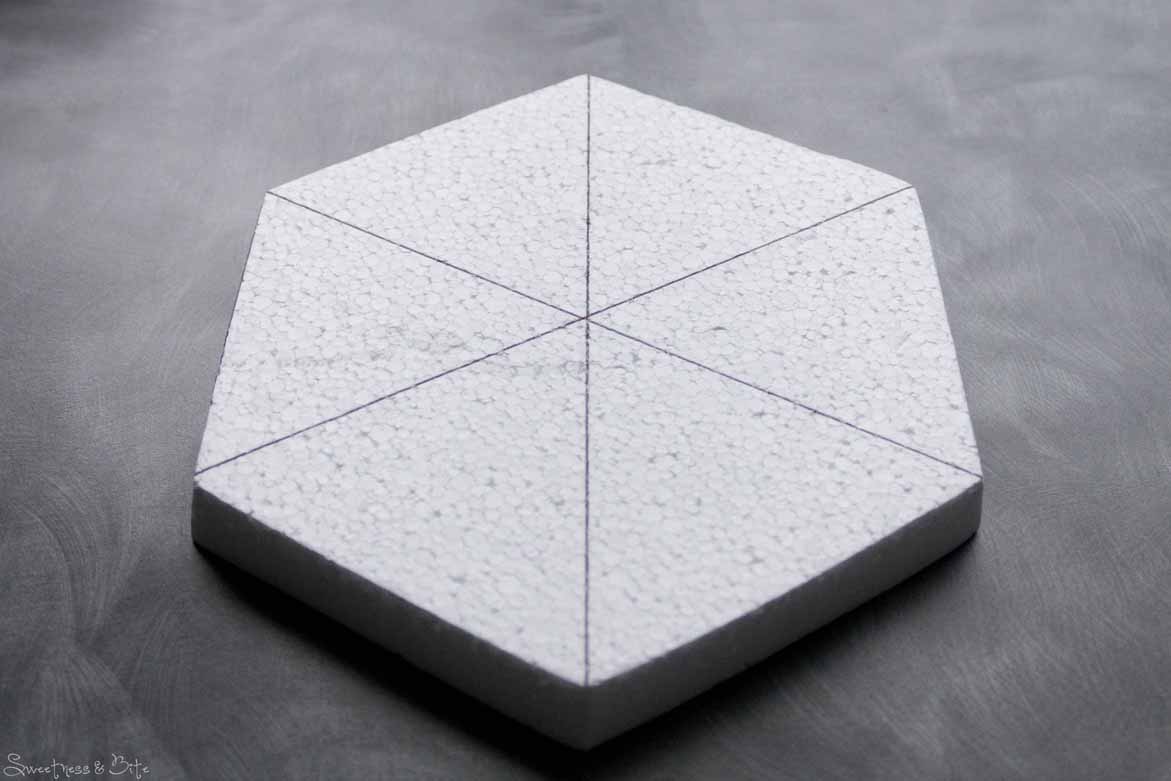
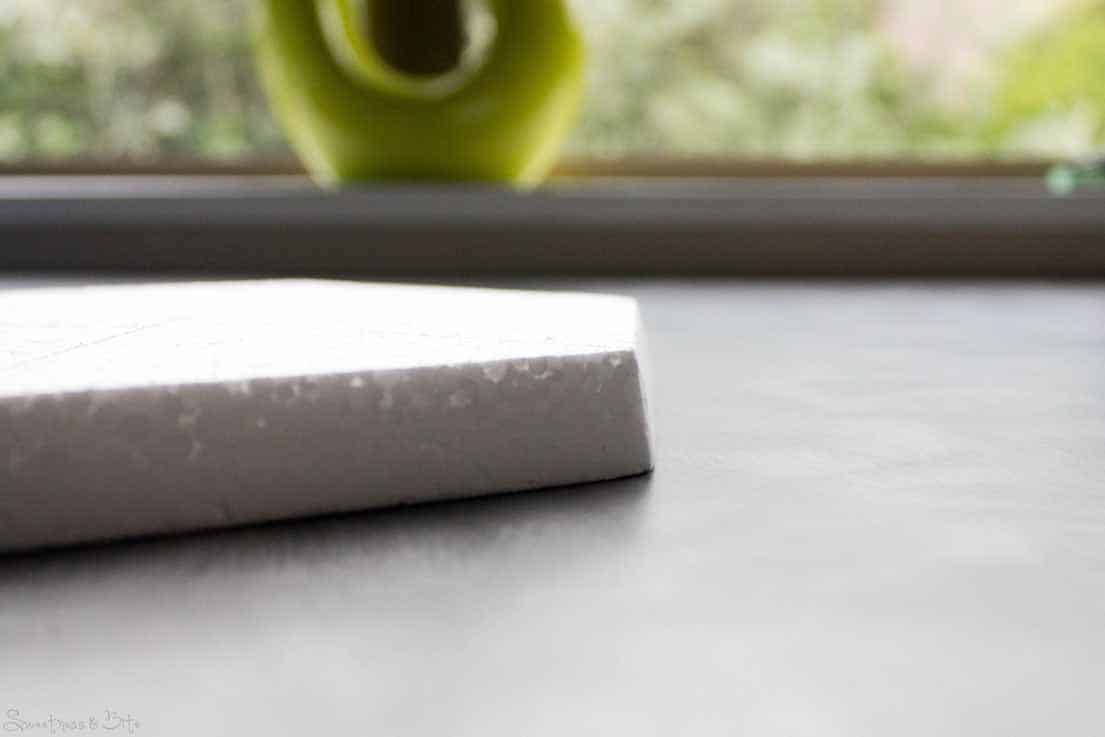
Brush the smaller side of the lid with vodka and cover with fondant or gumpaste. Trim around the edges and then leave to dry. I pressed a texture mat into mine after covering, but you can leave it plain if you want.
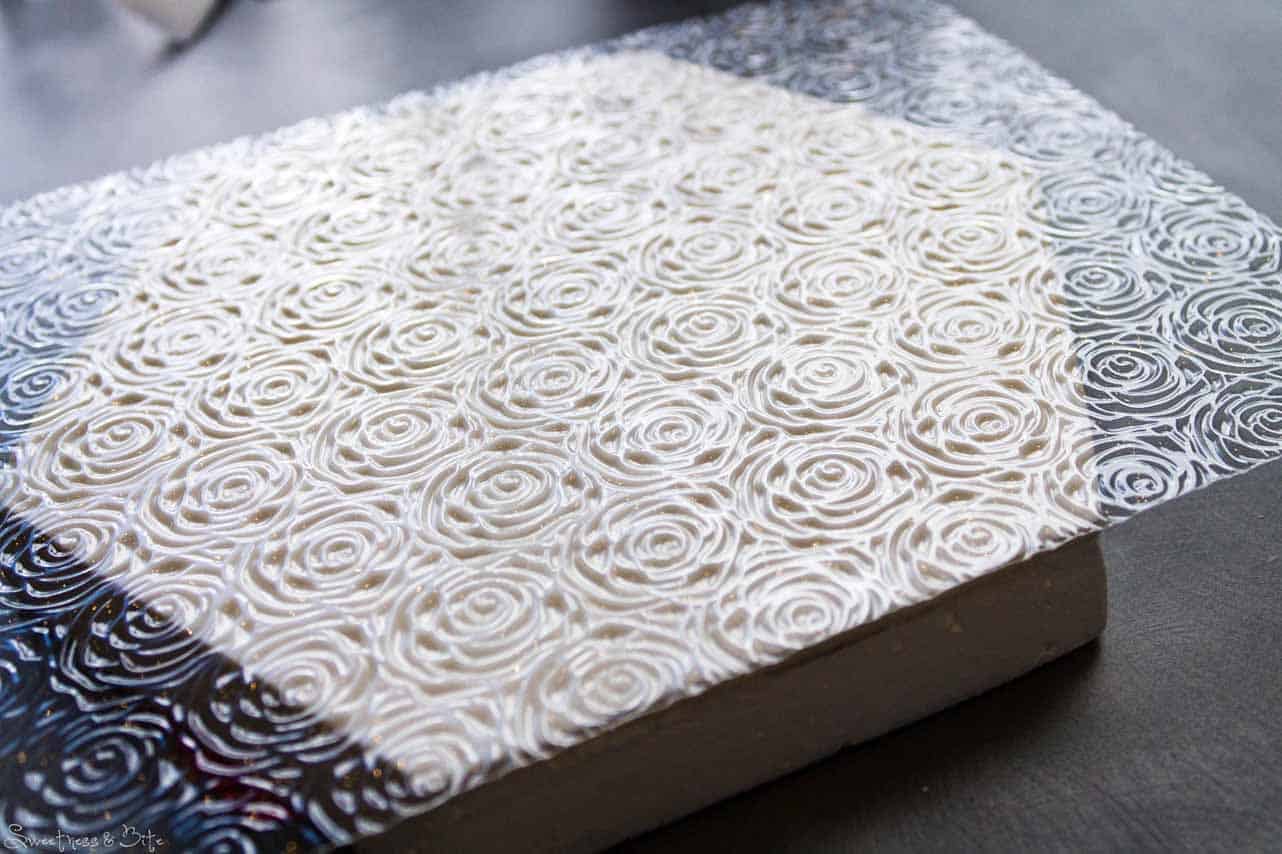
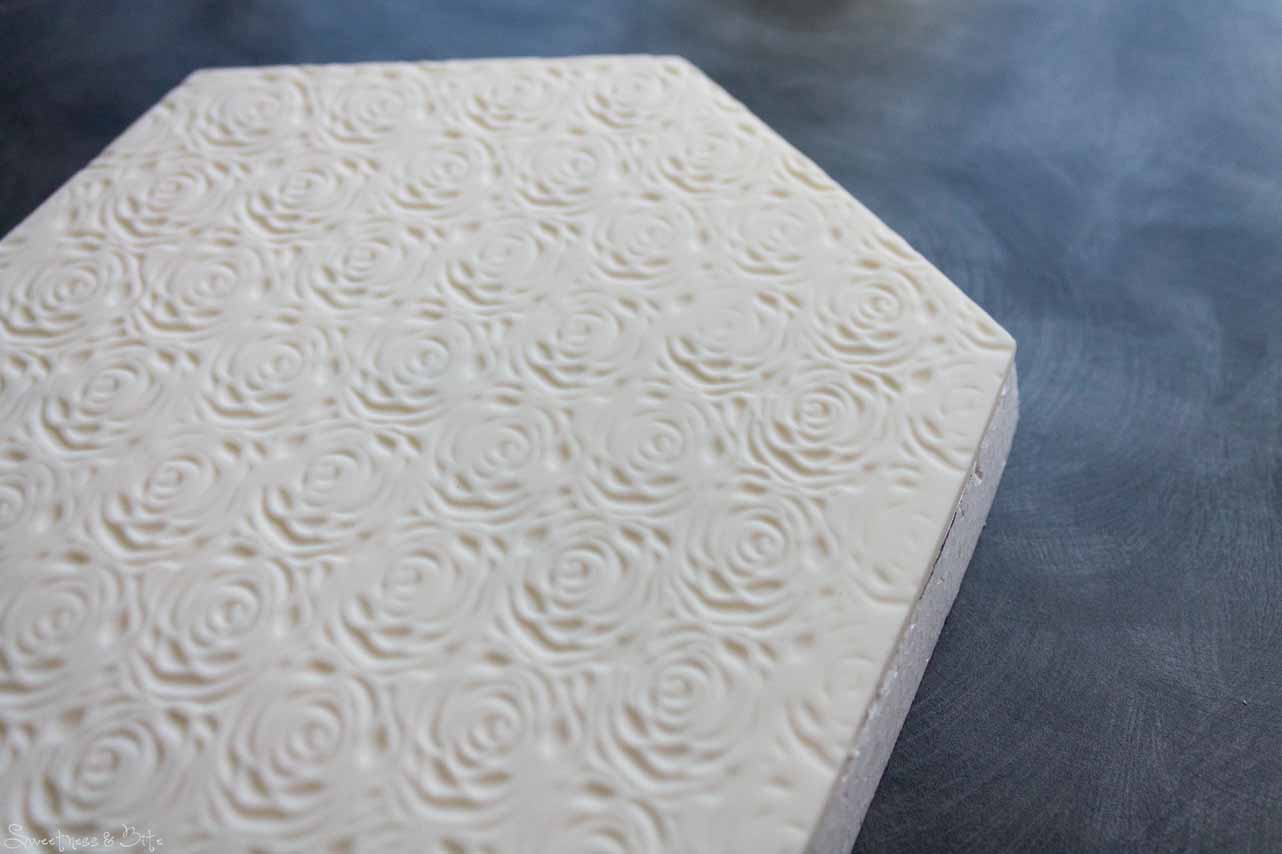
Cover the top of the lid, gently easing the fondant down over the edges. You’ll need to work quickly to get the paste down over the corners of the polystyrene and tucked down into the taper. It took me two goes to do this, the first time I was too slow and the edges cracked. Flip the lid over onto a piece of baking paper and trim the excess paste carefully with a sharp knife, scalpel or razor blade.
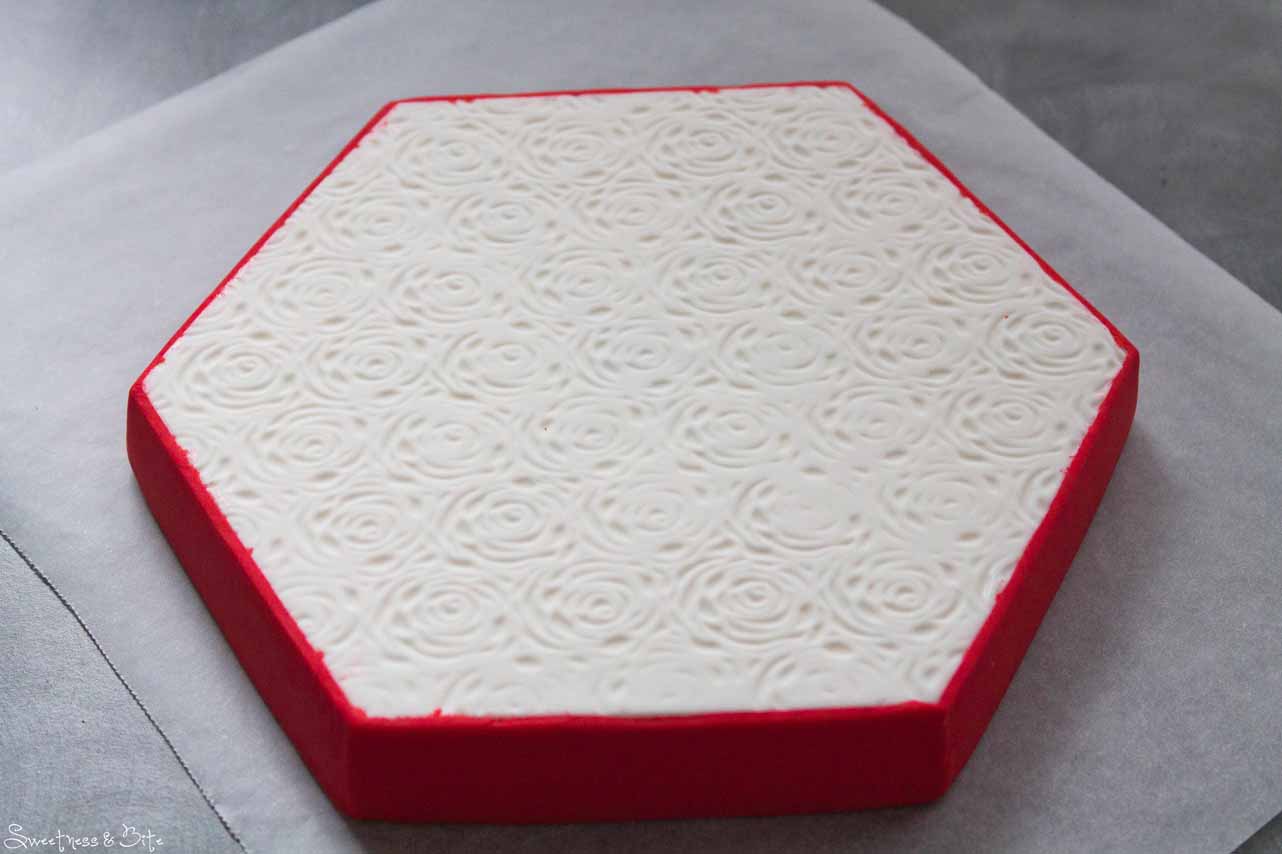
If you end up with some coloured paste from the top on the white, leave it to dry and then gently scratch off the coloured bits.
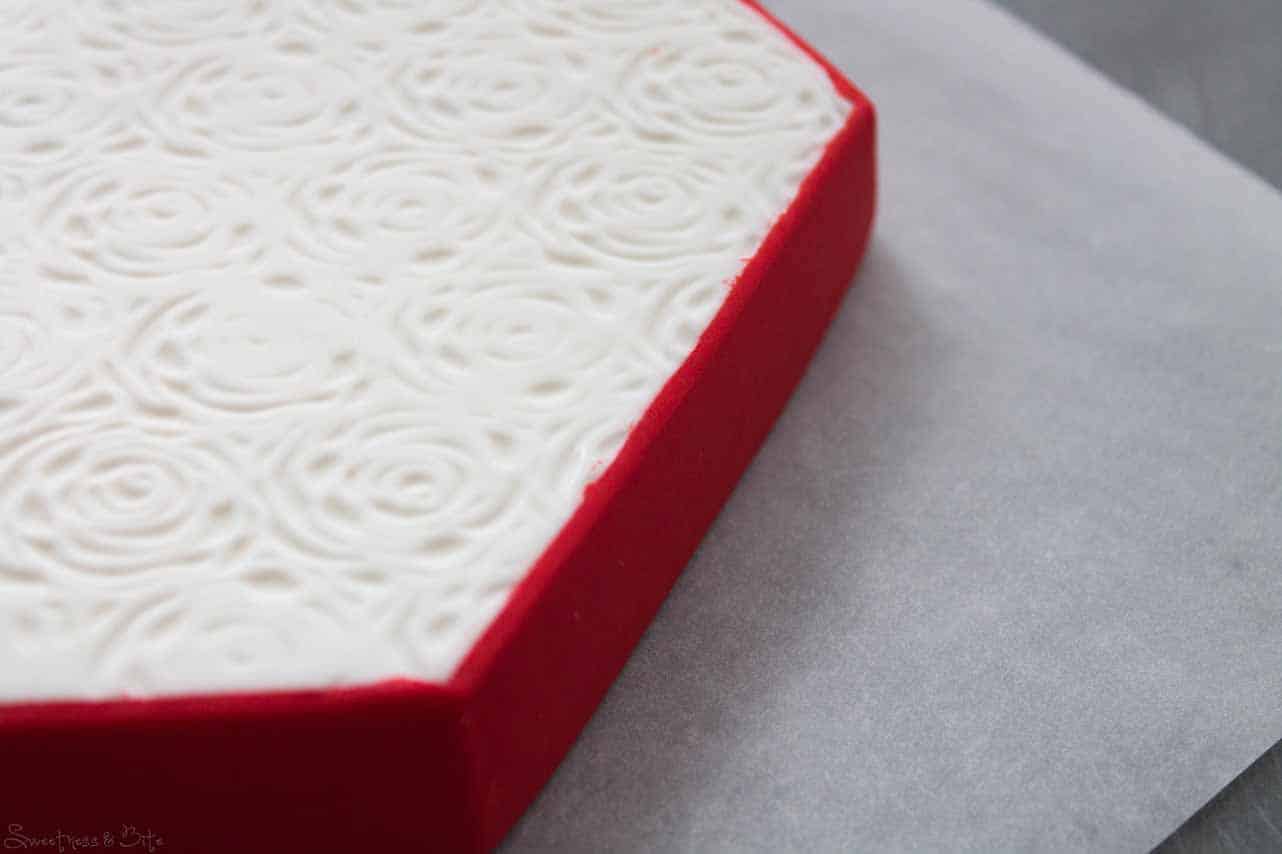
Those rough bits of red fondant on the white are easily scratched off with a scalpel or razor blade once the fondant is dry.
Leave the lid to dry so you don’t dent it while you do the rose.
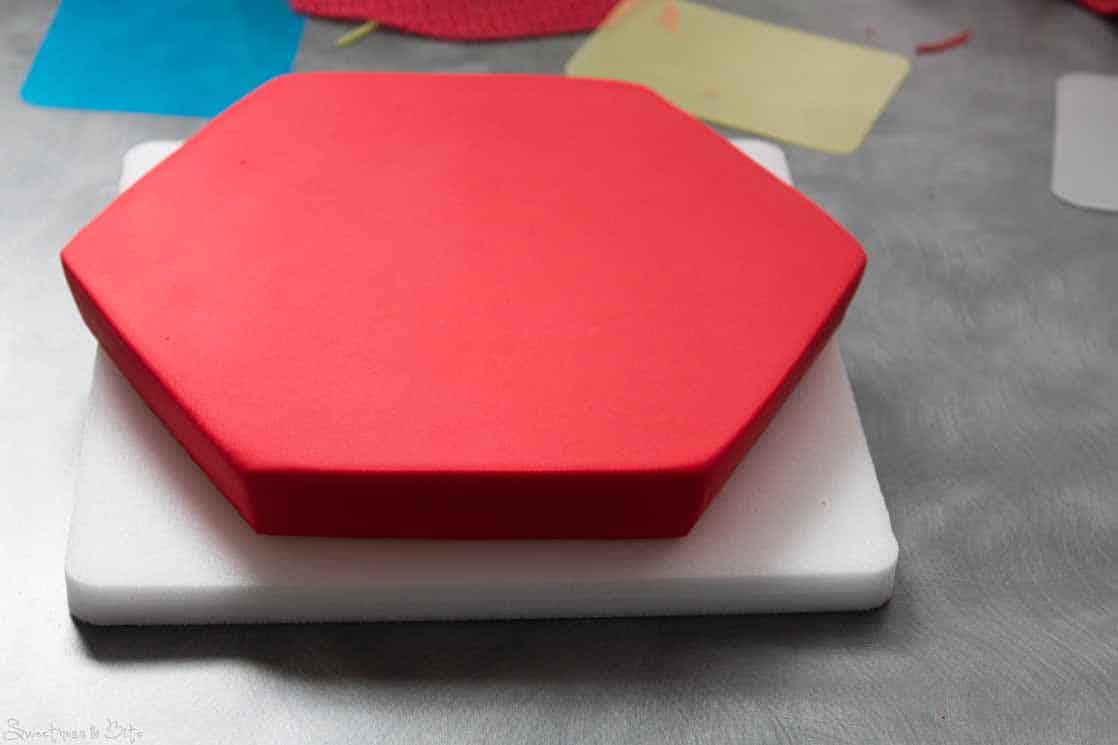
*
{Making the Rose}
I won’t tell you how to make a rose, coz I’m totally unqualified to do that. This was only the third rose I’ve ever made, and I wasn’t 100% happy with it. I followed instructions in Alan Dunn’s Wedding Cake Decorator’s Bible, but there are plenty of online tutorials on making roses. Luckily for me, as this is a decoration on a ‘box’ it doesn’t need to look botanically correct. At least that’s what I kept telling myself.
Basically for this, you want to start by making an almost-full rose, (on a piece of thick wire, I used 18 gauge, or you could use a toothpick) and then leave it to dry.
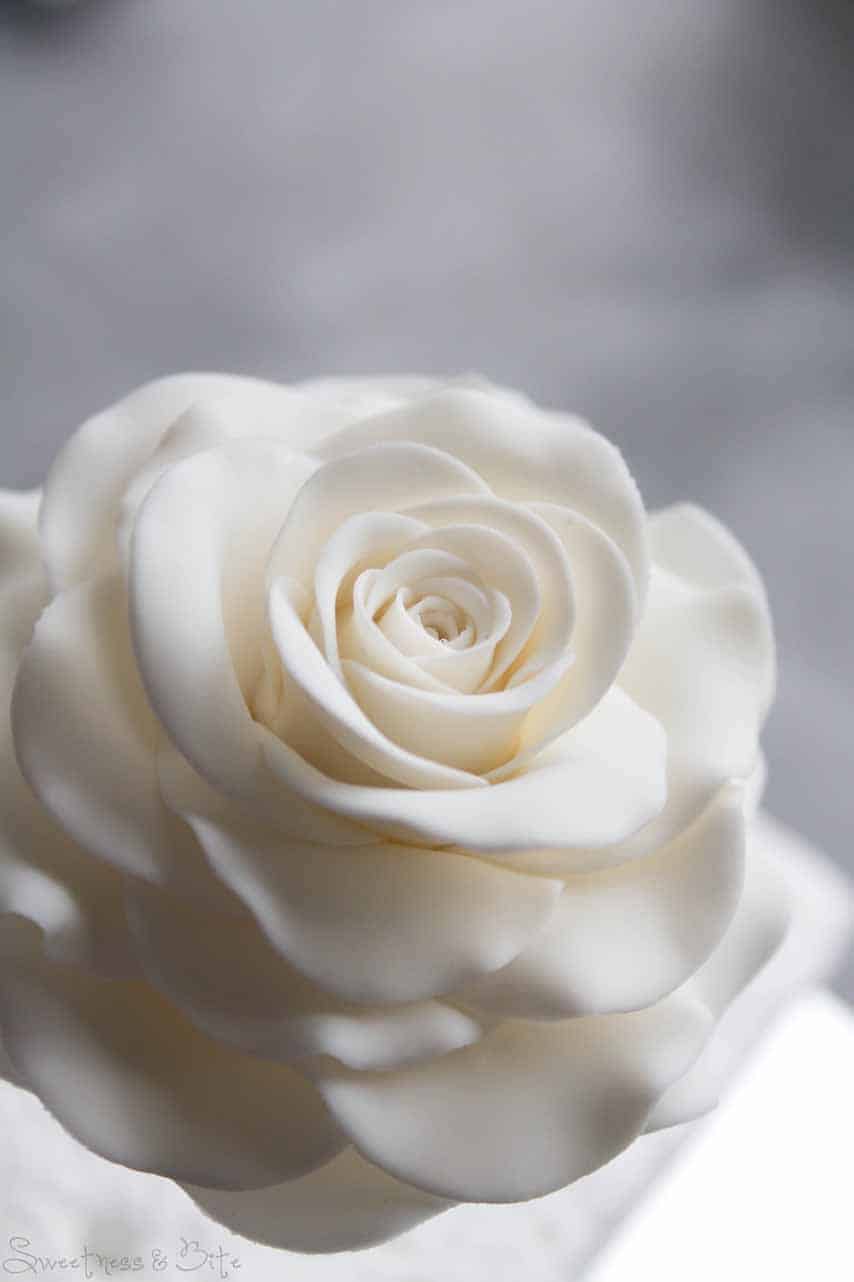
While the rose is drying, make a template for the top of the lid (or recycle one from earlier, it doesn’t have to be exactly the right size, you’ll see mine was a bit smaller) Fold the template to find the middle. Decide how far in from the edges of the lid that you want your rose to reach. Draw lines around it. Find something round to draw around that fits close you where your lines are. Centre it and draw around it, then cut the circle out.
Place the two pieces of template onto the lid, and push a pin through the centre to mark it onto the fondant. Remove the circle, leaving the outer piece.
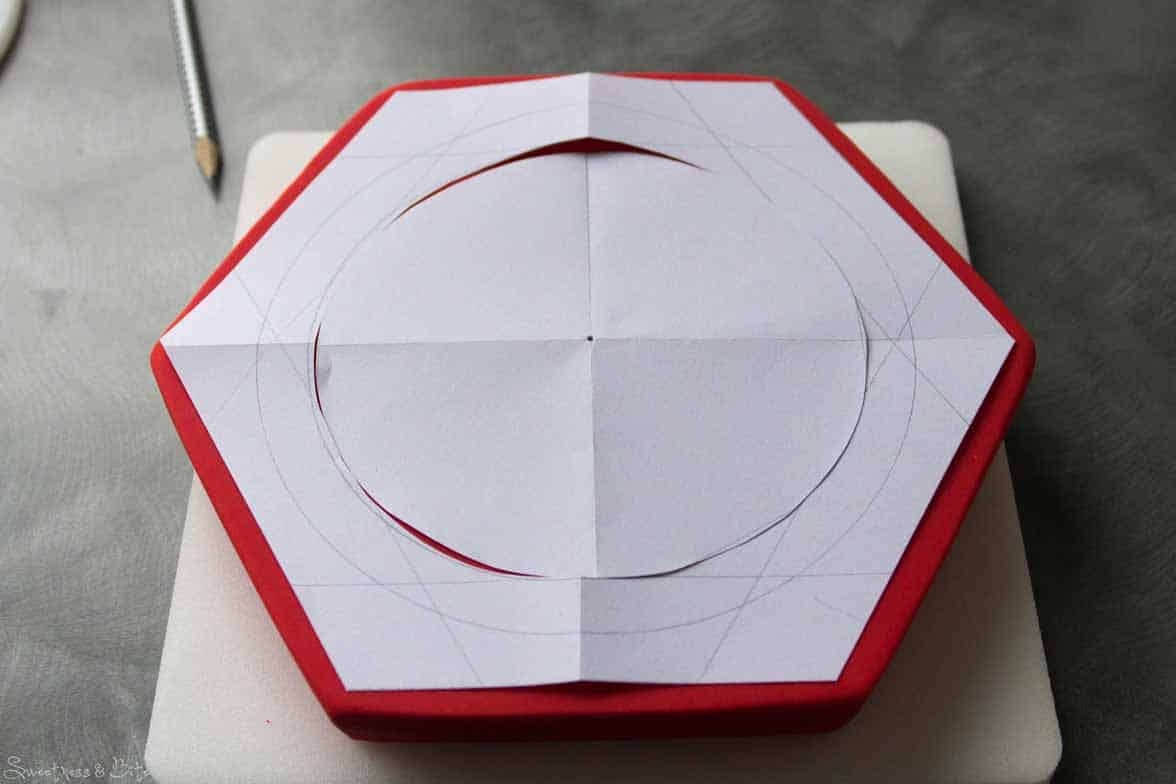
Start making your petals, exactly as you did them for the rose, and leave them to dry slightly with the edges curled back. I used some plastic flower formers, and also some soup spoons to dry my petals. You need to let the petals dry just enough to keep their shape, but still be slightly flexible. Place your first row of petals around the edge of the template, overlapping each piece slightly. Once you’ve got them where you want them, stick them in place with a little edible glue.
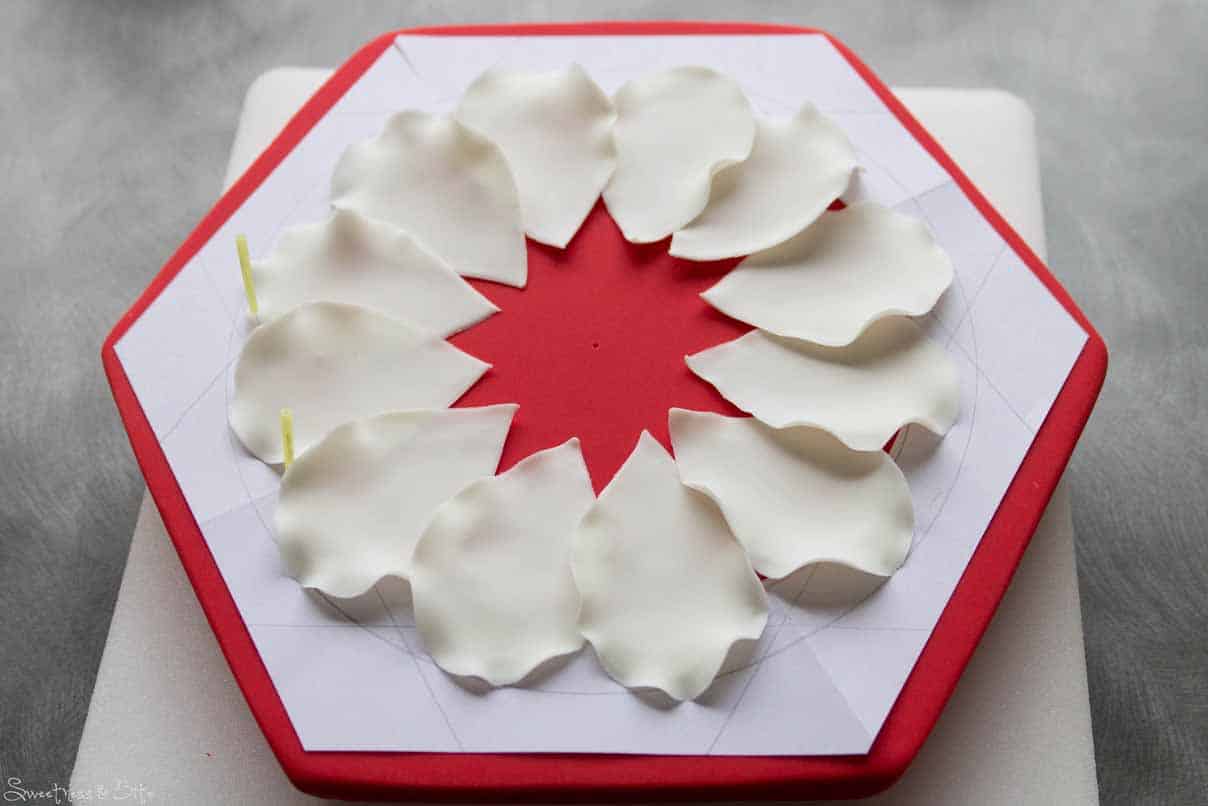
If any pieces sit too flat against the lid and you want to curl them a little, place small rolled up pieces of paper towel under them.
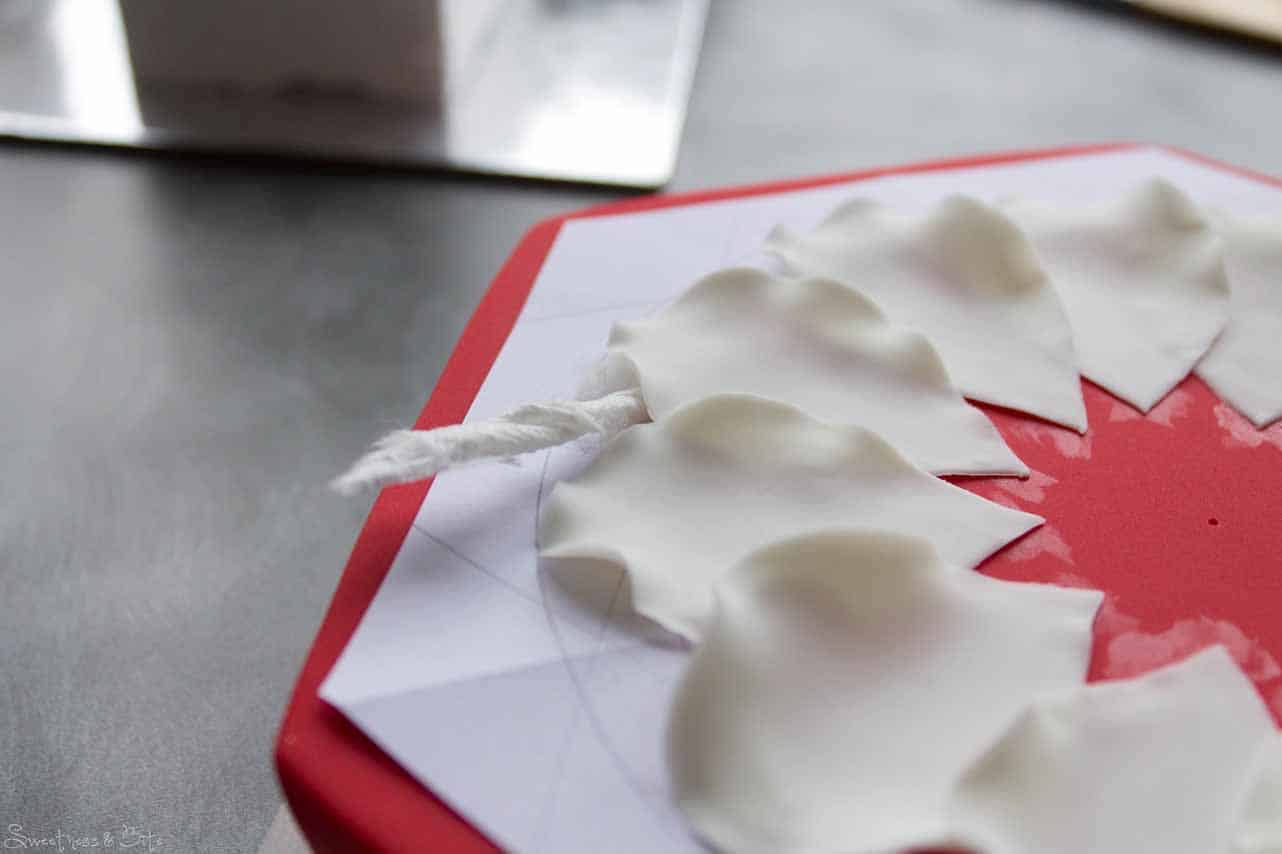
Allow this layer to dry for 10 minutes or so (it’s fine for the other petals to keep drying on their spoons while you wait).
Lay out your second row of petals, overlapping them, and aiming to place the petals over the joins of the first layer. These petals should be a bit drier, and curve upwards slightly from how they’ve dried in the spoons. You can glue these ones as you go, and slide them into place if you need to. Prop up any pieces you need to with paper towels as before. Do the third row of petals the same way.
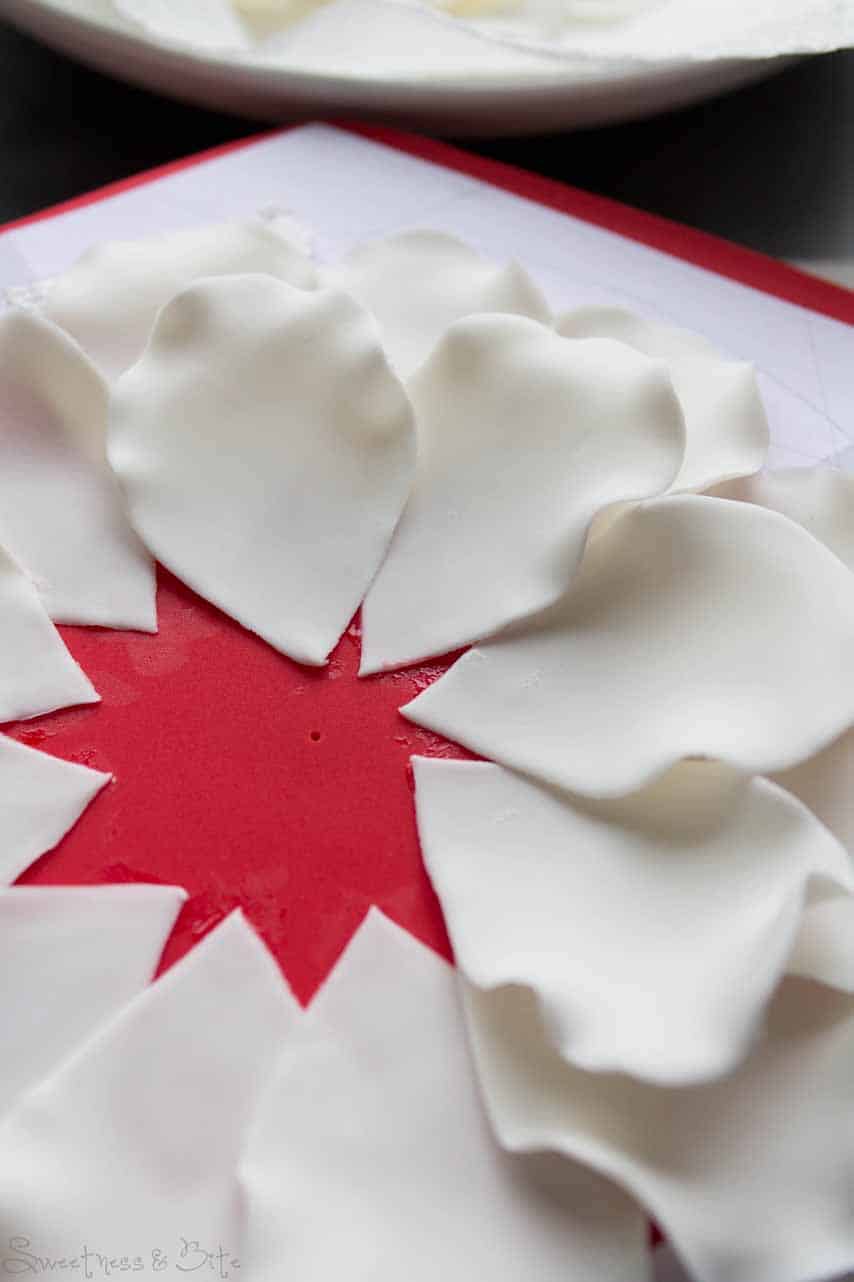
*
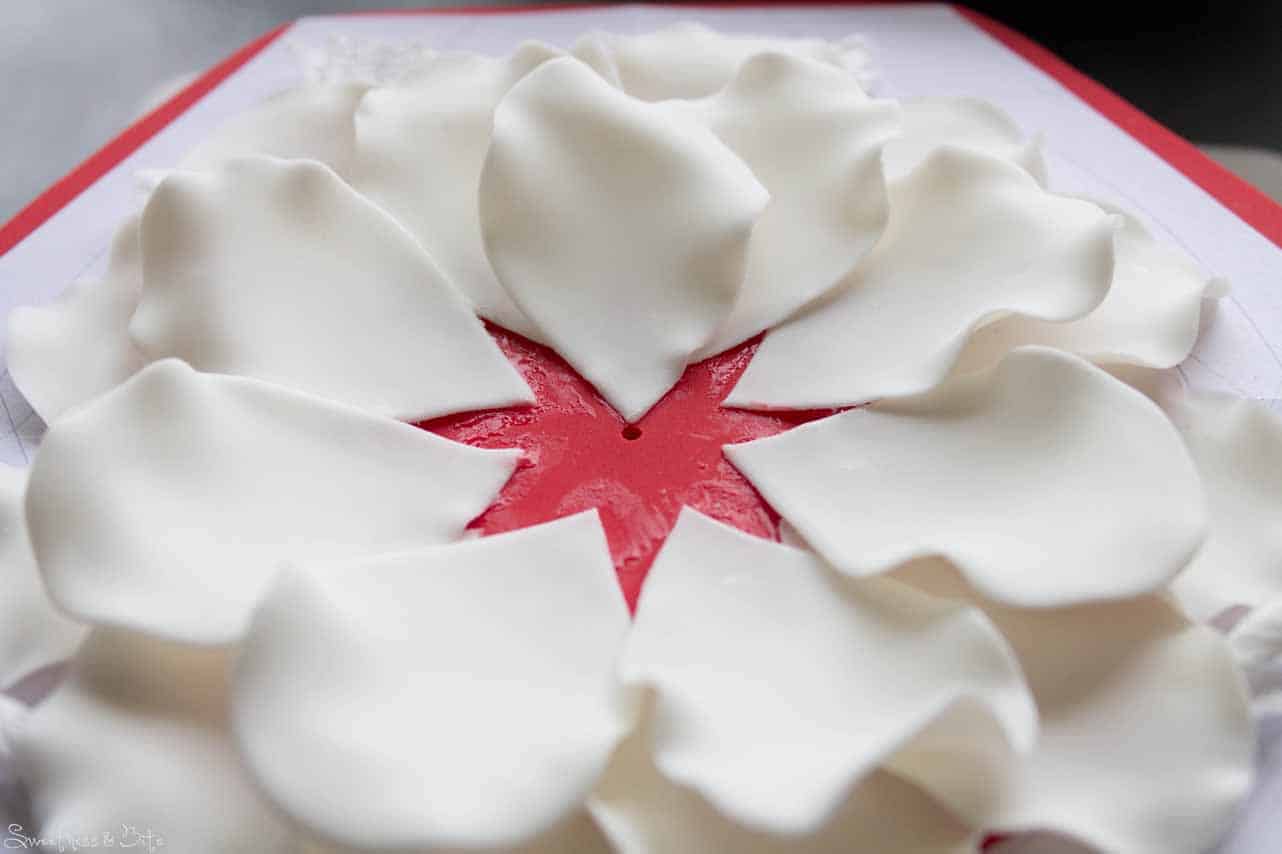
*
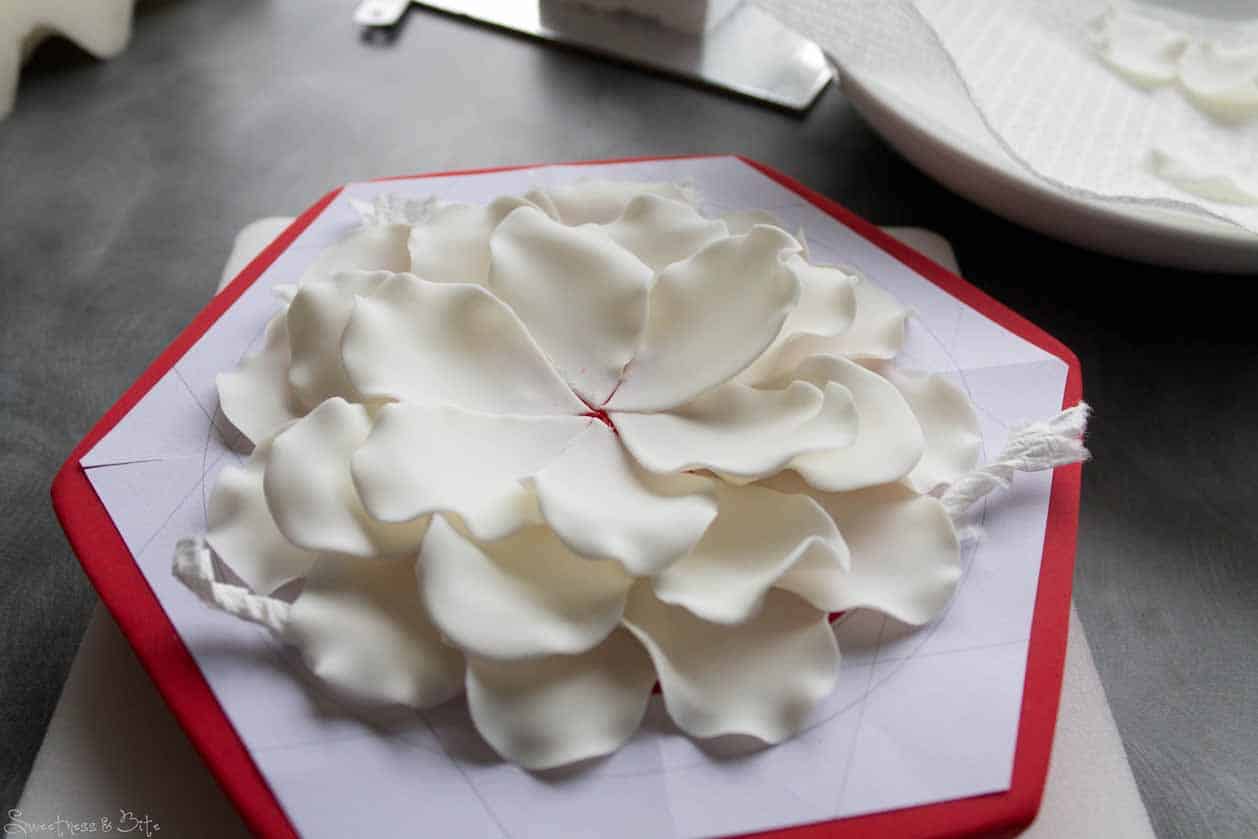
Take your dry-ish rose, and add one more layer of petals to it. Hang the rose upside down for a little while until those petals dry slightly.
Carefully trim the wire of the rose slightly shorter than the thickness of the polystyrene lid. Brush the centre of the petals attached to the lid with a little edible glue, and then very gently push the rose into the centre. Tweak the petals if you need to, using a paintbrush. Cut through the paper template with small scissors and gently slide it out from under the petals. Let the rose dry for a couple of hours or, ideally, overnight.
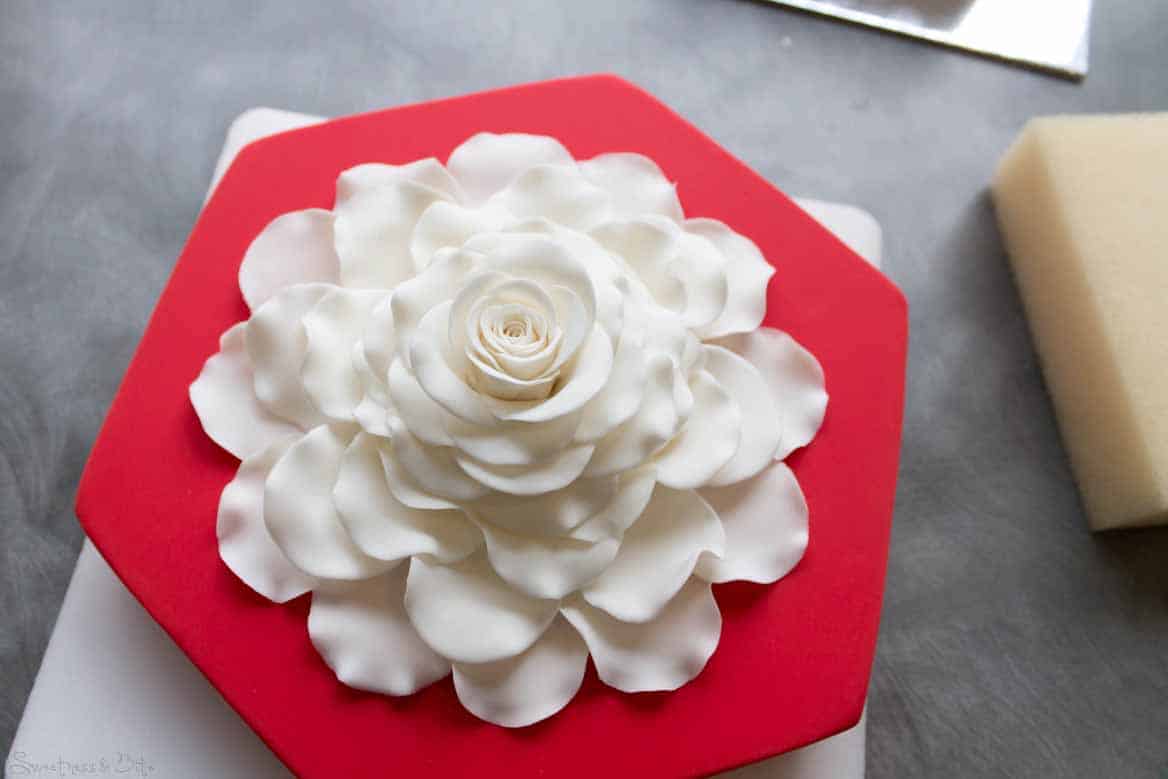
So there you have it, one chocolate box cake with rose lid….
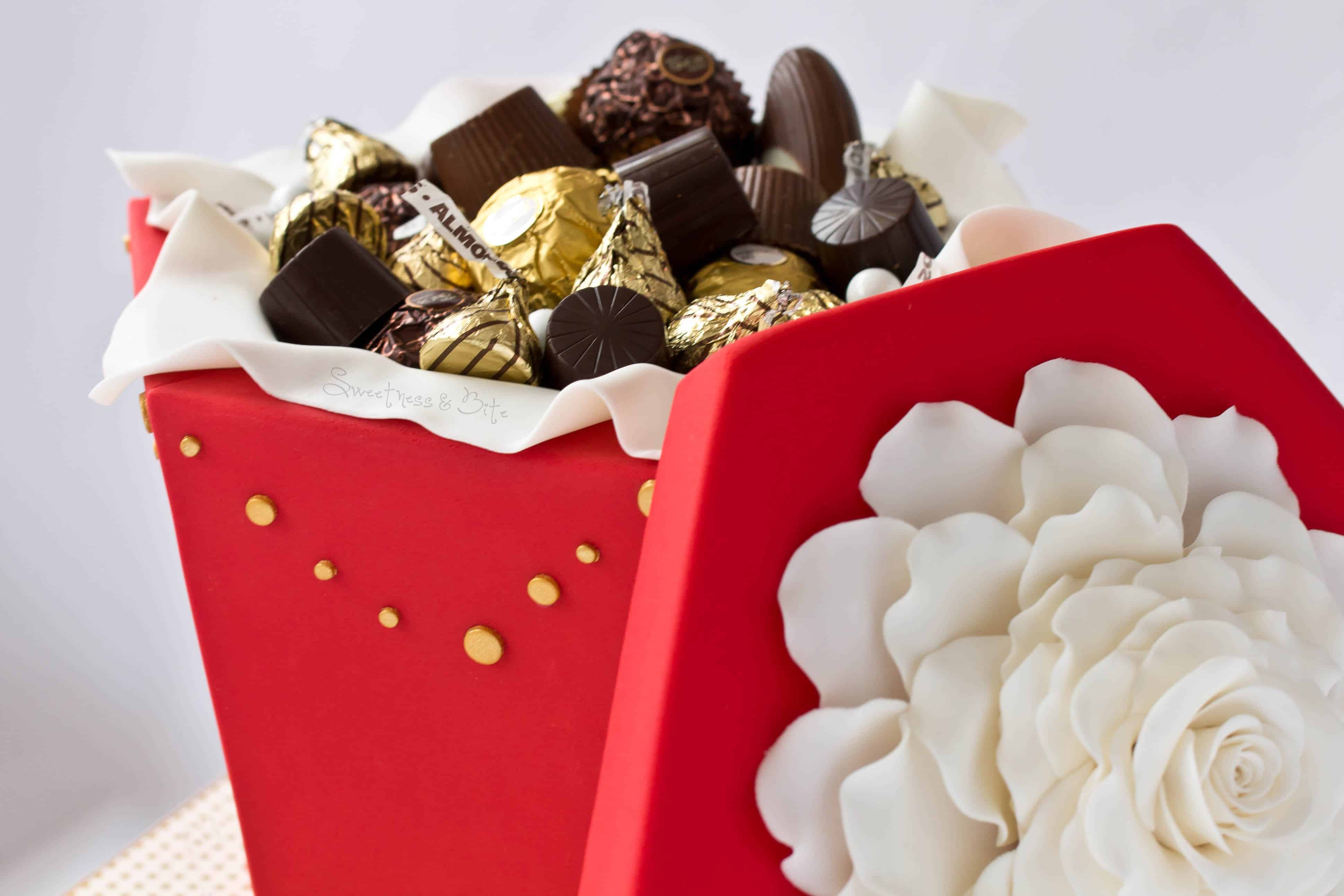
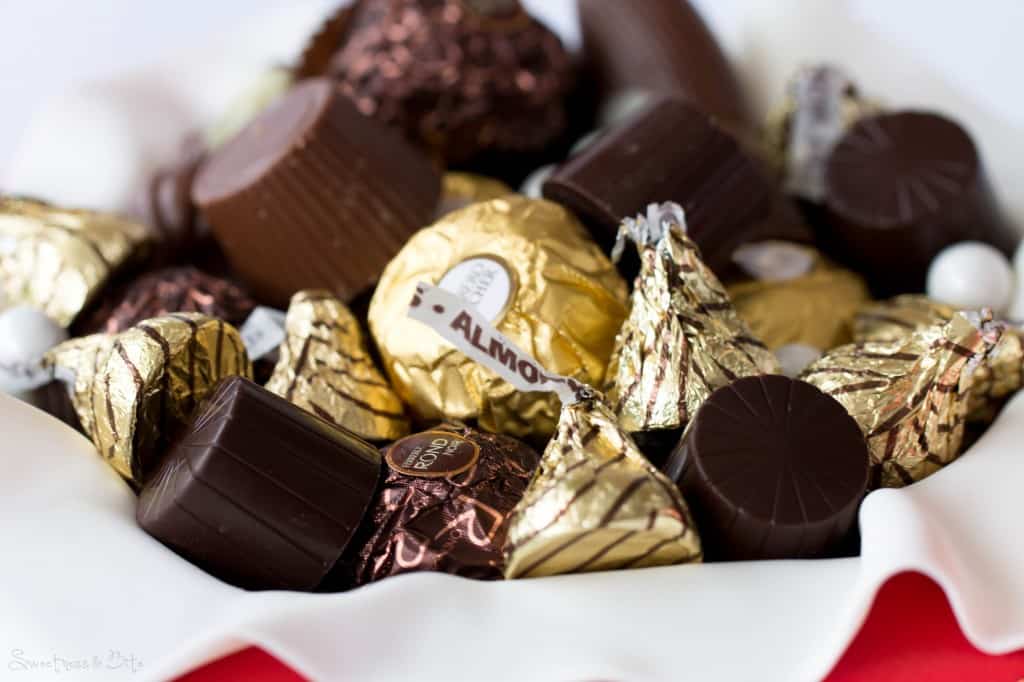
I filled the cake with almond kisses, Ferrero Rochers, Ferrero Rondnoirs, sixlets, praline seashells and praline filled dark and milk chocolates.
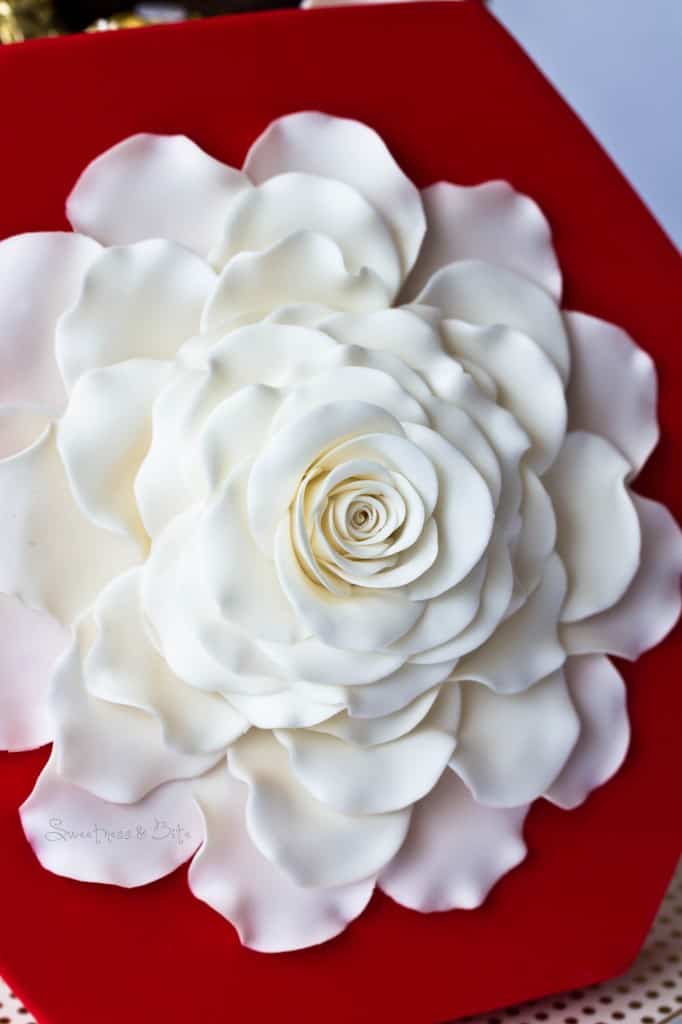
And here is my original cake from last year, made for my good friend Robyn, who has a love of junk food…
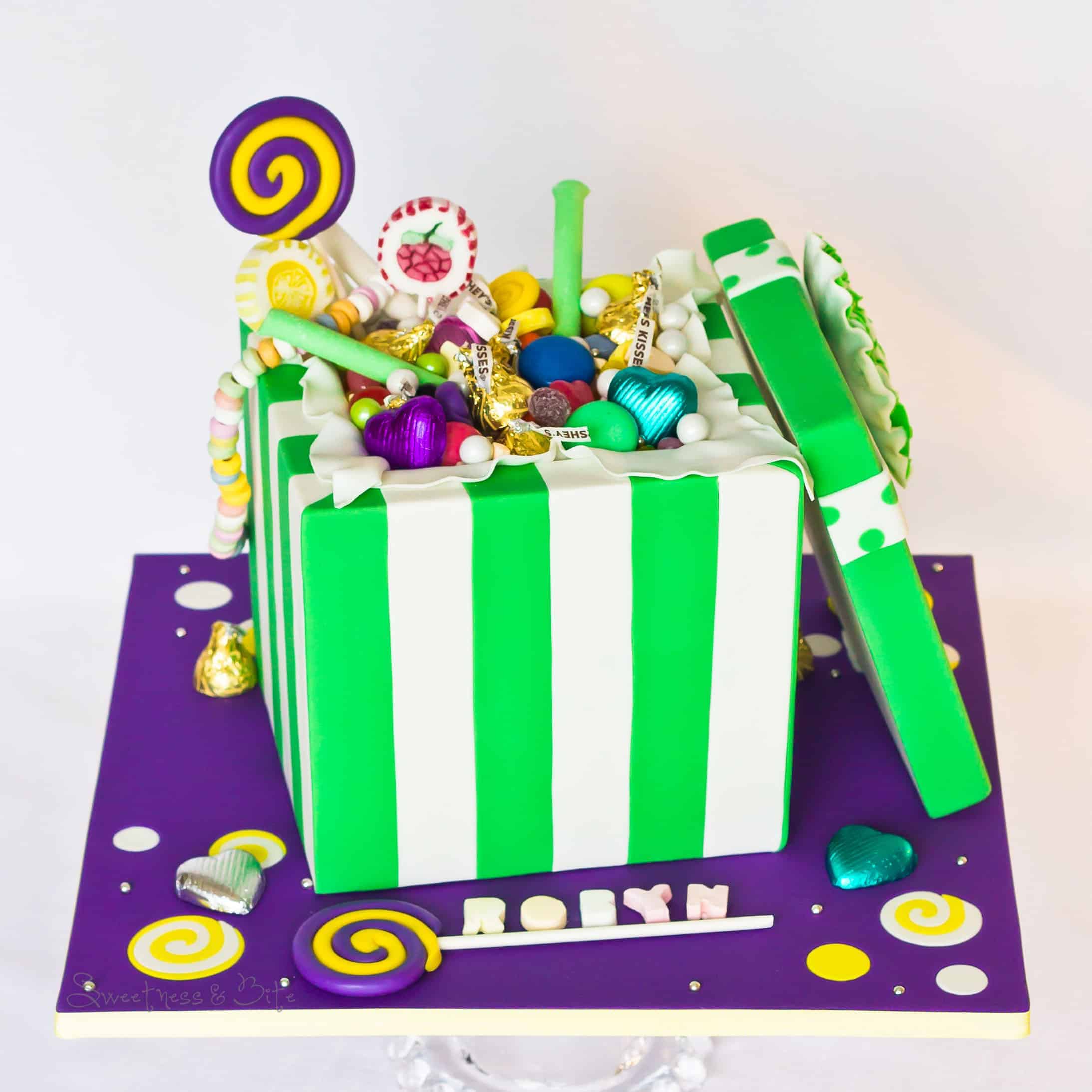
Cake filled with jelly beans, lollipops, chocolate hearts, Hershey’s kisses, jelly hearts, fizzy letters, fruit tingles, tiny jubes, giant smarties, green and white sixlets, candy necklace, spearmint & peppermint pencils, and handmade modelling chocolate ‘lollipops’.
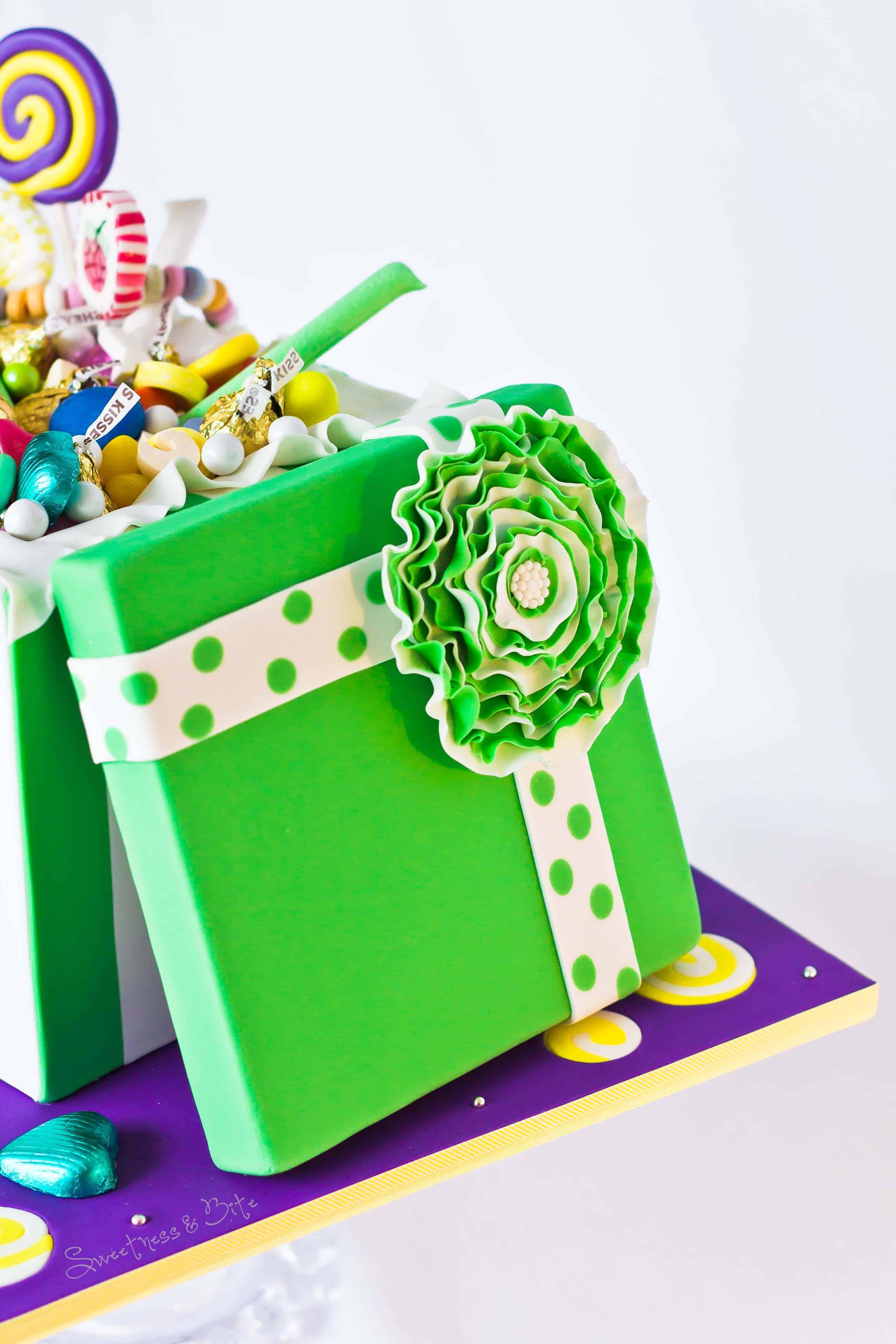
Happy caking, and if you have any questions, please leave a comment below.
~Natalie
